November 2024


November 2024

Flexible, reliable and easy to maintain:
Flexible, reliable and easy to maintain:
As a pioneer in agricultural technology, Vogelsang leads the way in environmental friendly spreading equipment. The dribble bar systems combined with the ExaCut distributor give the highest application of liquid manure nutrients.







Highlights from the Bath and West Showground
Pages 64-67

FODDER & FORAGE DAIRY SHOW REPORT
Special focus, including maize and alternative crops
Pages 54-63
As a pioneer in agricultural technology, Vogelsang leads the way in environmental friendly spreading equipment. The dribble bar systems combined with the ExaCut distributor give the highest application of liquid manure nutrients.
Dribble bars are available in working widths of 7.5m right up to 36m and are retrofit-friendly.
For more information visit www.vogelsang.info/en-uk/dribble-bar-systems
Dribble bars are available in working widths of 7.5m right up to 36m and are retrofit-friendly.
For more information visit www.vogelsang.info/en-uk/dribble-bar-systems
VOGELSANG – LEADING IN TECHNOLOGY
Contact us at: 01270 216 600 | sales.uk@vogelsang.info vogelsang.co.uk
VOGELSANG – LEADING IN TECHNOLOGY
Contact us at: 01270 216 600 | sales.uk@vogelsang.info vogelsang.co.uk

ANIMAL HEALTH
Tackling diseases in calves and parasites at housing
Pages 40-52
MILK PRICES
Pages 72-74
At NFU Mutual, we understand the unique opportunities and challenges that come with diversifying. Whether you’re exploring new ventures or enhancing your current operations, our local experts are here to provide tailored advice and comprehensive insurance solutions, so you can focus on what matters most.

Scan the QR code or search ‘NFU Mutual Farming Diversification’ to discover the latest trends, expert insights, and inspiring real-life success stories.

Editor Katie Jones 07786 856 439 katie.jones@agriconnect.com
Creative Services
Mike Begley
mike.begley@agriconnect.com
Katie Haydock katie.haydock@agriconnect.com
Picture Editor
Marcello Garbagnoli 07815 003 236 marcello.garbagnoli@agriconnect.com
Sales Gemma Thorpe 01772 799 500 gemma.thorpe@agriconnect.com
Account Manager
Mark Jackson 01322 449 624, mark.jackson@agriconnect.com
Classified Advertisements 01772 799 400 fgclassified@agriconnect.com
Advertising Production
Justine Sumner 01772 799 437 Fax: 01772 796 747 justine.sumner@agriconnect.com
Circulation and subscriptions 0330 333 0056 help@subscribe.farmers-guardian.com
Subscription rates: UK £65 a year Europe: £85 World: £95
ISSN 1475-6994
© Farmers Guardian 2024 All rights reserved. No part of this publication may be reproduced or transmitted in any form or by any means, electronic or mechanical including photocopying, recording, or any information storage or retrieval system without the express prior written consent of the publisher. The contents of Dairy Farmer are subject to reproduction in information storage and retrieval systems.
Dairy Farmer, Unit 4, Fulwood Business Park, Caxton Road, Preston, Lancashire PR2 9NZ
Origination by Farmers Guardian, Unit 4, Fulwood Business Park, Caxton Road, Preston, Lancashire PR2 9NZ. Printed by Warners Midlands, The Maltings, Manor Lane, Bourne, Lincolnshire, PE10 9PH. No responsibility can be accepted by Dairy Farmer for the opinions expressed by contributors.



This year marks the 95th anniversary of Dairy Farmer. And to mark this special moment in the history of the magazine, we have taken a look back at dairy farming over the last 95 years and have also asked some of our long-standing farming commentators and contributors to provide their views on how farming has changed for them.
In preparation for this edition, I was able to look back at some of the early copies of the magazine.
ere were some interesting regular features in those early years, including a ‘Vet’s Notebook’, a page dedicated to ‘Books for the Farmer’ and the ‘Diary of a Dairy Farmer’, which provided a very detailed day-by-day account of what that particular dairy farmer had been up to the previous month.
‘Herdsman’s Essays’. Readers were presented with a question, such as ‘how to handle the awkward bull’, and asked to write their response within 250 words. A selection of the best reader essays were published and there was a £5 cheque for the winning entry.
While the look and feel of the magazine will have undoubtedly changed over the last 95 years, the way that the magazine aims to put farmers’ views rst and foremost I hope still rings true.
My favourite feature, however, was the
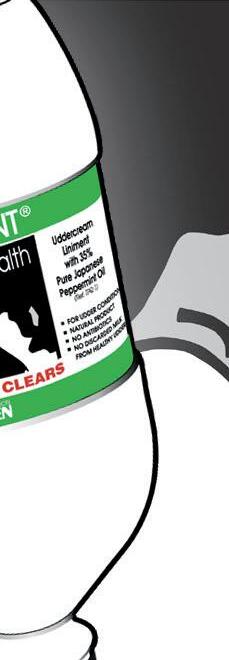

Some of the issues covered in those early editions are still relevant today, for example, there were articles on the latest equipment, animal health and nutrition, and even farm labour, with one article looking at whether farm sta should be entitled to living accommodation. e make-up of dairy farming in the UK may have changed considerably over the last 95 years, but the ambition to run e cient businesses will always be at the forefront.


















Farming Minister Daniel Zeichner sent out a letter to key stakeholders across the dairy sector at the beginning of October, outlining a proposed amendment to the new Fair Dealing Obligations (Milk) Regulations, to address the use of seasonality payment systems and volume bonuses in the dairy sector.
The wording of the letter

prompted concerns from unions over the lack of consultation, with calls for further ‘clarity’ on changes.
The Minister said his officials had informed him of ‘potentially unintended consequences stemming from the tiered pricing’ provisions in the regulations.
While these were designed to ‘protect producers’, they also aimed to preserve flexibility.
Some practices, such as season-
JThe NFU is ‘frustrated at the slow conversion rate’ from initial Sustainable Farming Incentive (SFI) applications being submitted to the agreements offered to farmers.
NFU deputy president David Exwood said while it was ‘encouraging that there were checks and balances to ensure the IT systems were working well’, the sector needed to get to a position where the ‘expression of interest’ process was removed and farmers and growers can expect an agreement offer ‘within weeks’.
Latest SFI figures from Defra as of September 30 showed that just under 13,000 expressions of interest, more than 3,500 applications and
800 agreements had been made.
A recent sentiment survey from Knight Frank’s rural division highlighted less than half of respondents who took part had signed up to SFI, with many farmers harbouring ‘preconceptions’ from past environmental programmes.
Agreement offers
A Defra spokesperson said: “We are rolling out the SFI with expressions of interest accepted, agreement offers being made, and over 1,000 agreements in place under SFI 2024.”
Defra added the rollout was being managed to ensure the service was working ‘as expected’.
A proposed amendment to the new Fair Dealing Obligations (Milk) Regulations, to address the use of seasonality payment systems has been outlined.

ality payments, which are based on historic volumes and volume bonuses, are, when used in exclusive agreements, prohibited by the regulations.
But he said he understood these practices as ‘mutually beneficial’ and there was ‘no desire to see them outlawed’.
NFU dairy board chair Paul Tompkins said he believed the letter was prompted by processor concerns.
He said he understood they needed to have processors which provide incentives and disincentives at different times of the year, but
what processors wanted was ‘exclusive’ rights over milk from a farm.
But he questioned why if processors were discounting spring milk as they did not want it, farmers could not market it elsewhere.
With the regulations carrying a statutory duty, any amends will require parliamentary time, with the Minister offering reassurance it would be undertaken in a ‘timely manner’.
However, Mr Tompkins was sceptical, adding parliamentary time ‘slips very easily’ and would
• High density concrete, steel and composite
• Capacities from 400 to 2500kg
• Sizes and add-ons to suit every need
• Long-life rubber coating on selected concrete units
• Integrated tool box designs
• Ultra-high density, space-saving steel weights


only create confusion for the sector. Ulster Farmers Union deputy president John McLenaghan said the union was ‘extremely concerned’, adding there was ‘absolutely no reason’ to limit farmers’ ability to market excess milk to a third party if their primary purchaser was discounting it.
Dairy UK chief executive Dr Judith Bryans welcomed Defra’s decision, adding these practices were ‘mutually beneficial’.
A Defra spokesperson said it was discussing an amendment with the industry and would provide more information in due course.


JAldi has said it will invest £30 million into dairy farming over the next three-and-a-half years through an enhanced partnership with Arla.
The enhanced partnership will run until the middle of 2027 and provide support to enable greater focus on sustainability and animal welfare through Arla’s FarmAhead Customer Partnership.
Through this programme, Aldi will partner in farming projects and innovation which aim to accelerate more sustainable farming practices and decarbonise dairy.
JWelsh researchers have been awarded funding of almost £1.2 million to develop a detector for TB in humans and animals which can report a result in one hour. The technology, which will be simple enough to be operated by any healthcare worker or vet, will be more specific than existing methods.









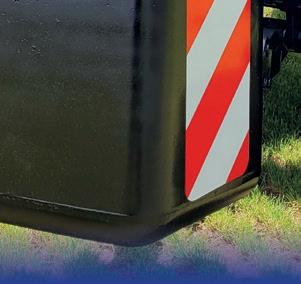











There is a clear message that the current UK Farm Assurance system ‘needs to change’, according to the NFU’s response to the UK Farm Assurance Review.
NFU president Tom Bradshaw said while the NFU response covers ‘some of the bene ts’ that farm assurance schemes o er, it also explains the ‘inescapable issues’ which must be addressed, including the perceived lack of value for money, the audit burden and the need for individual sectors to have a di erent approach.
AHDB identi ed four principles in its response to the review, which underpinned a scheme that was ‘ t for the future’, including purpose and value, governance, di erentiation and audit process. It said it recognised ‘signi cant visible and tangible change will be needed to win back hearts and minds’.
It shared analysis of some weaknesses, which included a ‘perceived dominance of retailers in the standard-se ing process’ which has resulted in a sense of ‘powerlessness’ among many users, adding there was a perception that with any voluntary bolt-on standard, it would lead to an ‘unnecessary standard creep over time’.
NFU Scotland director of policy Jonnie Hall said the union remained in support of the principles of farm assurance, but its members had made a ‘signi cant number of concerns’ clear.
Mr Hall said the commissioners

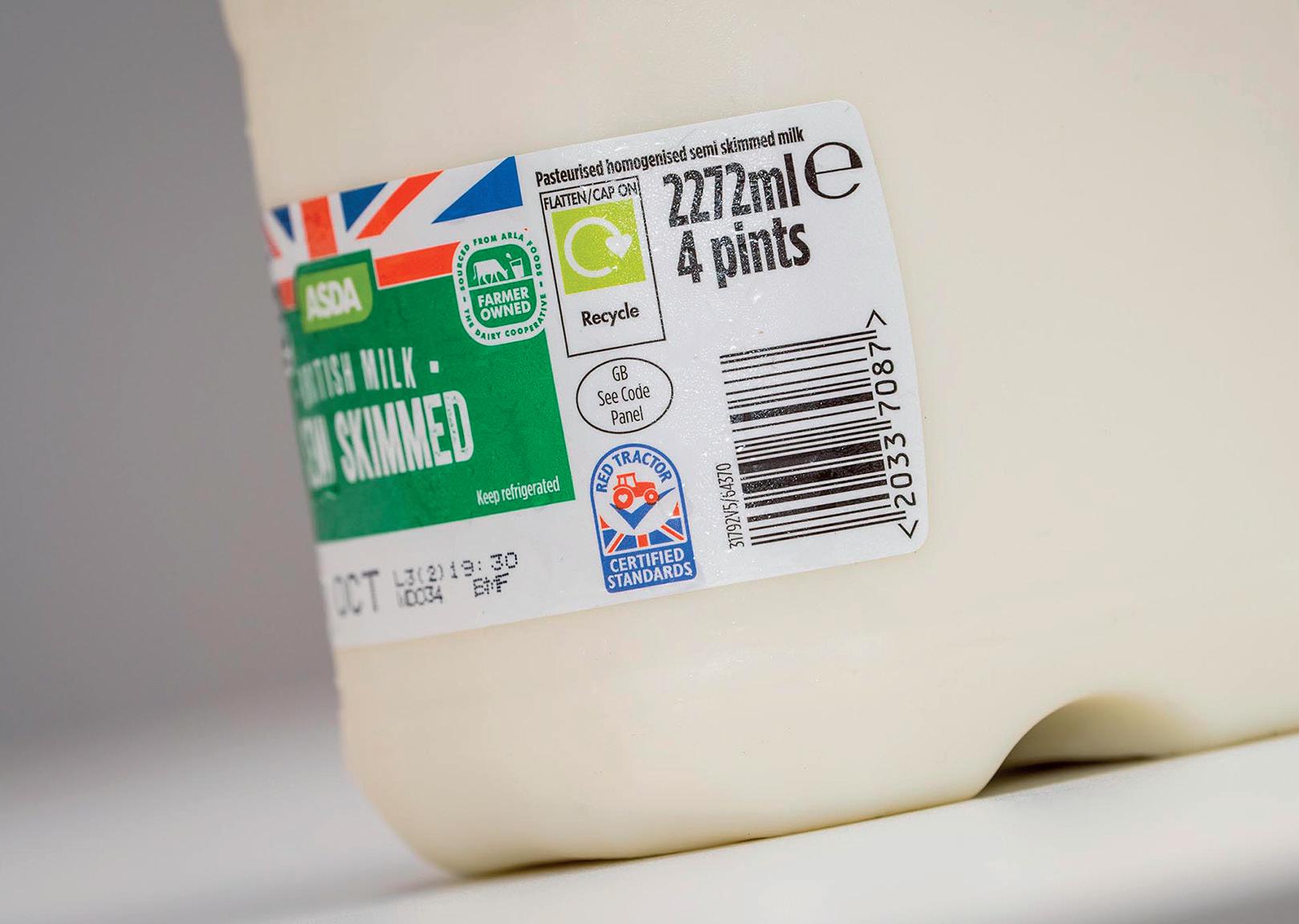

must make ‘clear recommendations’, which he said when adopted must ‘improve audit systems, utilise technology, rebuild trust, improve communications and introduce more transparency and accountability’.
Devon farmer and National Sheep Association vice-president Bryan Gri ths, who has
previously called for a ‘root and branch’ review of Red Tractor, said: “I am encouraged that two powerful and in uential ownership bodies have highlighted the shortcomings of Red Tractor and the ball is now in Red Tractor’s court to bring about the change that some of us have called for, for so long.”
In a ‘members ma ers’ newsle er sent to Red Tractor members in September, its interim chair Alistair Mackintosh said ‘it was listening’. He said: “ is is no empty promise. My primary focus as I take up the reins as interim chair is to rebuild relationships with farmers, growers and processors.”
JArla has launched a free milk ATM in London, allowing people to receive fresh milk at the push of a bu on.
It comes as the co-operative launched a nationwide initiative to ensure fresh dairy provision in food charities across the country. is comes a er insights revealed an estimated 450,000 people who rely on these schemes
do not have access to fresh dairy, with charities forced to decline donations due to a lack of storage facilities.
Arla is providing fully stocked and sponsored fridges to charities across the country, starting with the rollout of 100 fridges to FareShare charities.
It comes a er a study commissioned by Arla found that half of
adults could not imagine not having access to milk on a daily basis, with 76% consuming it at least a few times a week.
Meanwhile, 62% were not aware that not all foodbanks have fridges and therefore cannot store fresh dairy products, with 53% of the opinion that everyone should be able to easily get dairy-based foods.










Ben Yates manages Mells Park Estate, Somerset, where he oversees a 400-cow unit and manages the 405-hectare (1,000-acre) estate. Along with his wife and two sons, Ben has his own small herd of pedigree Holsteins under the Wowcow prefix. He joined the Holstein UK Board of Trustees in 2021.
“ As a family, we have been to several local shows where both our boys have enjoyed success in their handling classes
It has been a busy couple of months through our calving period, with 360 calvings in eight weeks. The team has achieved some excellent results, meeting the target of 120 heifer replacements, the British Blue calves have done well averaging over £200/calf at three weeks old at market and a mortality rate below 1.5%.
Random blood protein testing has seen everything achieving the highest grade, so colostrum management has worked fantastically.
The focus now moves to being ready to start serving on November 1. The reliance on Cow Manager will increase as this is the third breeding season with the technology in place. Our knowledge and confidence in the system increases year on year.
In the one dry week we had in September we did our last cut of silage which filled up the pits nicely. The maize is still to come in as I write this.
We have seen great success with our SAM3 herbal leys, which have yielded very similar to our conventional grass leys. As mentioned previously, we direct drilled into a few pastures that were starting to look thin, to try and regenerate them, which look to be coming along quite nicely.
Next season, we will start to run trials on our nitrogen usage to see how low on usage we can go to achieve the same yields.
The summer saw the team prep and lay over 250 cubes of concrete to finish the yards off, which will make a massive difference in the working conditions of everybody and, hopefully, the life expectancy of machinery.
This also led to a restructuring of the yard drains meaning we can very clearly separate clean and dirty yard water, and therefore are not filling our lagoon with excess rainwater.
Holstein UK’s two flagship events took place in September, both with great success. UK Dairy Day celebrated its 10th Anniversary and saw a tremendous National Holstein Show, with a fantastic final lineup in the championship that showcased the quality of Holsteins in the UK.
I thoroughly enjoyed the whole event and the trade stand spaces were full and welcomed plenty of footfall.
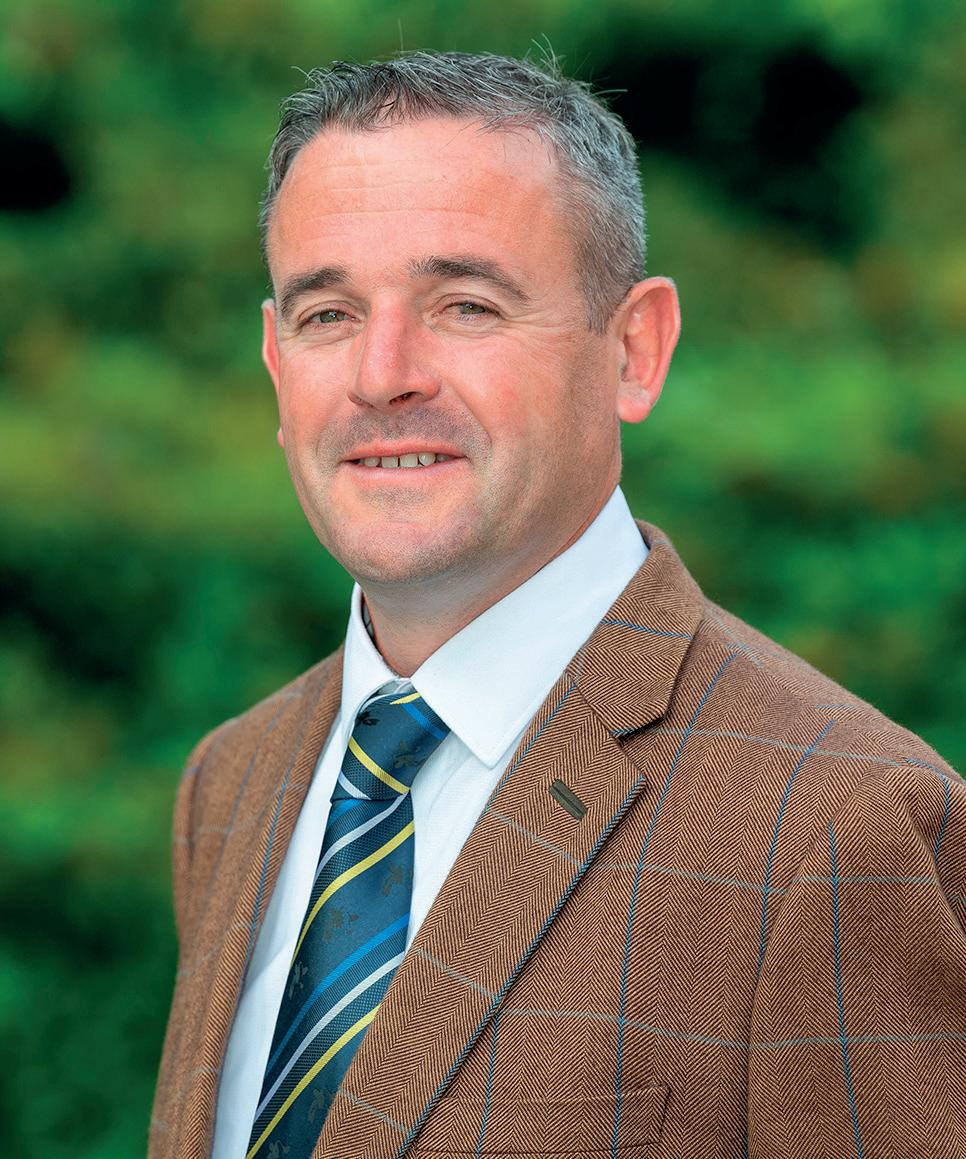
There was a real buzz and great optimism within the industry at the show.
The All Breeds All Britain Calf Show took place 10 days later at its new venue, Staffordshire County Showground. For this, HYB clubs and young dairy enthusiasts from all over the UK come together to compete in the handling and calf classes.
It is always a fantastic event where the standard of competition is at its highest, and it is great to see young, like-minded people of different ages work so well together, with the youngest learning from their peers.
As a family, we have been to several local shows where both our boys have enjoyed success in their handling classes. The highlight for me has been seeing our homebred heifer, Wowcow Lambda Roza, winning supreme champion at our most local show, Frome Show, and going on to win reserve inter-breed champion heifer at The Dairy Show, at Shepton Mallet.
The rugby season has started in earnest, apart from a delay for my eldest son who broke his arm in the summer, so he’ll have to wait a few more weeks to get back on the field.
Claire Eastham farms with her husband Martyn in Dorset, where they milk 120 spring calving cows. After gaining knowledge and experience working for other businesses, the couple started their own dairy farming journey in 2015 by taking on a share farming agreement before progressing to their current county council farm.
“ For the first time, we had a flyer through the door from another milk buyer looking for suppliers
Compared to last year’s empty rate of 16%, this year’s figure looks to be 5%, with a couple of those as rechecks. We’re hoping it’s right.
All heifers are also in-calf, and we didn’t make the mistakes of last season when we pushed the cows too hard in the wet weather and they’ve held good condition this year.
We also vaccinated for IBR, so if the results are right, this is definitely something which will be worth continuing.
After much concern that we missed the last good weather window, we finally made the last of our bales on October 5, boosting the winter forage stocks.
We have been feeding palm kernel to extend the supplies and it has also given the milk solids a huge boost, with today’s results of 6.37% butterfat and 4.3% protein.
We even went slightly over forecast this month (for the first time ever) and had some additional litres on the AMPE price.
With the milk price increases of late, this will see our average October milk price at about 58ppl – meaning we are very happy with Barber’s, our milk purchaser.
For the first time, we had a flyer through the door from another milk buyer looking for suppliers, which can only be a positive sign for the industry.
Historically, I used to think that dairy and faming as a whole seemed to operate in ‘boom-bust’ cycles of seven years, but these now seem to be much shorter – perhaps on a two- to three-year rotation.
We all need to be aware of this, as having a buffer brings some resilience to the business and minimises the impact of stress after one bad PD session or a wet season.
I feel that over the past three years or so, more and more businesses have worn away this resilience buffer. Some of this is undoubtedly due to things such as Basic Payment

Scheme reductions, but it is also a sign of the more global markets we operate in and how a conflict in the Middle East can affect our operating costs. Something we will all have to pay for on the shelves.
At the South West Dairy Dinner, Richard Clothier was the speaker and spoke about how dairy products have passed the 1,000-year test for human health – a sustainable, healthy whole food, which many of today’s seed oils and processed items will not.
This is something I think the dairy industry should be shouting more about. There is a gap in the market for this to be monetised. Many people in their 20s seem to be ultra-aware of processed foods, and influencers are selling the virtues of whole foods, whole fats and the fact we were so easily sold mistruths in the past around what we eat.
It is looking like the food system might be slowly going full circle. Even the high street is returning – with consumers turning against high postage costs and missed return dates. If we’re lucky we might all have a grocer, a butcher and a baker shop too.


The [cows] must be looked after with attention to detail if they are going to achieve their potential


ANDREW LEGGOTT
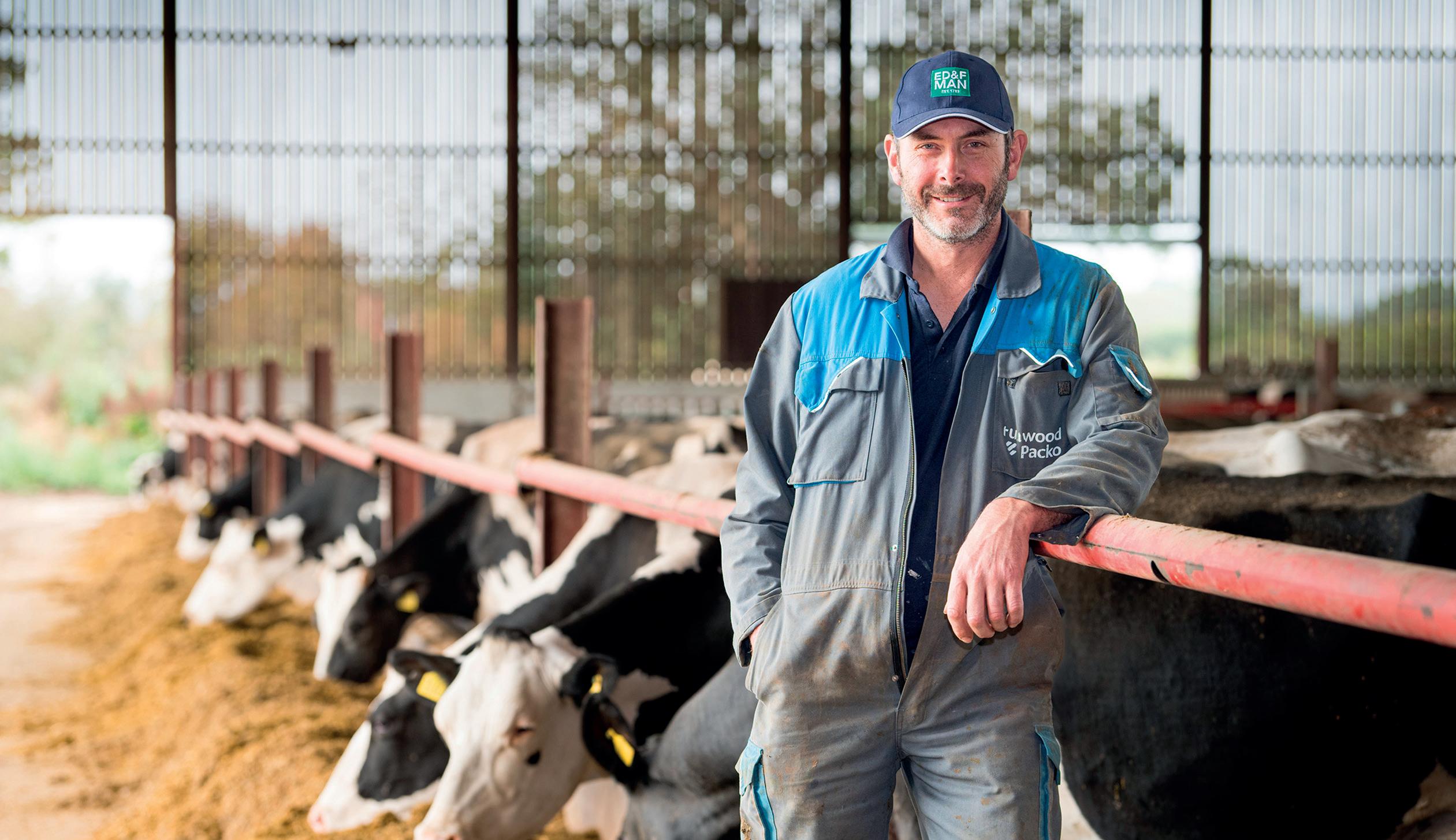
Following significant investment in his family’s dairy farm, Andrew Leggott is now focusing on achieving small improvements in efficiency. Wendy Short reports.
The rst robotic milkers were installed at White House Farm, near Northallerton, in 2007.
Back then, Andrew Leggo , who runs the family farm in partnership with his wife Sarah and his parents George and Barbara, purchased three second-hand robots to milk the 150-170 cows that made up the Cocklewood Holstein herd.
Andrew says that at that point the parlour needed replacing, and it was thought that a robotic system would li yields and reduce labour. Since then, there has been further investment into robotic milking.
He says: “By 2019, the farm was at a crossroads and we were looking at herd expansion. is led to the purchase of six new Fullwood Packo M2erlin milking robots.
r113 hectares (280 acres) of land farmed
rA calcium binder has been added to the diet in the runup to calving for the past 18 months to help reduce cases of sub-clinical milk fever/ retained cleansings
“Grant aid was available, but unfortunately my application was unsuccessful. Another installation was added in 2021, and a second went in the following year.”
Cow numbers now stand at 420 and the all-year-round calving herd is milked via eight robotic machines.
rTwo weeks before calving, cows are also given a slowrelease bolus for protection against ketosis
rRumen-protected choline has been another useful measure for improving transition cow health
e herd has a 13,000kg yield average at 4.1% bu erfat and 3.3% protein, with the average number of robot visits standing at 2.9 per cow.
Andrew says the family has ‘no regrets’ about switching to a robotic system, and now his goal is to breed a ‘balanced’ cow via a sire selection programme.
“Our interpretation of a balanced cow is one with plenty of chest width and body depth,” he says.
“A balance between type and production is needed, and the customised index identi es bulls that best suit our system.”
e farm was one of the rst to utilise sexed semen in 2004, and the
ca le are genomically tested, with genomic bulls rst trialled in 2018.
e herd has a pregnancy rate of 34%, with a 50% conception rate and 70% submission.
To aid heat detection, cows are ed with activity-recording pedometers.
Females failing to get in calf a er two services receive Aberdeen-Angus semen, and heifers are calved at 23 months.
“Good results were achieved with sexed semen from the outset,” says Andrew.
“ e initial recommendation was to limit sexed semen to the maiden heifers, but it was extended across the herd as I grew in con dence. It produces 90% female calves.



“When I was in my late teens, the 10-day-old black and white bull calves that I took to the local auction mart were worth £200 apiece.
“Times are very di erent nowadays, but fortunately a local farmer collects the young beef cross heifers and bull calves for rearing. I have asked whether I should use sexed
beef breed semen to produce only bull calves, but the buyer is happy to accept mixed sexed batches.
Genomics
“Genomics o ers a number of advantages, especially in terms of milk constituent levels and general herd health. I believe that it is one of the

keys to the future of dairy farming, as it represents an opportunity for ge ing more for less.”
e original Cockleton herd was established by Andrew’s grandfather, George, in the 1950s. Andrew describes him as ‘forward thinking’ – he started using embryo transfer soon a er its launch, with


the emphasis on establishing a solid foundation through the breeding of high-quality cow families.
Originally comprising British Friesians, the Cocklewood Holsteins pre x was registered in 1989. e farm’s expansion plan has reached its target, which is limited by place numbers in the dry cow and
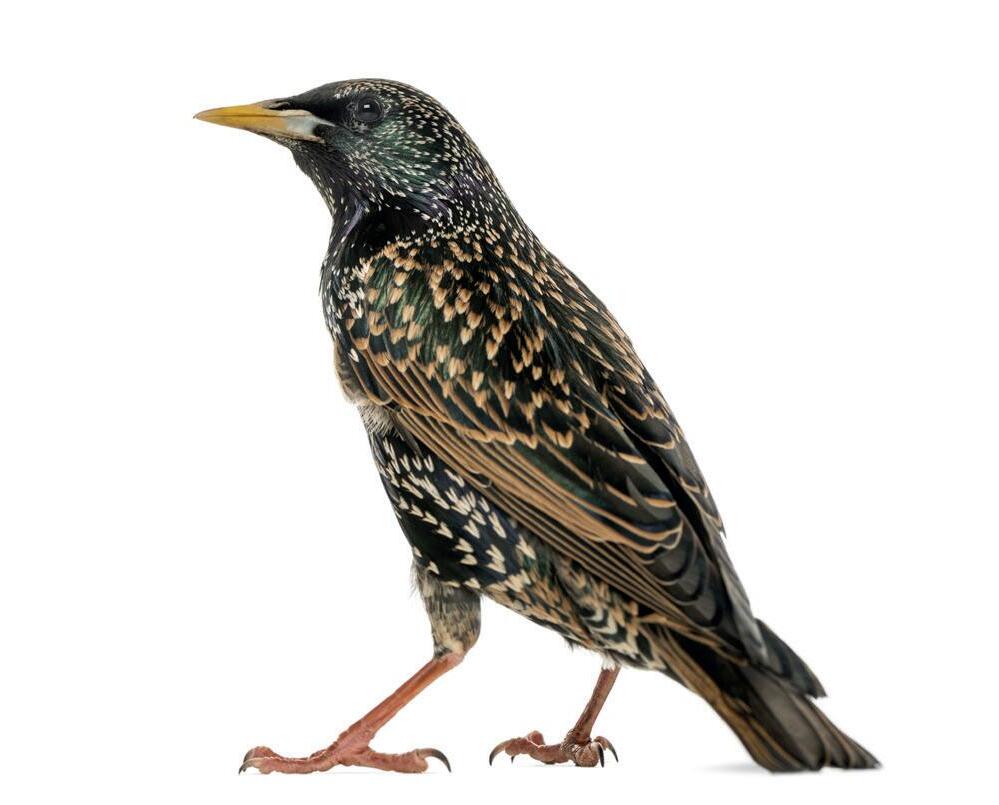





calf housing. By next spring, young heifers that are not required for breeding will be marketed privately.
Grass and maize silage and rolled wheat form part of the 16-17% protein total mixed ration (TMR) for lactating cows. e mix also includes soya meal and hulls, urea, Prairie Meal, dried distillers’ grains, molasses and minerals.
“My preference is for the cows to receive the bulk of their nutrition through the TMR, because it is better for rumen health,” says Andrew.
“ e feeders in the robots are used to tweak the diet to suit individual requirements. During lactation, the cows’ dung is si ed once a week to check for healthy bre digestion of the TMR. Visible grains or minute pieces of gut lining are two of the triggers that will prompt a review of the diet. Problems are minimal, usually occurring a er a change in silages.”
e unit grows 73 hectares (180 acres) of maize, with earlier varieties used on the more challenging land and mid-season types for more favourable sites.
e crop is usually cut at the end of September/early October.
It has traditionally been followed by a crop of wheat and then sown with a grass seed mix. However, the business has a contract with milk buyer Arla to supply Asda supermarkets, and a ‘greening’ incentive has recently been o ered.
erefore, an Italian ryegrass mix will be sown directly a er this year’s
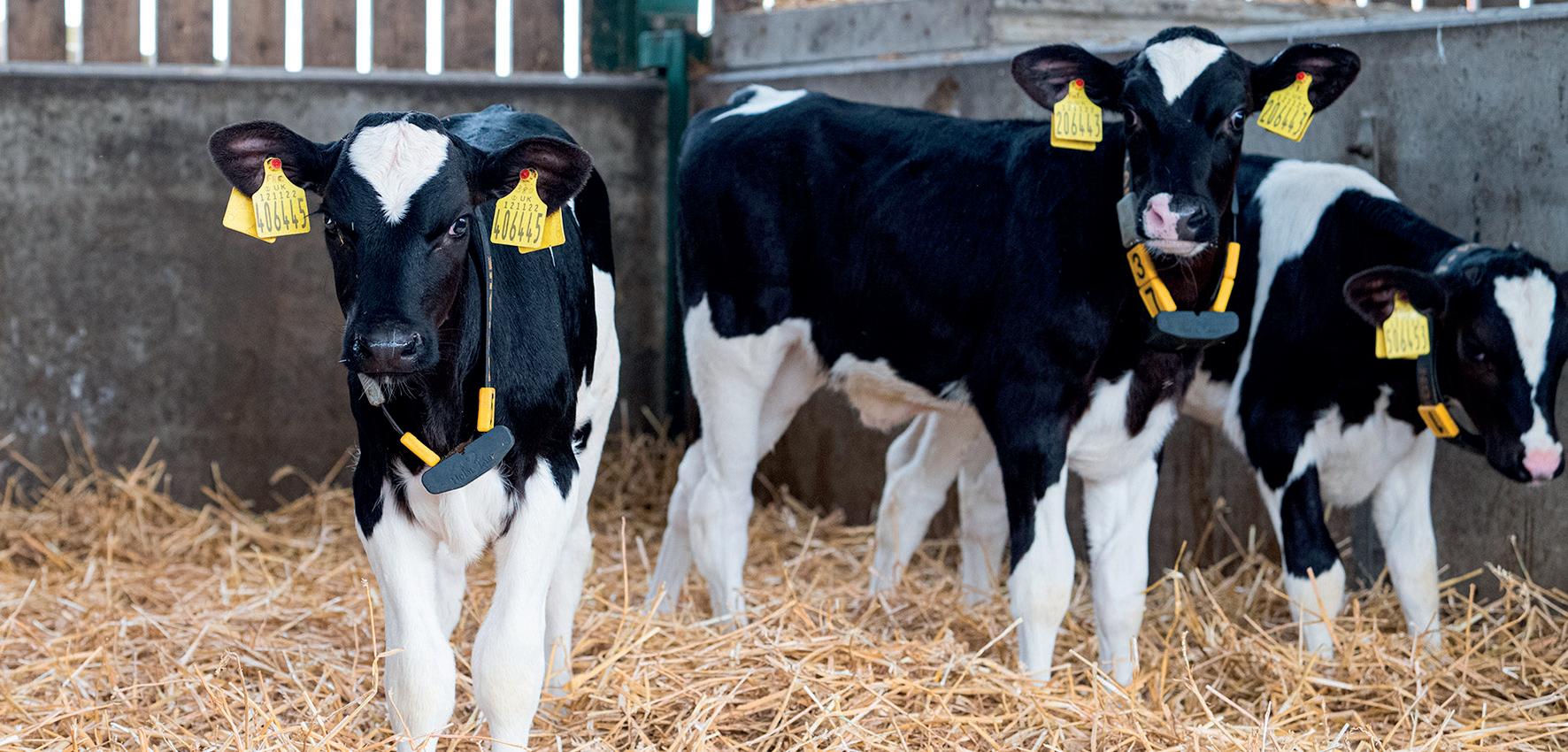

maize, with the designated elds put back into maize in the spring.
“ e maize crop has recovered well a er the cold, wet spring conditions,” says Andrew.
“I nd that a foliar nitrogen treatment at the row cover stage promotes growth and maturity, alongside the prior applications of slurry and farmyard manure.”
Five cuts of grass silage are taken annually, and a biological additive is used to enhance fermentation.
Andrew says: “It has been a good year for grass growth. e silage leys are down for two years and provide an excellent entry for the wheat.
“High straw prices have a ected the silage-making pa ern, and the time between fourth and h cut has been extended to reduce the nutrient
content for feeding the heifers. is may seem counterproductive, but it is cheaper to o er low-quality silage than to buy in straw. ey would lay down too much fat on ‘rocket fuel’ silage, with a negative e ect on fertility results.”
e herd is screened for Johne’s disease and vaccinated against BVD and IBR, with the calves vaccinated against pneumonia.
“ e calves have been coughing intermi ently and there have been a few cases of pneumonia, despite the vaccination programme. e roof opening is being widened in the calf house and there will be a new air vent tunnel, as well as an extension to the Yorkshire boarding,” says Andrew.
“Calves are not currently weighed, but a weighing machine might be the next purchase.
“It would be a more accurate way
of monitoring progress compared with a visual assessment.”
Assisted by the three full-time and two part time workers, Andrew says he will continue to review the herd management policy.
He says: “We have a good team at present, but it has not been easy to nd sta in the past. at is one of the reasons why I continue to strive for e ciency and to try and cut down on the workload, as well as making the day-to-day routine as pleasant as possible.
“ e breeding programme is centred on high-performing Holsteins, and they must be looked a er with a ention to detail in every aspect if they are going to achieve their potential. ere is some small capacity in the robots, but that will be lled through increased yields rather than future herd expansion.”

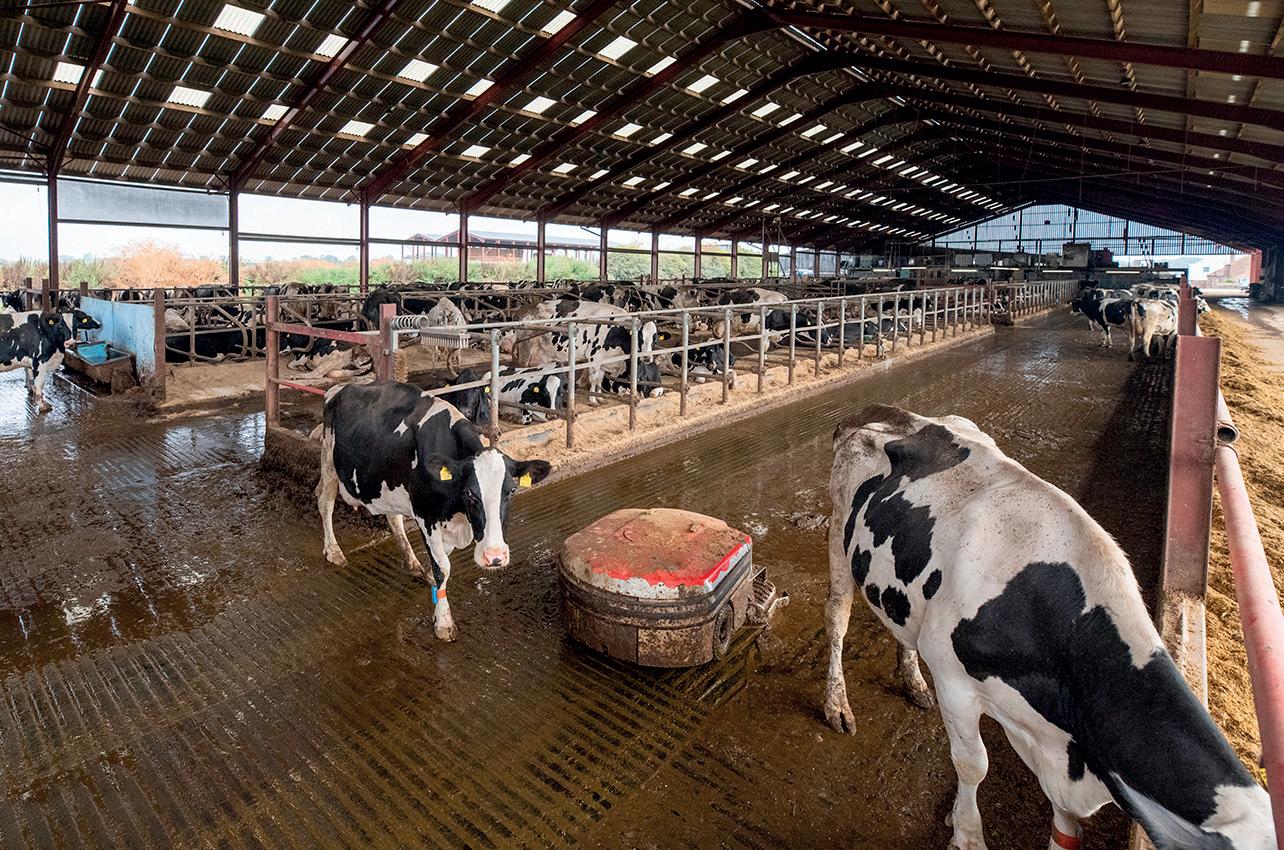






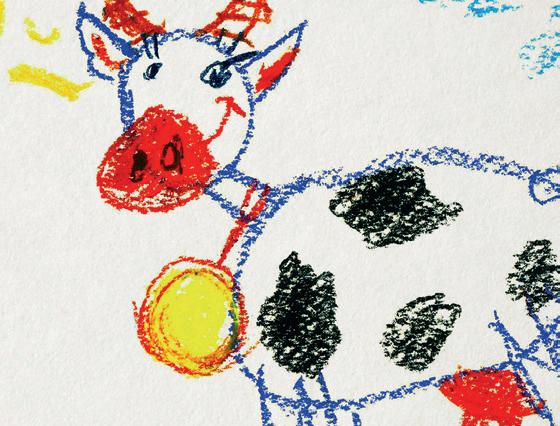
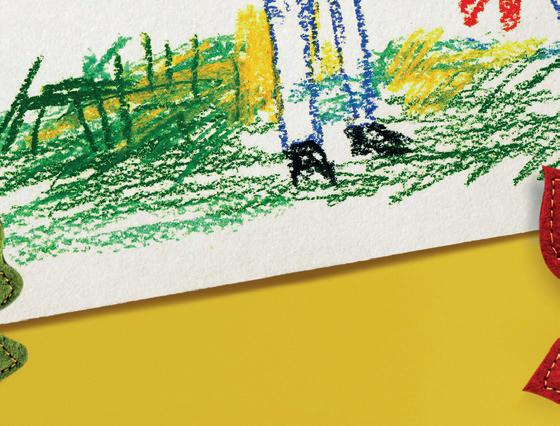








The sequential use of identical PI3 and RSV antigens in live and killed presentations, called a PRIME-BOOST effect, can optimise the immune response to two of the key viral pathogens associated with bovine respiratory disease (BRD).




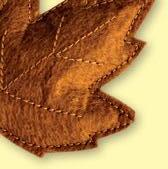
References: 1. Philippe-Reversat et al. (2017) Acta Vet BRNO. 86: 325–332 2. Metcalfe et al. (2020) Vet Record Open 7: e000429 3. Ellis et al. (2018) Can Vet J. 59: 1311–1319 ® our farm has the ha iest Cows in the world!





BOVALTO® is the ONLY BRD VACCINE RANGE which provides ALL of these benefits:
Efficacy proven by challenge studies1
A duration of immunity proven by challenge: 12 weeks for BOVALTO Respi Intranasal2
6 months for BOVALTO Respi injectables1


Intranasal efficacy against BRSV and PI3 unaffected by MDAs, providing the optimal start to immune protection against BRD2




Bovalto® Respi Intranasal, nasal spray, lyophilisate and solvent for suspension contains Bovine parainfluenza 3 virus (PI3V), modified live virus, strain Bio 23/A 105.0 – 107.5 TCID50 and Bovine respiratory syncytial virus (BRSV), modified live virus, strain Bio 24/A 104.0 – 106.0 TCID50. Bovalto® Respi 3 Suspension for Injection and Bovalto® Respi 4 Suspension for injection contain inactivated bovine respiratory syncytial virus, strain BIO-24, inactivated bovine parainfluenza 3 virus, strain BIO- 23 and inactivated Mannheimia haemolytica, serotype A1 strain DSM 5283. Bovalto® Respi 4 also contains inactivated bovine viral diarrhoea virus, strain BIO-25. UK:
Enables sequential use of identical PI3 and RSV antigens in different forms for rapid and long-lasting immunity3




POM-V IE: POM (E). Advice should be sought from the prescriber. Further information available in the SPCs or from Boehringer Ingelheim Animal Health UK Ltd, RG12 8YS, UK. UK Tel: 01344 746957, IE Tel: 01 291 3985. Email: vetenquiries@boehringer-ingelheim.com. Bovalto® is a registered trademark of the Boehringer Ingelheim Animal Health France, used under licence. ©2022 Boehringer Ingelheim Animal Health UK Ltd. All rights reserved. Date of preparation: September 2022 BOV-0108-2022. Use Medicines Responsibly.


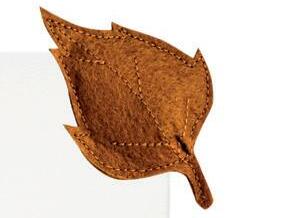
‘I am confident that we are finally on the right path’
NFU dairy board chair Paul Tompkins farms with his wife Rachael in the Vale of York. Not from a farming background, Paul worked in the financial sector before meeting his wife and joining the family dairy business.
Over the next five weeks, the NFU will be hitting the road to explain how the brand-new legislation governing the sector affects your business. The Fair Dealing Obligations (Milk) Regulations 2024 came into force in July and will change the way our industry works for the better. We want to help you understand the regulations and give you the opportunity to meet the farmers representing you nationally and regionally.
Earlier this year, more than a decade on from the NFU’s SOS Dairy Campaign, and the UK farming unions first calling out unfair practices and abuses of power in the dairy supply chain, the new legislation was laid in Parliament to ensure fair and transparent contracts for all dairy farmers in the UK.
Unfair and unbalanced milk contracts have long been a concern for the dairy sector. You will remember reviews in 2018 and 2020 by the Groceries Code Adjudicator and Defra finding an imbalance of power across the supply chain, believed in part to be caused by milk buyers having the power to set and modify the terms of a contract with often little notification. This led to huge amounts of uncertainty and ambiguity and enabled unfair practices to persist. This undermined those good relationships which do exist between milk buyers and producers and damaged trust across the supply chain.
The new regulations, a commitment set out by former Prime Minister Rishi Sunak at the Farm to Fork Summit last year, will establish transparency and accountability
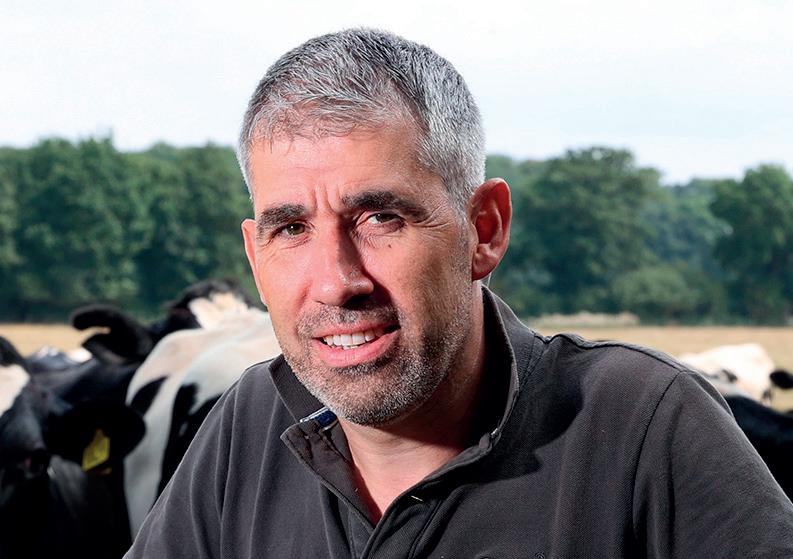
across the dairy supply chain by stopping contract changes being imposed without agreement. There will also need to be agreed procedures in place to enable farmers to independently verify the calculation and justification of variable prices. Importantly, the regulations also include an enforcement regime, backed up by the ability for the Secretary of State to impose substantial financial penalties in respect of any breaches. While progress has taken far longer than any of us hoped and expected, I am confident that we are finally on the right path to building a stronger, more resilient future for the UK dairy sector.
Notwithstanding the progress that is being made, the NFU believes that representative organisations, such as producer organisations, will continue to play an important role in helping farmers negotiate contracts within the dairy sector.
The new regulations offer processors who make the most from these farmer groups the ability to simplify their negotiations, while offering farmers collective strength and we will continue to support the development of representative structures like these to help improve trust and collaboration across the supply chain.
How will the legislation work, is a question I have been asked a lot over the past few months. There are several areas to consider including price, variation, farmer representation, exclusivity and notice periods:
JPrice: Prices will continue to be market led, but the legislation will introduce greater transparency. For example, if the contract contains a variable price, it can only be moved in reference to the agreed factors set out in the contract. Any change to those factors would have to be negotiated and farmers will have the power to challenge a price through an independent third party if they feel their milk buyer has not followed due process.
JVariation: All variations to the contract must be agreed by both parties. This means milk buyers cannot enforce changes without agreement from the farmer or their representative organisation.
JFarmer representation: Greater contract flexibility will be allowed where farmer-owner structures such as cooperatives and producer organisations, negotiate the terms of a contract on behalf of producers. The flexibility


“ Across the sector, there has been another round of milk price increases, taking some values to their highest since early 2023
allowed under the regulations may also make these structures more a ractive for processors to engage with.
JExclusivity: Non-exclusive contracts must be o ered where the milk contract demands a xed volume of milk.
JNotice periods: e legislation requires milk buyers to provide a minimum of 12 months’ notice if they wish to terminate a contract.
ere are several other areas covered in the regulations too, such as dispute resolution, force majeure, and the introduction of cooling-o periods.
e legislation also includes powers for the newly appointed Agricultural Supply Chain Adjudicator (on behalf of the Secretary of State), to oversee and enforce the code and impose nancial penalties on those in breach.
My predecessor as NFU dairy board chair, Michael Oakes, who was recently acknowledged for his contribution to British dairy farming at the 2024 Cream awards, played a huge part in seeing the regulation of dairy contracts over the line. e work that has gone into this has been incredible and dairy farmers everywhere owe Michael a huge debt of gratitude for being one of the key driving forces.
Across the sector, there has been another round of milk price increases, taking some values to their
highest since early 2023 and over the next few months market signals are that this will continue into the winter. is is encouraging but will need to be sustained to o er any sort of relief following a di cult year.
Talking to many of you over the past few weeks, I know con dence is still low as we contend with a range of issues such as the relentless wet weather, a lack of labour and the ongoing threat of bluetongue. ere are still plenty of opportunities though and as I have said before, the new contracts legislation is our chance to change the way the dairy supply chain operates.
e additional transparency and accountability introduced by these regulations will bene t the whole supply chain and provides additional certainty and con dence to farmers as to the terms under which you sell your milk.
As an NFU, we will continue to work alongside the other UK Farming Unions, with government and the wider supply chain to ensure this new contract legislation delivers not only for UK dairy farmers, but the millions of consumers that enjoy our climate-friendly and nutritious products.

Vaccination, tag testing and biosecurity are identified as key measures to preventing the spread of BVD across UK dairy farms. Katie Fallon reports.
One of the biggest diseases facing the UK cattle industry, infecting at least 27% of dairy herds in Wales, is BVD. A highly contagious viral disease transmitted from one bovine animal to another, vets David Staak and Sara Melo, of the Carmarthenshire-based vet practice Dyfed Vets, say the disease can have significant impacts on both youngstock and the milking herd. While buying-in infected cattle and mating with infected bulls can both be sources of infection, Mr Staak says infections are common among in-calf cows. He says cows are often infected with the disease during the first trimester of pregnancy, resulting in the disease being transmitted to the unborn calf in the womb.

The calf is then born as a persistently infected animal (PI), which will go onto shed a huge amount of virus into the environment and will usually not perform very well.
Ms Melo says PIs will go on to transmit the disease to other cattle in the herd and negatively affect the immunity of a group of calves around them.
She says: “Other calves will become infected with the virus for a short period of time, but they will not become PIs. It will lower their immune system and make them susceptible to other diseases, such as scour and pneumonia.”
While these calves will be transiently infected rather than permanently infected, the infection will usually occur while calves are still growing and are vulnerable to disease.
A lot of farmers tag test calves, and it is a good way of trying to eradicate BVD, because we know a PI will give birth to a PI again
DAVID STAAK
Therefore, significantly impacting their growth and performance.
Mr Staak says: “It is not always obvious which calves are PIs.
“Sometimes after a few months it can become obvious, but you could have PIs that carry on in the herd and you would never know.”
Indicators that calves might be infected with BVD include increased cases of pneumonia and scour, or calves not thriving.
Mr Staak says: “Sometimes you do go to a farm and see a calf that is a PI. It will look miserable with poor growth and condition and runny eyes.”
For herds with calves which are showing these symptoms, Mr Staak advises blood testing yearling animals between nine and 18 months of age, to see if a BVD infection is present.
He says: “Do not test calves younger than nine months as they could still have maternal antibodies in their system.”
When looking at BVD infections in adult cows, Ms Melo says if a PI cow makes it to the milking herd and gets in calf, its future offspring will also be born as a PI.
And while PI cows will go on to shed the virus into the environment infecting other cows, those cows will not become PIs and will only experience transient infection.
Mr Staak says: “It depends

on the stage of gestation, but in-calf cows infected with BVD will either give birth to a PI if infected early on in the pregnancy or will potentially abort their calf if infected later on in pregnancy.”
Adult cows infected with BVD will experience reduced production, poor fertility and increased susceptibility to other diseases such as IBR, leptospirosis, mastitis and mycoplasma.
To understand the level of exposure within a herd and determine antibody levels, Mr Staak advises carrying out a bulk milk test.
He says: “When testing for antibodies we are not looking for a PI, but we are looking to see if animals have been exposed to a PI. These animals will not be persistently infected themselves, but indicate that there could be a PI within the herd.”
Following this, Mr Staak says farms will need to carry out a ‘PI hunt’ to identify the PIs within the herd.
He says: “It might only be one animal, or it could be two or three. You can try and identify the infected animal by pool

For herds with calves showing BVD symptoms, youngstock should be blood tested to see if a BVD infection is present.

blood sampling in youngstock, testing milk from cows and pooling samples together to whi le it down into smaller groups and eventually identify the PI.”
Tag testing calves for BVD is also an e ective method of identifying PI calves to help eradicate the disease on-farm.
Mr Staak says: “A lot of farmers do this now, and it is a very good way of trying to eradicate BVD, because we know a PI will give birth to a PI again.”
Ms Melow advises tag testing alongside vaccinating the herd. She says: “You are protecting the herd initially by vaccinating, then by tag and testing you are eliminating any new animals coming through.”
Although vaccination will not cure the PI ca le, it will protect the rest of the herd, alongside blood testing the dams of any new PIs identi ed through tag testing.
Mr Staak says calves can be vaccinated from around three months of age, but advises vaccinating bulling heifers before
rBiosecurity - only buy from BVD-free farms
rMonitoring – blood test five yearling animals annually
rTag and test calves
rVaccination
rPI hunt - identify and cull
going mating, as well as vaccinating in-calf heifers and cows annually.
He says: “Vaccination and tag testing are key to prevention.
“If you suspect you have a problem, I advise blood testing ve yearling animals in each management group each year to identify if there is exposure to the virus.”
Ms Melo says the sourcing of ca le is also important when buying-in replacements and advises sourcing ca le from farms which are BVD-free.
She says: “Biosecurity is critical because you could have a herd that is BVD-free, but you buy-in one PI and it could be a disaster for the herd.”

By providing class-leading levels of heat detection accuracy and clear guidance on when individual cows and heifers should be inseminated, the SenseHub Dairy herd monitoring system from MSD Animal Health enables herd managers to optimise their herd’s fertility performance.

SenseHub Dairy uses electronic neck collars and/or eartags to constantly monitor the subtle behavioural and activity patterns associated with the various stages of the fertility cycle of maiden heifers and cows.
In doing so, it accurately and reliably detects 95% of heats, including silent and weak heats.
Whenever a heat event or potential problem with the ensuing gestation is detected, the SenseHub app automatically sends an alert to key members of staff so an informed breeding decision or medical intervention can be made as quickly as possible.
The SenseHub app also highlights the optimum time for insemination to take place, with separate guidance provided to maximise conception rates from sexed or conventional semen.
This unrivalled heat detection accuracy, along with SenseHub’s ability to filter out any false heats, eliminates the guesswork from artificial insemination
(AI) timing and contributes to improvements in first service conception success and subsequent pregnancy rates.
It also eliminates the need for staff to make visual observations to spot bulling cows and heifers, and reduces AI and semen costs.
SenseHub’s clear and simple to understand charts and graphs can be shared easily and quickly with third party consultants – such as the farm’s vet or nutritionist – so any problems can be diagnosed and treated as soon as possible. This not only reduces unforeseen fertility costs, but also helps to fast-track the herd’s genetic improvements by shortening the calving interval and reducing the number of open days.
The SenseHub system can also detect anoestrus cows, cystic cows and suspected abortions and can be used to monitor the health and well-being of cows during the transition period.
Calf rearers should look at all areas of calf management and disease prevention to help control problems with cryptosporidiosis in calf sheds. Katie Jones reports.
With calf cryptosporidiosis the most common cause of infectious scours in the UK, it is important that calf rearers are looking at all the ways they can control this issue on-farm.
And to help achieve this, a five-step action plan has been released alongside a new vaccine.
The action plan, which was developed by MSD in conjunction with Moredun, looks at five areas: diagnosis, colostrum, environment and management, prevention, and treatment.
Speaking during a recent press briefing, Dr Kat Baxter-Smith of MSD Animal Health said that the tool would allow farmers and their vets to explore, record and score performance across these five key control areas.
She said: “For each of the areas, there are a series of questions which farmers can answer and
rCaused by the protozoan parasite cryptosporidium parvum, and is now the most common cause of infectious scour in the UK
rCauses intermittent scour, loss of appetite, dehydration and weakness
rOnly five oocytes are needed to cause infection, but millions of oocytes are excreted for seven to 10 days at the peak of shedding
rThe disease is widespread and found on more than 90%
It is vital we use diagnostics to identify the likely cause or causes of scouring
score themselves on. The scores are added up at the end, and the results will help highlight the areas where focus is needed.”
The first area is diagnosis, and Dr Baxter-Smith said accurate diagnosis was the first step towards better disease control of any cause of infectious scour on-farm.
She said: “It is vital we use diagnostics to identify the likely cause or causes of scouring. Calf-side testing is a rapid option to help identify whether the most common scour-causing pathogens
of GB farms, and is shed by adult cattle as well as calves
rThe condition is mostly seen in calves seven to 14 days of age, but can strike anytime and is prevalent throughout the year
rIt is a zoonotic disease. There are 3,000-6,000 UK lab-confirmed cases a year, but this is likely to be much higher. A significant number of these cases can be linked to contact with animals and to farms which open their doors to the public

including cryptosporidium parvum, rotavirus, coronavirus or E.coli, are involved. Further lab testing could be required if it is suspected there might be other causes, such as coccidia and salmonella.”
The next area is colostrum and Dr Katie Denholm, an academic clinician at the University of Glasgow Veterinary School, reminded farmers about the importance of the ‘five Qs’: quality, quantity, quickly, quietly and quantify.
She said: “If calves fail to ingest an adequate quantity of quality colostrum, there will be huge implications for the calf. These calves will not grow as they should, they will

not conceive as well or produce as much milk.”
And she added that recent studies suggested there were benefits from feeding high-quality colostrum for longer. A recent survey of 248 farms across England, Wales, Scotland and Ireland found that three quarters of respondents said that if it was shown that feeding colostrum beyond day one was beneficial, they would do it.
Dr Denholm said potential benefits of feeding colostrum for longer included increasing calf serum immunoglobulin concentrations, reduced antimicrobial use, increased immune protection for specific dam vaccinated pathogens, the promotion of sound intestinal villi development, reduced calfhood morbidity and mortality, and the improvement of reproductive and lactation outcomes in later life.
She added that while there could be barriers to adopting this approach, there were a number of ways to supplement colostrum feeding – for example, adding two or three large ice cubes of frozen first milking colostrum into milk replacer feeds or adding 40-70g of a colostrum replacer to milk replacer.
“This liquid gold also contains immune modulators such as oligosaccharides, valuable enzymes, lactoferrin, cytokines, hormones, vitamins, and minerals – all of which are important for long-term gut health, function and development,” she said.
She also said the benefits of feeding transition milk (the milk from milkings two to six) should not be overlooked, and suggested feeding this transition milk for the


rst three to ve days or mixing transition milk into pasteurised milk.
She said: “Transition milk contains a greater concentration of bioactive compounds compared with whole milk.”
e third area on the ve-step action plan is environment and management, and Dr Baxter-Smith said farmers traditionally did not score well in this area. Issues within this area could include the mixing of di erent age groups of calves, poor hygiene around the cleaning of equipment and not replacing straw bedding o en enough.
e fourth area is prevention,
and this is where MSD’s new vaccine, Bovilis Cryptium, comes in. is is the rst ca le vaccination against crypto parvum, with pregnant heifers and cows receiving the vaccination in late pregnancy to provide protection for calves from birth at the start of colostrum feeding.
rInfection with the parasite causes blunting of the intestinal villi, reducing capacity for nutrient and water absorption. This has a significant impact on a calf’s future productivity
rIn a recent UK study, cryptosporidiosis in the first
Dr Baxter-Smith said: “ e protection of calves depends on adequate ingestion of colostrum and transition milk from vaccinated cows. It is recommended that all calves are fed colostrum and transition milk during the rst ve days of life. At least three litres of colostrum should be fed within the rst six hours a er birth.”
16 days of life significantly reduced weight gain over a six-month period, with severedisease calves weighing 34kg less on average than low-disease calves. This equated to a £161 reduction in the calf sale price
e nal area is treatment, and Dr Baxter-Smith said that even if all of the other steps were done well, there could still be calves that required treatment.
She said: “Calves with diarrhoea are o en dehydrated. erefore, oral rehydration therapy should start as soon as scour is observed and continue for at least 48-72 hours.”





Former UK sheep shearer, Will Hinton and his partner Kali Rangiawh have recently been named as New Zealand’s share farmers of the year. Chris McCullough reports.
Having spent most of his time travelling the world shearing sheep, UK-born Will Hinton has changed farming direction and is now milking cows on a share farming basis in New Zealand.
Will, who farms with his partner Kali Rangiawha, hails from Wiltshire where he grew up following the sheep shearing trail before travelling Down Under to perfect his cra .
It was while on this quest in 2017 he met New Zealander Kali, who had accrued a wealth of dairy experience. Before long their children, Rylan 6, Billy 3, and Blake 1, were born and roots were put down.
For the past 15 months the couple have been contract milking 350 cows on a 113-hectare (280acre) farm located near Fielding, in the Manawatu District on the North Island.
e couple have recently won the 2024 New Zealand share farmer of the year award.
Will says: “With several years of dairy experience, Kali was the key driver behind our contract milking business that we started four years ago.
“ e farm we are on now is owned by Tim and Victoria Gorton. is is their rst year owning a dairy farm so they have employed us to run it for them, while leaning on us for our experience.
“We milk 350 cross-bred cows twice a day through a Waikato milking system 54-unit rotary parlour.”
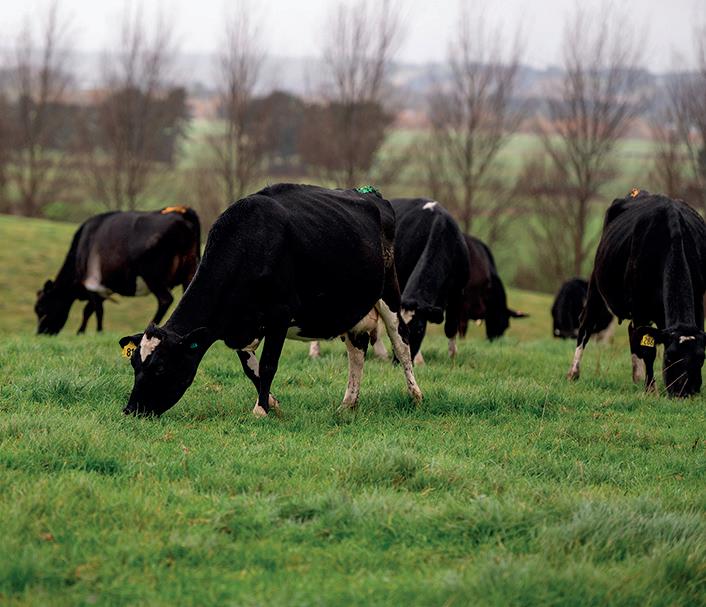


Kali also works as an AI technician for LIC and likes to run a tight spring calving system to match the grass growth on the farm.
She says: “Compact calving is very popular over here, run to match grass growth. We calve the cows from mid-July through to the end of September, with the majority calving in the rst six weeks.
“ ree major breeding traits that we are concentrating on include Breeding Worth, Production Worth and Lactation Worth.
“Breeding Worth is the genetic potential for pro table o spring as well as feed e ciency.
“Production Worth is the cow’s lifelong pro t-making ability. Our top PW cows receive sexed semen
and the bo om tier receives beef semen.
“And lastly, Lactation Worth reects on how pro table and e cient a cow has been within the current lactation.”
Will and Kali run the cows as a single herd grazing outdoors all year round. e mating season is kept at about 10 weeks, six weeks for AI and four weeks using a bull.
Operating a share farming model means costs have to be monitored carefully and this includes labour use.
Will says: “We run the farm ourselves, but this season we are employing someone so we can start training them up before we take our next step up in the industry of owning a herd.”
Will achieves 14 tonnes of grass per hectare, a total of 1,580 tonnes dry ma er, which accounts for 81% of the cows diet.
He also feeds a blend and uses 100 tonnes of maize as a transitioning tool in early spring, and as a condition builder late lactation.
He says: “We also grow summer crops, such as chicory, to complement the drop in metabolisable energy and crude protein in pasture, which helps us hold production levels.
“I am very passionate about feeding and the transition phase is crucial.
“It is very challenging here as pasture is a huge part of the cows diet and therefore it is hard to achieve a low DCAD [dietary cation-anion


rMilking takes 1.5 hours in the morning and one hour in the afternoon
rOver the past year, a record production of 443kg milk solids per cow has been achieved
rMilk is sold to Open Country and the price is about NZ$8.40 (£3.96) per kg of milk solids
di erence]. e DCAD is a particularly important measure used when formulating diets for dry, transition and lactating dairy cows.
“In the future, I would like some technology that tells me how well each cow is transitioning, as it would let me pick up subclinical cows a lot quicker.”
Will and Kali’s ve-year goal was to own 200 cows themselves, a target that could have been reached this year, but was pushed forward to


The herd is run as a single unit, achieving a record production this year of 443kg milk solids per cow.

ensure a good work life balance with three young children in the family.
Will says: “Our target has now changed to around 600 cows which we hope to purchase early in 2025.
“In the next ve years we would like to increase this to 1,000 cows and own a farm by 2034.
“It was amazing that we won the national share farmers of the year award, which is the top tier of the New Zealand dairy awards. is is a lifetime achievement for us and will




Scan the QR code to watch the Glycolac video
de nitely help us with some amazing opportunities going forward.”
And looking into the future, Will said there will be some tough challenges ahead.
He says: “I think the progression ladder is ge ing a lot harder in New Zealand. Farm ownership used to have a clear trajectory, but with in ation of farm working expenses, high interest rates and average milk prices, these all seem to be moving the goalposts further away.
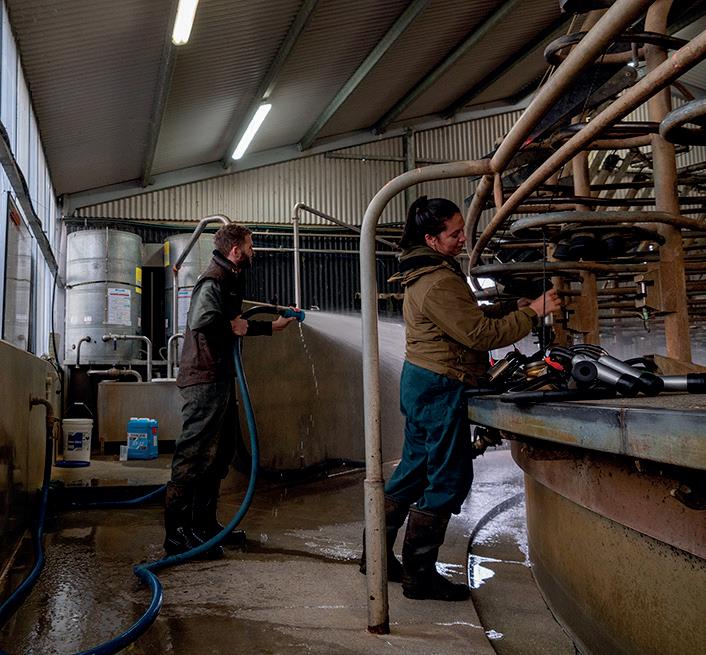
“I think global environmental regulations will be more challenging, but I feel this is an exciting challenge. We need to reduce our carbon footprint per kg of milk solids.
“We are at the forefront of the lowest carbon footprint per litre of milk in the world, but we need to maintain this. By improving the bottom 25% of our herds and breeding more resilient cows, we can then slowly reduce our stocking rate.”

































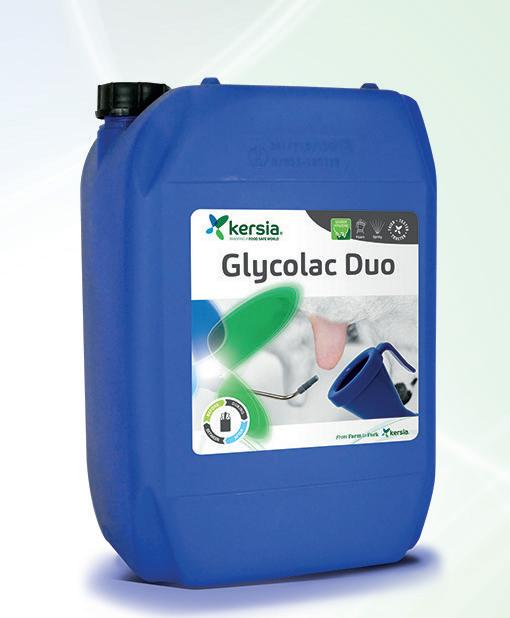



Methane emissions from dairy farms may be higher than thought, but conversion to biogas could reduce emissions and save more than £400 million a year in fuel costs. Dairy Farmer reports.
There is huge potential to turn emissions from slurry stores into a renewable energy source, according to new research conducted by the University of East Anglia (UEA).
e research also found that methane emissions from slurry stores on dairy farms may be up to ve times greater than o cial statistics suggest, but if captured and turned into biogas, emi ed methane could be worth more than £400 million a year to the dairy sector in saved fuel costs, or around £52,500 for an average-sized dairy farm.
Capture technology already exists, and if rolled out across the EU dairy herd, the conversion of methane to biofuel could reduce emissions equivalent to an estimated 5.8% of the remaining global temperature rise budget, if the temperature was to be kept to 1.5degC of warming.
Conducted by the UEA and the International Fugitive Emissions Abatement Association (IFEAA), the research is based on measurements from two dairy farms in Cornwall.
Together with a growing body of international eld research, it suggests that the ‘Tier 2’ calculations used by countries to report their emissions annually to the Intergovernmental Panel on Climate Change (IPCC) may not be robust.
Current National Inventories of greenhouse gas (GHG) emissions report that enteric emissions –those coming directly from animals’ digestive systems – are three to nine times greater than those from manure management, including

The conversion of methane to biofuel could reduce emissions equivalent to an estimated 5.8% of the remaining global temperature rise budget.
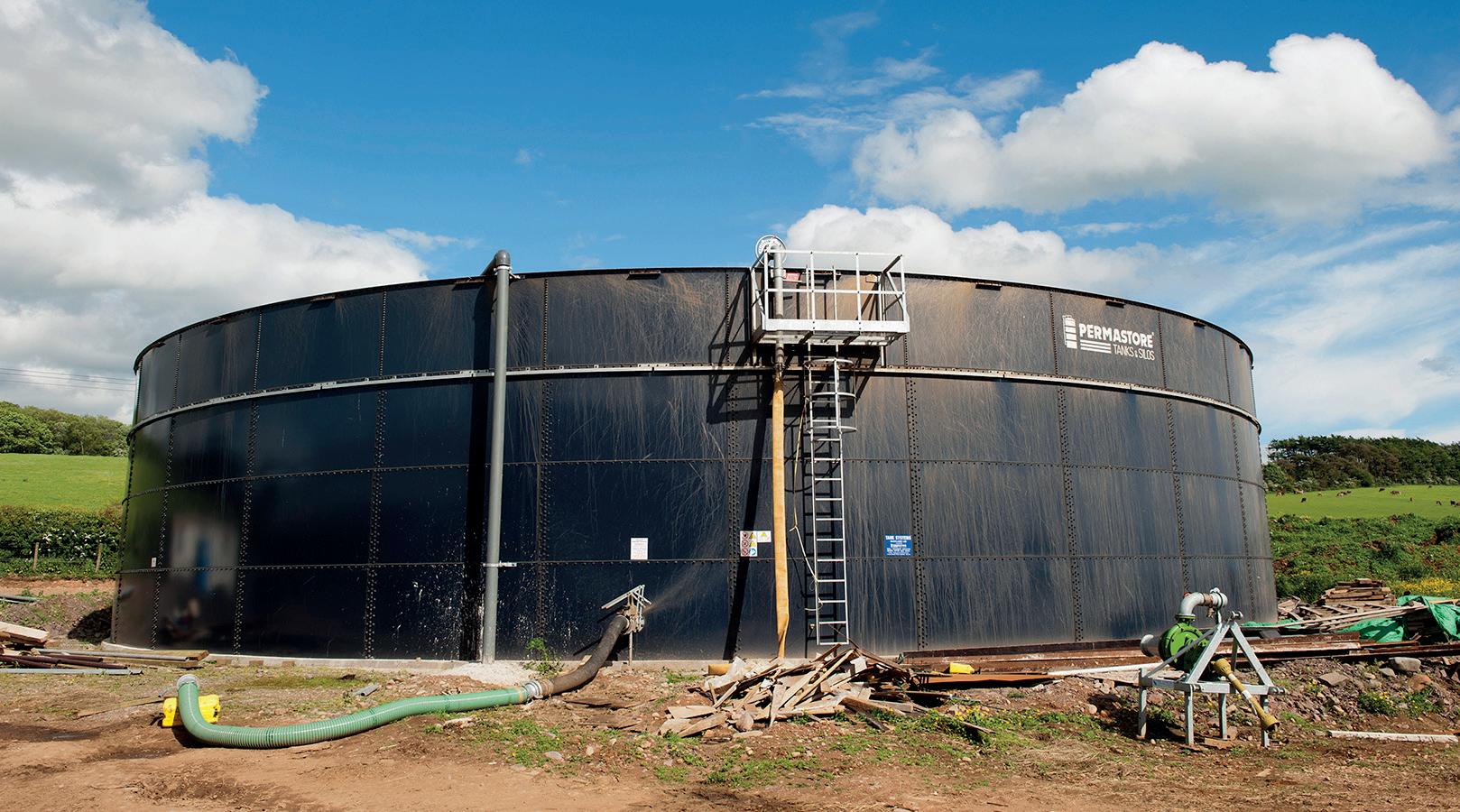
the storing and spreading of slurry and manure.
However, the ndings, reported in the journal Environmental Research: Food Systems and an IFEAA Net Zero Methane Hub white paper, suggest the balance between enteric emissions and those from manure management could be much closer to 50:50.
e authors also call for greater focus from researchers and political leaders on emissions from manure management.
Prof Neil Ward, of the Tyndall Centre for Climate Change Research at UEA, says: “ e standard international methodology looks to be underestimating methane emissions from slurry storage.
“Fortunately, we have the technology to turn this problem into a business opportunity for farmers who can reduce energy bills and become energy independent if they capture and make use of methane as a fuel.
“If emissions from manure management are being signi cantly
under-estimated, this not only means that o cial estimates are inaccurate, but also that priorities around mitigation options might be being distorted.
“ is research therefore represents an urgent call for action and further work to be er understand methane emissions from manure management.”
e researchers analysed measurements of slurry lagoon emissions from the two farms during 2022 and 2023. e lagoons were covered with airtight covers and the methane captured.
ey found slurry lagoons produce far more methane than suggested by o cial estimates, such as those based on methods developed by the IPCC.
Actual emissions from the farms were 145kg per cow per year and 198kg/cow/year, respectively.
is is four to ve times higher than the existing o cial gure of 38kg/cow reported in the UK’s National Inventory.
e resulting recommendations
for Government include research and development priorities, increasing grants for slurry covers and extending such nancial support to associated gas processing equipment.
e researchers also suggest simplifying planning and permi ing processes, and tax breaks for supply chain investment in methane recovery and use, such as investments by milk processors in supplier farms.
George Eustice, former Secretary of State for Environment, Food and Rural A airs and chair of IFEAA, said: “Methane is a potent but shortlived GHG and reducing emissions is critical to the pathway to net zero and limiting global temperature rises to 1.5degC.
“ e bad news is that emissions from agriculture are higher than previously thought, but the good news is that this methane is easily captured and used as an alternative to fossil fuels, creating an additional income stream for farms.”

Do you make maximum use of your robot
Using ForFarmers OptiRobot our Dairy and Robot Specialists are able to assess whether the interaction between robot settings, nutrition and health is optimal. It often turns out that small changes can make a big difference; Our Robot Specialists can help highlight areas where you can improve with the unique ForFarmers OptiRobot which provides:
9 Greater insight
9 More opportunities
9 Increased returns
For more information speak to your local ForFarmers Robotic Specialist or visit >

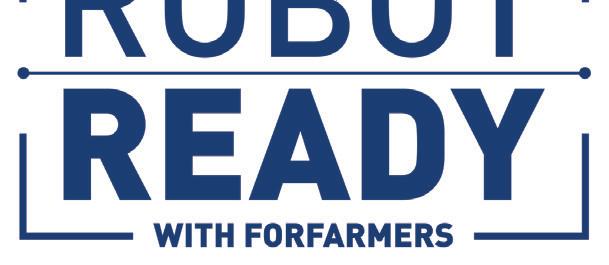
0330 678 0982
info.uk@forfarmers.eu
www.forfarmers.co.uk @ForFarmersUK
UK dairy has taken centre stage, with more than 40 international buyers and 60 British and Northern Irish businesses taking part in a major event aimed at boosting exports worldwide. Dairy Farmer reports.
Buyers from Asia, the Americas, the Middle East, Europe and North Africa headed to the UK for the Government’s Dairy Showcase, delivered in partnership with AHDB, with cross-industry support.
e week-long series of events showcased the best of the UK dairy sector, building overseas buyers’ understanding of the high standards of British farms and dairy production, such as cheese, bu er, yoghurt, cream, milk powders and infant formula.
e event included tours to dairy farms and processors in Somerset, Gloucestershire, Shropshire and Lancashire for delegates to gain rst-hand experience of the farm-tofork story of British dairy produce.


e week culminated with a Department for Business and Trade (DBT)-led ‘Meet the Buyer’ event and gala reception in Hertfordshire, which provided a platform for buyers to meet export businesses, with more than 320 business meetings taking place.
UK Dairy Export Showcase was developed in consultation with the Dairy Export Taskforce and industry as part of a programme which helps to progress the export capability of UK businesses and champions high-quality UK dairy products on the global stage.
e taskforce represents industry and is supported by industry bodies, such as AHDB, the NFU and Dairy UK, as well as Government departments DBT and Defra.
Exports Minister Gareth omas



said: “ e UK dairy industry is among the best in the world, exporting £2 billion of goods to more than 130 countries last year.
Capabilities
“We are backing our dairy producers – many of whom are SMEs – so they can increase their exporting capabilities, use trade agreements to access new routes to market, and continue to thrive and grow our economy.”
Farming and Food Minister Daniel Zeichner said it was great to see UK dairy products take centre stage at the Dairy Showcase.
He said: “We have introduced new rules to improve fairness in the dairy supply chain and are seeking a new veterinary agreement with the European Union to tear down unnecessary barriers to trade.
“ is is part of our new deal for farmers to boost food security, restore nature and support rural economic growth.”
Graham Wilkinson, AHDB chief executive, said the showcase provided the perfect platform to highlight the UK’s world-leading products and high production standards.
He said: “It complemented
AHDB’s extensive international market development activity, including inward and outward trade missions and participation in trade shows around the world.”
NFU dairy board chair Paul Tompkins said it was important the sector was recognised for its ambition and innovation.
He said: “We have previously exported more than £2bn worth of dairy products annually to more than 135 countries and have the potential to continue to increase that value within the next decade.
“However, boosting exports requires commitment and resource from Government, working in partnership with industry, to reduce trade barriers, help create market opportunities and enable growth.
“UK Dairy Export Showcase has been an exciting opportunity for the British dairy sector to stand out, reinforcing our reputation as world leaders in the dairy market and o ering a great platform to demonstrate our global credentials as producers of sustainable, climate-friendly dairy products.”

Dairy Farmer is celebrating its 95th anniversary this year, so we take a look at how the industry has changed and ask some of our regular writers to give their views on dairy farming.
When Dairy Farmer rst launched in 1929, the UK was struggling with low economic growth and recession.
Around this time, total ca le numbers on UK farms were around the eight million mark. From this point on, there was a consistent upward trend, with numbers standing at 15.2m in the mid-1970s.
At that point, the number of ca le began to fall, with much of this associated with BSE and foot-
and-mouth disease, which magnied the downward trend.
Much of the underlying decline in numbers since the 1980s has been in the dairy herd as a result of restrictions on milk production from milk quotas around this time. e latest Defra gures (for December 2023) show that the number of ca le and calves in the UK stands at just under 9.6m animals. And of these, 2.65m head are dairy cows.
According to AHDB’s latest survey of major milk buyers, it was estimated there were 7,130 dairy
producers in Great Britain as of April 2024.
In 2020, there were an estimated
8,300 producers in Great Britain, with an average volume per producer of 1.55m litres a year.
JI started writing Cowmen Comment in DF in 2009, alternating with the late Ian Potter. It was a task I thoroughly enjoyed, and writing about the last month’s farm experiences for so many years gave me a very good record of the happenings on our farm.
On the pedigree side, I tried to keep a medium-sized cow with good fore udder, feet and legs, with longevity and milk quality. We now have many heifers which are three generations of Excellent.







Looking back, the most dominant theme in my articles was the challenges of the weather, particularly flooding. Another irritant was escaping cattle – we have adventurous youngstock.
Since then, technology has moved on apace, with sexed semen and DNA profiling; robotic milking is no longer novel. Grazing herds persist, but more cows are kept inside full-time, with robots pushing up feed and removing the resultant manure, which often ends up in a biodigester.








We also suffered more than our fair share of inspections, but nowadays most farms are routinely assessed and often found wanting. Controls and investment needed for manure management are an expensive minefield. Under the eyes of supermarket buyers, inspections can be demanding and the stress affects mental health.
Over the years, our farm moved forwards and my articles told of a new milking parlour, with a 20:20 Herringbone replacing the antique 8:8, herd size increasing with new cubicles for 150 cows, together with roofing feed areas and new trackways throughout the farm.
We changed from all year round calving to spring and autumn, but always with an emphasis on grazing.
We can look forward to many more robots on the farm, some with artificial intelligence, driving tractors, maybe milking the cows and hopefully cleaning the farmhouse. Would a robot like to do my farm records?
Milk price is still everfluctuating and often does not cover costs, with the result that many more farmers are leaving the industry. When I was writing for DF, climate change was being left to scientists. In the last few years, it has suddenly become a mainstream concern, with farmers in the forefront.
At first, they were blamed for everything, but at least now it is recognised that they can be a big part of the solution.
Ploughs have been sold, or covered up in sheds, direct drills




Now, the average volume per producer is around the 1.7m litres mark.
and dairy farmer from Wiltshire

are popular, and the state of the soil is now of key importance.
For ourselves, we have found we have good stocks of carbon, but even more flooding.
However, some things never change – muddy and straw-filled wellington boots can still be seen racing through the kitchen with the comment: “Can’t stop – it’s an emergency!”








JIt has been a while since I last had chance to write for Dairy Farmer, but it will soon be 25 years since I first entered a competition, run by former editor Rachel Porter, to be the ‘next Roger Evans’.
I have been a lifelong fan of Roger, and like many of you I expect, when DF arrives, I go straight to the back and read what Roger has to say.
I ended up winning the opportunity to write in the magazine, and that competition has without doubt changed the direction of my career. I am, however, still not even close to being ‘the next Roger Evans’.
In my first column, I started to talk about robotic milking, which seemed to capture the interest of many readers. Saying that, even looking at robots back in the early 2000s was at the time a bold statement.
Around the same time, the first big issue I had chance to
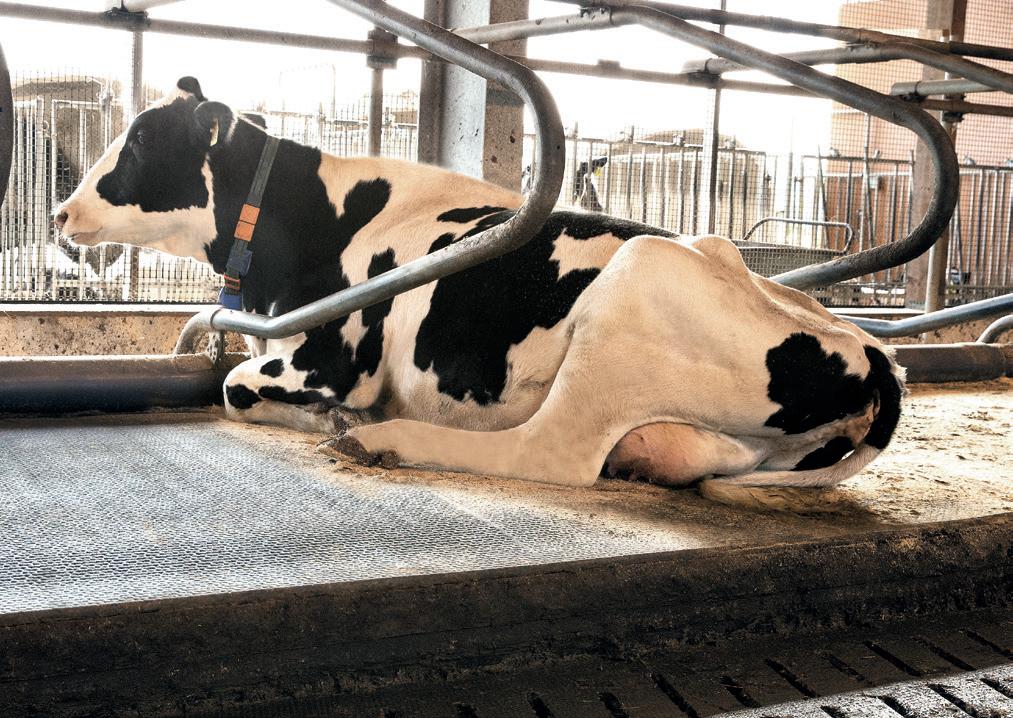

comment on was the foot-andmouth outbreak in 2001. Knowing what to say at the time was hard. It was a horrible time and is best forgotten, but during this period we were also busy fitting two robots and converting over to robotic milking.
Dad had always been keen on technology and we had an early computerised milking parlour which was installed in 1980. The ‘old’ parlour was still ahead of many when it was taken out in 2001.
But by the time I left Askham Bryan College, the parlour was

not physically big enough for the larger Holstein cows we had. So it was time for change and once Dad had seen a robot working he was convinced, telling me that the robot was ‘just an out-of-parlour feeder with a milking arm on it’.
This was still the early days of robotic milking in the UK. There was a lot of scepticism and undoubtedly there were some who wanted to see it fail.
I knew it was working for us and the flexibility that it brought to us allowed me time away from the farm and to develop a business, which would help others do the same thing we had.
My first 10 years of selling robotic milking systems were actually the easy years looking back, as the competition was really just conventional milking parlours versus a robot.
Continues over the page...






Nowadays, every milking parlour company has a robot and I wouldn’t like to be trying to sell one colour against another with companies trying to ‘outdo’ each other with a higher level of complexity, a gadget or add-on.
Robot manufacturers might want to take heed of what my dad said in 2000, that they are ‘just an out-of-parlour feeder with a milking arm’.
The milking robots of today have become way more complicated than they ever need to be, and there is a market for a simple robot to milk cows, but that is another story.
From a personal point of view the herd at Hunters Hill was sold in 2017 and the buildings now are mostly redeveloped. The land is all mostly arable,
which we package and sell as game and wild bird feed.
I have just 20 cows now, sucklers which we take the calves though to finishing.
The silage pits are now grain stores, the cubicles are mostly self-storage units, and the oldest buildings now form a rural office block for letting.
I still sell robotic milking units but mostly used machines which ironically some of which
JWhen I started out farming, the plan was to buy 30 cows. I can’t remember anyone running any budgets and 30 cows was enough. A farming periodical had just run an article where someone could make a living if they had 20 cows and 200 hens on deep litter. They had to keep things simple – all they needed was a tractor, a mower and a buck rake.
You could buy these big buck rakes you reversed into two swaths and when it was full you took it back to the clamp. Ironically, I made my first silage like this. It took me two weeks to do 14 acres. I was on my own with the milking to do as well.
This farm hadn’t sold milk before, so I had to keep the inspectors on-side because there was a grant for almost everything you did. My dairy inspector was a formidable lady in her 50s. She was very concerned about our water in our garden. Our best water was in a well in our garden. I chucked a bucket full of hypochlorite in there the day before she took a sample. She was very keen to know where all our drains ran and one day our wanderings took us up to a fence. I suggested that we return to the gate, but she insisted on climbing over. She got her knickers caught
on the barbed wire and made me unhook her.
I wanted a 3:6 abreast parlour, but she tried to talk me in to a 4:8 herringbone. I said I wanted 30 cows, but what I really wanted was 100. I got there after about two years: 100 cows on 80 acres.
I got there because I fed lots of barley straw and cake in winter. By now I had a bulk tank and the tank was full (200 gallons) and I was putting seven churns (70 gallons) on the communal churn stand in the village.
There were three others using that stand, but my seven churns were more than theirs altogether. That’s how it worked in those days; if you produced it, the Milk Marketing Board had to buy it and do something with it.
Lots of things happened beyond my control that set me back. Going brucellosis-free decimated my herd and took me back towards my original 30 cows.
When milk quotas arrived in 1984, I was selling 650,000 litres, but was given a quota of 300,000 litres. I was advised not to appeal as it might be reduced even further. I would appeal now.
Now we have TB chipping away at our industry. The irritating thing is that when I was at school we were getting on top of TB

and, all those years later, we are in a worse place.
All of that is down to politicians, who over the years have made bad decisions. It’s politicians like them who are telling us how to run the countryside now.
There used to be a feature in DF called ‘Cowmen Comment’. About six farmers would write a contribution every month.
One of the regular writers stepped down and the readers were to elect a replacement.
I decided to enter; there were about 30 of us. I won easily, I had six votes; one of those votes was mine and one was my mother’s.
The editor came out to see me and I was away. It was to be life-changing for me. In those early days we had to send our contributions in by post and fax was a big step forward, whereas now it’s email and much easier.
One day, in 2000, they phoned up to say that we had to go to a big dinner in London. I said
I am selling to the second and even third owner.
Bizarrely, small portable milking machines have become a major business for us, which we fell into by accident but now have a strong brand of ‘Gibson’ milking machines selling to hobby farmers, smallholders and city back garden house cow owners right across Europe. I didn’t like going to London and that I certainly wouldn’t go just for a dinner.
They phoned again in 10 minutes to say that, unbeknown to me, they had entered me in a competition, I had made it to the last six, DF had booked a table and I had to go.
The whole magazine industry would be there, the dinner was in the Grosvenor Hotel and it would be attended by 1,500 people.
The morning of the dinner, the phone was hot. They said to me: “You do know that it’s black tie tonight.” I replied ‘yes’ and 10 minutes later they were back on the phone asking if I knew what black tie meant.
Just to teach them a lesson I convinced them that I didn’t have any black shoes and one of the editors brought her husband’s black shoes to London.
I was entered in the Columnist of the Year category, I can remember that also in the final six were two doctors who wrote in The Lancet.
To cut a long story a bit shorter, the dairy farmer won and we had too much to drink on our table. Jonathon Ross was compere for the evening and he has trouble saying the letter ‘r’, they come out as a ‘w’. He said: “Well done Woger.”



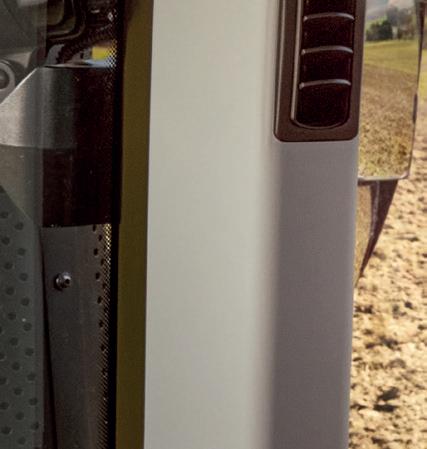






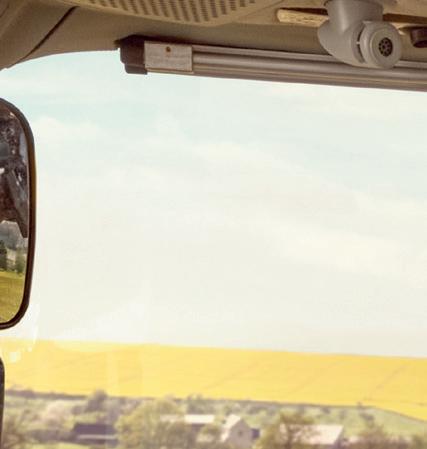












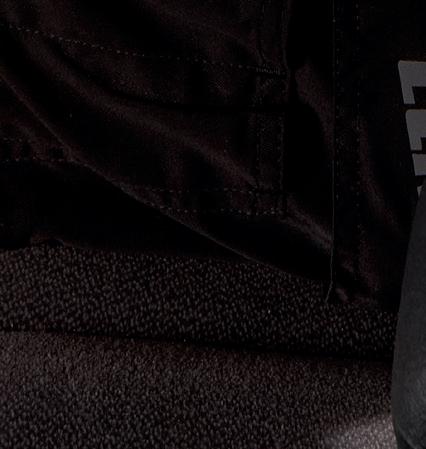




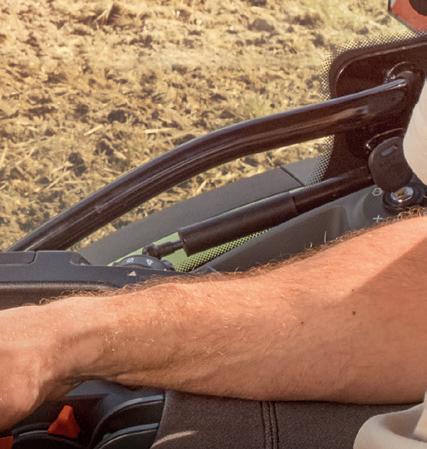

















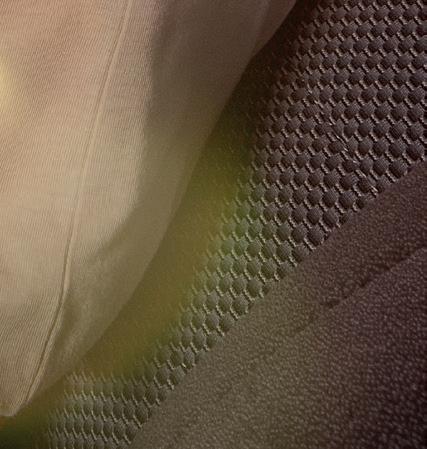

A complete business restructure saved Mossgiel Farm from certain closure, and farm owner Bryce Cunningham is now on a mission to show that big is not always best. Chris McCullough reports.
Sco ish dairy farmer
Bryce Cunningham was forced to make radical changes to the business plan at the family-owned Mossgiel Farm, Aryshire, in 2015, as it was losing cash and on the brink of collapse.
Bryce and his wife Ashlea married in 2021, they share four children aged from four to 11 years old and together they run Mossgiel Farm. e farm was originally established in 1948 by Bryce’s grandfather with just 20 cows. By 2015, the herd had expanded to 150 cows, but it was a year that was set to test Bryce’s resilience.
“Dad was diagnosed with terminal cancer, so I Ie my job as

a mechanic at Mercedes and came home to take over the farm,” says Bryce.
“Both my father and grandfather died the next year, and if that was not bad enough, the milk price crashed. We ended up with milk at 9ppl and subsequently the farm lost £150,000 in my rst year of farming. is then prompted the bank to basically pull out. I knew radical changes had to be made in order to survive.”
It was then that Bryce decided to return to more a traditional way of dairy farming similar to how it was in his grandfather’s time, with less cows and selling milk direct to consumers.
With that bold decision also came the management change to switch







to organic farming, which opened up a new market for milk at premium prices.
Now Bryce wants to challenge the status quo of dairy farming by proving big herds are not the only way to make money from milk.
Today, the herd has 45 Ayrshire cows in total, but Bryce also buys in milk from ve other organic farmers to produce milk and other products in the farm’s processing plant, which are then delivered all over Scotland.
“Most of the milk we sell comes from those ve other farmers,” says Bryce.
“ ey are part of the Organic Herd Co-operative and we buy the milk from there, then process it all at our dairy based on-farm.
“From there, it is delivered all over Scotland to a portfolio of customers including the City of Glasgow College and 100 schools in East Ayrshire, as well as cafes, restaurants and doorstep deliveries to people’s homes. If we have too much liquid milk at any point then that surplus is made into cheese and sold under the organic brand.
“We sell 33,000-38,000 litres per
week. e milk is distributed via six di erent wholesalers, plus we run nine delivery vans of our own.”
With such demand for the milk, Mossgiel Farm itself needs to upgrade and build a new dairy processing unit. However, the banks are unwilling to fund the investment.
Like in the past, Bryce is turning to crowdfunding to raise the revenue necessary by selling shares in the business.
“ e banks just did not like our business plan,” says Bryce.
“However, our demand is really strong and we are se ing a target to raise £900,000 through crowdfunding and private investment.”
e milk produced at Mossgiel is pasteurised but is nonhomogenised, meaning it retains the heavy cream top in the bo le that was popular decades ago.
Also proving very popular among discerning customers is milk from cows that have been kept with their calves for up to four months before they are weaned.
e key drivers behind Bryce turning his farm to organic and selling milk direct were his childhood memories on-farm, and also his time working with Mercedes.
rCows at Mossgiel Farm are milked once a day in the morning via a 12/24 herringbone parlour
rThere are 43 staff employed in the business, including those working on-farm, in the dairy and coffee shop
rThe milk produced at Mossgiel is pasteurised but is non-homogenised
“I always remember how milk used to taste like as a child growing up on the farm,” says Bryce. “It was full of texture and taste, not like the bland stu supermarkets sell today.
“I also recall reading stories about German organic farms when I worked over there. So when the opportunity came to change when we restructured the farm, I jumped at the chance of organic farming.
“Our customers tell us the taste of our milk is creamy and full of avour, and that is exactly what we are trying to achieve at Mossgiel.”
e price received for the milk produced at Mossgiel Farm varies depending on the area it is delivered


to and the type of milk – whether it is organic milk or the cow-calf system milk. Normally, this can be anywhere from £1.20 to £2.40 per litre.
“ e cow-calf milk is becoming our fastest growing niche product,” says Bryce.
“People are really interested in the high animal welfare concept when choosing this milk, and we are nding it is popular among consumers who wish to switch back from plant-based milk but are looking for something special.”
Mossgiel Farm stopped using single-use plastic in January 2019























and currently favours recyclable glass bo les for consumer deliveries.
All milk destined for co ee shops, restaurants, or schools is delivered in ve-litre or 20-litre buckets which are returned and reused.
Bryce has an ambition to reach production of 50,000 litres per week by the end of 2025, and that means taking in more farms to supply milk.
He says: “My main goal is to challenge the status quo of dairying right now.
“It seems the choice dairy farmers face is either milking really big herds
with extensive grazing platforms, or keeping the cows indoors.
“I think there is another option of the cow and calf system with small herds on organic farms that really engages consumers in how their milk is produced.
“New entrants who want to enter the dairy industry cannot do so because they do not have millions of pounds to set up.
“Here at Mossgiel, we have good opportunity to buck the trend, but we need to increase our processing capacity to do so.”























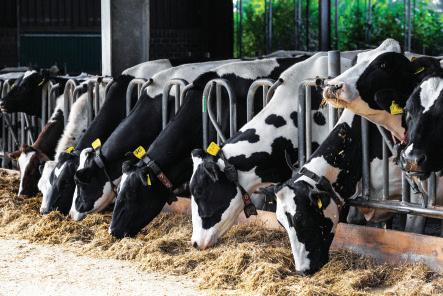



































































































Aviral disease a ecting ruminants and camelids, bluetongue is transmi ed via biting midges, with cases in the UK a result of infected midges being blown over from the continent.
Dr Ami Sawran, vet at Westpoint Farm Vets, Chelmsford, says infected midges will incubate the virus within four to 20 days depending on the temperature, before biting ruminants and camelids and causing them to become infective to other midges.
While some livestock may become unwell, others may not show any overt clinical signs, but will remain a reservoir of infection, says Dr Sawran. She says that ca le may be infectious for several weeks without showing signs of disease.
Dr Sawran says many of the clinical signs associated with bluetongue are also noted in diseases such as foot-and-mouth, which could be more detrimental to livestock and the livestock industry.
Dr Sawran says: “ e potential impact on health and production of an animal itself is evident, which is why working on a supportive care protocol with your vet is so important.”
She says the less immediately obvious impacts include the sale and movement of animals.
“A ected farms with movement restrictions applied may suddenly nd themselves with more stock for longer than anticipated, potentially leading to higher feed costs, or issues with stocking density, particularly in terms of pasture management or housing.”
JClinical signs of bluetongue include the following:
rLethargy
rCrusting and erosions around nostrils and muzzle
rConjunctivitis and excessive tear staining
rRedness of the mouth, eyes and nose
rReddening of the skin


Dr Ami Sawran says one of the most frustrating elements of bluetongue management is the difficulty in preventing it at herd level.
As bluetongue returned to the UK this year, Dairy Farmer looks at the clinical signs of the disease and important management advice.
Dr Sawran says one of the most frustrating elements of bluetongue management is the di culty in preventing it at herd level, due to the way the disease is transmi ed.
She says the culls undertaken when the disease incursion rst happened were to essentially ‘stamp out’ infection reservoirs.
However, once the disease was thought to be actively circulating in the midge population, this was no longer the most appropriate course of action within the high-risk areas, hence the reliance on movement restrictions to slow the spread.
above the hoof and between the cleats
rNasal discharge
rReddening and erosions on the teats
rFever
rMilk drop
rNot eating
rAbortion, foetal deformities and stillbirths
Dr Sawran says: “Many farmers are understandably asking what they can do to protect their livestock, but the midge risk is very difficult to mitigate.
“ e current advice is to ensure that livestock trailers are thoroughly cleaned and treated with insecticides for any necessary movements.”
She advises the treatment of individual animals with insecticides is not thought to be e ective in reducing midge activity, and their use could prolong withdrawal periods or have negative environmental impacts.
She says: “ ere may be merit to keeping animals away from midge breeding areas, such as muck heaps to reduce the bite risk, but currently, mandatory housing is only imposed as a condition of o cial notices from APHA, in the case of suspected or con rmed bluetongue cases.”
Dr Sawran says the use of three unauthorised vaccines has recently been permi ed in the UK and can be prescribed by a farm vet for use under licence.
She says there are various stipulations of using these vaccines,
including fastidious record keeping and declaring their use to APHA, as well as returning any wastage to the vet practice.
She says: “ ese vaccines may not prevent an animal from becoming infected but can reduce the severity of clinical signs and mortality associated with the disease.
“ e decision to vaccinate is an entirely personal one; there are di erences in the vaccine o ering which may make one more appropriate for your herd, such as data behind their use in lactating animals, bo le sizes and availability.”
Overall, Dr Sawran says the best course of action for controlling the risk and spread of bluetongue is to remain vigilant for signs, adhere to movement restrictions if imposed, and remain in conversation with your veterinary team.
As bluetongue is a noti able disease, farmers are legally required to report any suspected cases to the APHA or their farm vet, who can also report disease suspicion.








Receive a pair of overalls with all orders over 200 L

Synofilm GL is a Post-Milking Teat Dip Based on Lactic Acid and Glycolic By Neogen





One of the most common causes of lameness among the UK’s dairy herds, sole lesions can have a significant impact on animal health and cow productivity. Katie Fallon reports.
Initially a ecting ca le as early-stage bruising before developing into the more advanced form of sole ulcers, sole lesions can leave permanent damage within a cow’s claw and leave cows susceptible to lesions for the rest of their life, if le untreated.
As well as impacting cow health and welfare, sole lesions can impact milk production. Studies have shown sole ulcers could reduce production by 500-700kg of milk per lactation, as well as a ecting reproductive performance and feed intakes.
at is the advice from professor of ca le health and welfare at the University of Liverpool, Prof George Oikonomou, who says early treatment of sole lesions is crucial to managing lameness on-farm and preventing impacts to animal health and productivity.
Sole lesions are typically a result of several risk factors including housing, environment and genetics, says Prof Oikonomou.
He says that environmental factors include long standing times, overstocking and reducing sole thickness through excessive foot trimming.
Housing cleanliness is also an important risk factor, with cows that have been standing in wet slurry for long periods of time at greater risk of their soles becoming so er.
e period around calving is also a signi cant risk period for the development of sole lesions, explains Prof Oikonomou, es-


pecially for ca le in their rst lactation, with studies showing links between in ammation around calving and lameness.
Prof Oikonomou says: “ ere is also a huge debate on how important nutrition is or is not. Previously nutrition was discussed as the key risk factor and while I would still say a balanced diet is important, the link with ruminal acidosis is not as clear.”
As well as housing and environmental factors, genetics is one of the biggest risk factors in the development of sole lesions.
“We know that some cows are a lot more susceptible than others. But we can select for cows which are more resistant, which is a way of controlling it within herds.”
Prof Oikonomou says diagnosis of sole lesions in the early stages remains one of the biggest challenges.
He says: “At the moment we use mobility scoring to try and diagnose sole lesions but there is a lot of variability, and we know we will miss some early-stage bruising by just looking at cows.”
Automated lameness detection systems are being developed to aid early diagnosis of lesions, and while they have the added bene t of mobility scoring cows every day, the systems can still miss cows with early stage lesions.
There’s a lot of variability in diagnosis by mobility scoring – we know we will miss some
PROF GEORGE OIKONOMOU
Currently there is no other technology available to help diagnose sole lesions in the early stages, says Prof Oikonomou. However, the University of No ingham is looking at biomarkers in milk as an indication

of cows which are developing sole lesions, an option which could be available to farmers in the future.
“When looking at what you can do tomorrow to help detect sole lesions, I would say frequent mobility scoring, automated lameness detection using a validated system and routine inspections of early lactation cows at critical times.”
Once sole lesions have been identi ed, Prof Oikonomou says early-stage bruising should be treated in the same way as advanced lesions.
He advises the treatment of all sole lesions should include three steps; appropriate foot trimming to relieve the pressure around the lesions; orthopedic block on the healthy claw to relieve pressure and pain, and a course of non-steroidal anti-in ammatory drugs.
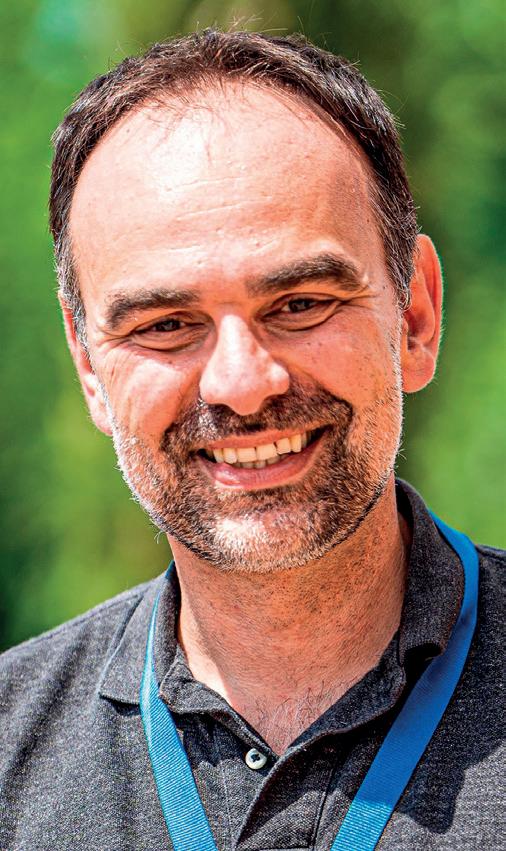

good research to show that it is be er to use full treatment on mild early-stage lesions to prevent permanent damage.
“We know that if a heifer has a sole ulcer, then its chances of having a sole ulcer again in second and third lactations are a lot higher compared to heifers which do not develop sole lesions. So, it is really important that cows are treated in the early stages.”
and around calving is also crucial to preventing the development of sole lesions.
“We have recently published a study showing a signi cant link between early lactation mastitis and sole ulcers, which could be due to systemic in ammation.”




“ e last thing is quite important, anti-in ammatories will help with the pain and in ammation. Especially if you are catching the lesions early, and there is some good research supporting this.”
Prof Oikonomou adds: “In practice I do see farmers hesitant to use the full treatment for mild bruising. But there is some
To prevent the development of sole lesions within the herd, Prof Oikonomou says managing the risk factors is key.
He advises avoiding over stocking to manage standing times in the shed, but also monitoring the time that cows spend in collecting yards and evaluating the e ciency of milking parlours.
Managing lameness and in ammation in transition cows
A focus on genetics is particularly important, and Prof Oikonomou advises using the Lameness Advantage genetic index to help identify bulls which have be er genetics for lameness.
He says: “We have recently published a study that showed a really strong association between the Lameness Advantage evaluation and incidents of sole ulcers.
“I would also advise a speci c focus on younger rst lactation animals. All of the things I have said I think will become really important for younger animals, especially around rst calving.”

The new standard being introduced by Ca le Health Certi cation Standards (CHECS) will see ca le classed as low risk for Johne’s disease able to receive a star rating from October 1 – Risk Level 1* (RL1*).
Herds which have already achieved a RL1 status will automatically qualify for RL1* status following a subsequent whole herd annual blood test with entirely negative results. RL1 herds containing animals that have a blood positive test for Johne’s, which are subsequently faecal negative, will not qualify for RL1* status.
RL1* status will also be accompanied by the number of consecutive years in brackets that herd has held the RL1 status. So, for a herd which has had no animal testing blood positive for four years, its classi cation will be RL1 (four years).
Tim Brigstocke, CHECS executive director, says: “Control of Johne’s disease is of crucial importance to animal health and welfare, farm e ciency and sustainability.”
It is also increasingly important to customers and consumers.
He says: “We cannot ignore the e ect it has on the long-term viability of our herds and also their environmental impact. Ultimately, infected herds will be less e cient, with animals that do not thrive, increasing the carbon footprint of the milk or beef produced.”
According to CHECS’ most upto-date gures, there are just more

A new level of Johne’s disease certification risk is to be launched this autumn to provide greater transparency for farmers and those buying stock. Hannah Park reports.
than 6,000 herds signed up to the Johne’s Disease Risk Level Certi cation Programme across the UK and Ireland over the various CHECSaccredited ca le health schemes.
Most of these are Sco ish (2,717) and English (2,456) herds, with 80% of these beef and 20% dairy herds.
Mr Brigstocke says: “ reequarters of beef herds involved are pedigree herds, although an increasing number of commercial herds are seeing the value in joining the programme. Many additional dairy herds also carry out quarterly
We cannot ignore the effect it has on the long-term viability of our herds and also their environmental impact
TIM BRIGSTOCKE
individual cow milk antibody testing to assess Johne’s disease status and guide herd management.”
While Johne’s control is not a straightforward process, he says it is one in which data plays a huge part.
He says: “ e programmes are playing a part in reducing prevalence and spread of the disease. Although infection with MAP, the cause of Johne’s disease, remains endemic in many herds, prevalence has been signi cantly reduced.
“In commercial herds this means be er levels of productivity and therefore e ciency and pro tability and reduced environmental impact. In pedigree herds, as well as these bene ts, it means a larger pool of lower risk animals to be sold or retained as breeding stock.”
e recommendation to add this additional risk level classi cation status was made by the CHECS Technical Advisory Group (TAG), following the universal agreement of the proposal by every member of the group.
Keith Cutler, veterinary director of CHECS and chair of TAG, says: “It is highly likely, due to the high speci city of the serological


tests used, that animals which test blood-positive are infected with mycobacterium avium subspecies paratuberculosis [MAP], the cause of Johne’s disease.
“Faecal testing remains relevant to try to de ne whether an animal with a positive blood test is shedding MAP in its faeces and to guide the management of that animal within the herd. But retaining this animal in a herd, irrespective of a negative faecal test result, is a high-risk strategy.”
In order to give all herds the opportunity to carry out testing to achieve the star, while making sure there is no advantage by being able

to publish this before others have reached their testing date, participants in the scheme whose herd test results show no seropositive animals for the year starting October 1, 2024, will be able to use these results to count towards RL1* accreditation.
However, that RL1* herd status will not be published on certificates and pen cards until October 1, 2025. Those interested in finding out more or signing up to the scheme are advised to speak with their regular vet in the first instance, with more information about all of the current CHECS-accredited cattle health schemes available on the CHECS website.
rRL1* (four years): The herd has achieved RL1 status and the most recent annual whole herd individual animal blood test has given entirely negative results for, in this case, four years.
rRL1: The herd has had three consecutive annual whole herd individual animal screens without infection being confirmed; any animals which have tested positive on blood will have had an additional faecal test with a negative result. This status is caveated
with the total number of animals tested and the number of these which gave a positive blood test result.
rRL2: The herd has had one or two consecutive years of whole herd individual animal screens without infection being confirmed.
rRL3: These herds are known to be endemically infected with MAP, but fewer than 3% of the animals tested at the most recent annual whole herd screen have given a positive test result.
rRL4: These herds are known to be endemically infected with MAP
and 3% or more of the animals tested at the most recent annual whole herd screen have given a positive test result.
rRL5: These herds are enrolled with a CHECSaccredited cattle health scheme on their Johne’s Disease Risk Level Certification Programme, but scheme rules have not been followed; this is usually because a breach of biosecurity or because required testing has lapsed.
Source: Cattle Health Certification Standards
Lyndon Edwards, an organic dairy farmer milking a herd of 275 Holsteins along the River Severn, Gloucestershire, was appointed chair of the AHDB’s Dairy Sector Council in 2021.
As incoming chair of the Dairy Roadmap, I am privileged to lead a movement that has already achieved important milestones for the industry over the past ve years. We have seen reductions in food waste, improvements in water e ciency, an increase in the average milking age of cows, reduced age at rst calving, shorter calving intervals, and a more sustainable approach to dairy production.
e strategic aims of the Dairy Roadmap are clear: to improve the environmental sustainability of the British dairy sector while ensuring the continued prosperity of the industry and the provision of safe, a ordable, nutritious, sustainable and climate-friendly dairy produce for the future.
e Dairy Roadmap continues to
drive forward the sustainability of the sector by se ing ambitious targets and reporting on progress (such as emissions, water use, energy e ciency and waste). In 2021, the Dairy Roadmap raised its ambitions for the dairy sector as a whole to achieve net zero in addition to our existing commitments.
is is an all-encompassing e ort, focusing not just on reducing greenhouse gas emissions, but also on improving biodiversity, soil health, and water management.
Some of our commitments include ensuring there are no serious pollution instances, there is compliance with Farming Rules for Water, we are improving biodiversity on dairy farms, and ensuring all non-natural waste is reused or recycled, with zero waste sent to land ll.

One of our notable achievements was the publication of the ‘Climate Ambition Paper’ in 2021, which sets out the dairy sector’s intention to align with the Government’s net zero strategy.
Our goals include achieving net zero carbon dioxide emissions by 2050 and making sustained reductions in methane and nitrous oxide emissions from 2025 onwards. is roadmap also encompasses a commitment to eliminate uorinated gases in the supply chain, moving towards natural refrigerants with a lower global warming impact.
e governance structure supporting these aims is robust, with a Steering Group that ensures alignment and includes representatives from Dairy UK, AHDB, and the NFU. Together, we set the strategic direction and drive industry engagement and collaboration. Speci c
target areas include baseline data, best practices in environmental sustainability, and methods to calculate and track the carbon footprint of British milk.
But these achievements are only part of the story. As we push forward, collaboration across the sector is crucial. As I step into my role as chair of the Dairy Roadmap on behalf of AHDB, I am lled with a sense of purpose and responsibility.
e Dairy Roadmap is more than just a plan; it is a collective commitment to ensuring an environmentally sustainable and prosperous future for our industry. As we move forward, I encourage every dairy producer and processor to get involved.
e Dairy Roadmap is a longterm vision that requires co-operation across the entire dairy sector – farmers, processors, retailers, and
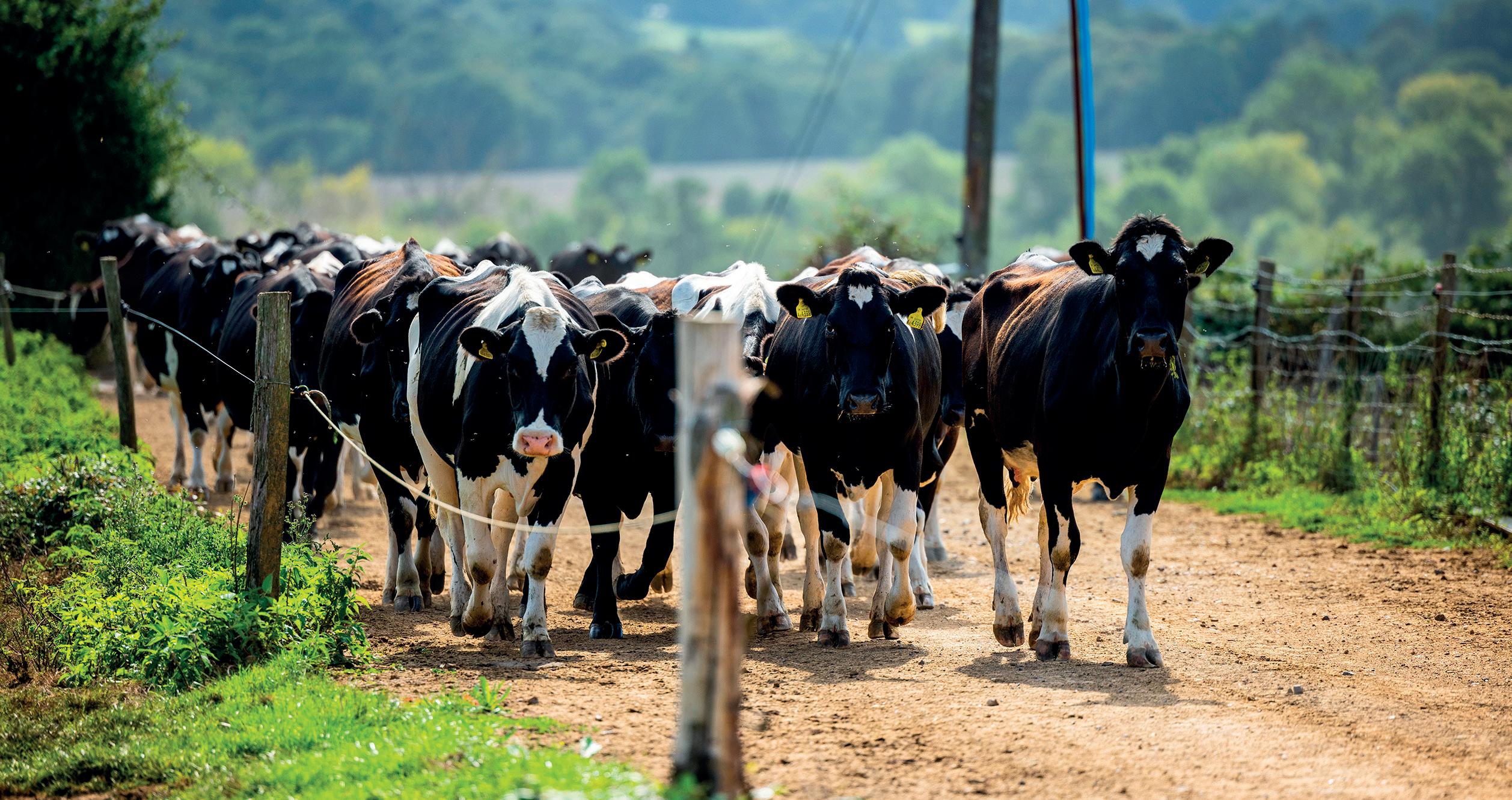






consumers all have roles to play. My main goal is to bring these groups together under a common cause. is approach is essential because it ensures that, regardless of where you are in the supply chain, we are all promoting the same messages about environmental sustainability, quality, and responsibility.
As part of the roadmap, we are focusing on initiatives such as improving animal genetics, enhancing animal health, and adopting farming practices that are both
environmentally friendly and cost-e ective. For example, through be er genetics we can breed healthier cows that are more productive, live longer, and produce less methane, which directly contributes to lowering the industry’s overall environmental impact.
My role as the chair of AHDB’s Dairy Sector Council will also be to demonstrate how AHDB’s activities can bene t the delivery of the roadmap’s objectives. e recently launched baselining work by AHDB provides much-needed independent, farm-level, environmental data. is project involves 170 farms across the UK – 50 of which are dairy farms – and marks a signi cant step in understanding where we stand today.
Establishing this baseline is crucial, not only for tracking our progress toward achieving net zero emissions, but also for validating the wider environmental goods and
services we deliver as an industry. is data will be invaluable in showing both the Government and the food industry how our practices evolve and contribute to a more sustainable agricultural sector. AHDB is also helping producers directly by o ering practical solutions, either through events or webinars, that bene t both the environment and the economic viability of farms.
As I mentioned earlier, the roadmap goes beyond reducing carbon emissions. We are also looking at water usage, ammonia levels, biodiversity, and soil health. It is a comprehensive approach to environmental sustainability that considers the whole ecosystem of farming. For instance, by planting crops like clover and herbal leys, we can improve soil health, supporting biodiversity, which helps capture carbon more e ectively and reduces reliance on arti cial fertilisers.
Another important area of focus is the use of Marginal Abatement Cost Curves, which highlight and







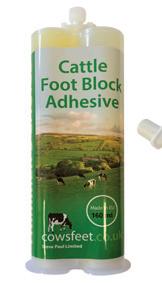


compare practices that o er the best environmental bene t versus expected nancial cost.
From e cient manure storage to optimising soil pH levels, these strategies can make a signi cant di erence in both reducing emissions and improving farm e ciency. Farmers have the tools at their disposal, and part of my role is to help make these solutions more accessible and widely adopted across the sector.
My vision is clear: to ensure that there is be er communication of the work needed so that we are environmentally sustainable while maintaining the quality of our dairy produce. We need to work together and embrace new innovative ideas. Farmers are the backbone of this industry, and our collective involvement is essential.
e Dairy Roadmap is not just a strategy; it is a shared commitment to improving our industry. Together, we can ensure that British dairy farming not only survives, but thrives for generations to come.



Anew test for malignant catarrhal fever (MCF) is now available from the Agri-food and Biosciences Institute (AFBI).
The new test is a MCF PCR which can detect virus nucleotides, and has been designed to complement the existing MCF antibody test.
MCF is a severe disease of cattle, deer and other hoofed animals and, in the UK and Ireland, MCF is most commonly caused by ovine herpesvirus-2 (OvHV-2) infection.
It is commonly found in sheep, which are lifelong carriers, but are often undetected as the infection is subclinical. However, MCF in cattle can result in a morbidity rate of more than 95%, with death occurring within five to 10 days of clinical onset.
No vaccine or specific treatments are currently available.
An AFBI spokesperson said: “While transmission from sheep to
rAffected cattle are profoundly depressed with a high fever (40.5-42degC)
rCattle will show a complete loss of appetite and the eyes are severely affected with corneal opacity causing blindness
rAffected cattle avoid bright
cattle is poorly understood, it is recognised that pregnant or recently lambed sheep and neonatal lambs pose the greatest risk of spreading MCF to cattle, so avoidance of co-grazing or housing of sheep and cattle together is recommended.”
MCF can affect multiple organ systems, including respiratory, gastrointestinal, neurological and skin.
Symptoms can appear months after initial contact, and can include:
rReduced milk yield
rFever
rLoss of appetite
rDepression
rEnlargement of all lymph nodes
rCorneal opacity
rDischarge from the eyes and nose
rCrusting and ulceration of the mucous membranes and skin
rSeizures
As some of the clinical signs are like those seen in other

diseases, such as BVD, severe IBR and bluetongue, it is important to discuss such cases with your vet. MCF can be confirmed through laboratory testing at AFBI.
The AFBI MCF PCR can be performed on sample types submitted through your farm vet.
Nasal swabs are the preferred sample, but the test can also be done on whole blood and organs.
Avoidance of co-grazing or housing of sheep and cattle together is recommended
light and sudden exposure to sunlight causes the eyelids to close
rCopious muco-purulent nasal discharges and a crusting of the surface of the muzzle
rEnlargement of all lymph nodes
Source: Nadis
The cost of MCF PCR is £20.
JThere is no treatment and affected cattle must be euthanised immediately for welfare reasons. There are not currently any
vaccines for malignant catarrhal fever. Control relies on avoiding contact with sheep, which can be difficult on mixed stock farms.

Stimulates immunity against Rotavirus, Coronavirus and E.coli K99 in pregnant cows and heifers, so that calves receive added protection via the colostrum.
• Prevents scour caused by Rotavirus and E. coli K99
• Inactivated vaccine with an oil-free adjuvant
• 2 ml single dose intramuscular injection
• Administered to the dam 12-3 weeks before calving
• Ready to use injections available in 1, 5, and 25 dose packs
• Available from your veterinary surgeon
To find out more scan the QR code or find us at calfmatters.co.uk and calfmatters.ie
Fencovis® suspension for injection contains inactivated E. coli expressing F5 (K99) adhesin, strain O8:K35; inactivated bovine rotavirus, serotype G6P1, strain TM-91; inactivated bovine coronavirus, strain C-197. Fencovis® is indicated for active immunisation of pregnant heifers and cows in order to stimulate the development of antibodies against bovine rotavirus, bovine coronavirus and E. coli expressing F5 (K99) adhesin and to increase the level of passive immunity of calves against neonatal diarrhoea caused by bovine rotavirus, bovine coronavirus and E. coli expressing F5 (K99) adhesin. Fencovis® has been shown to prevent neonatal diarrhoea caused by bovine rotavirus and E. coli expressing F5 (K99) adhesin, reduce the incidence and severity of neonatal diarrhoea caused by bovine coronavirus and reduce faecal shedding of virus in calves infected with bovine rotavirus and bovine coronavirus. UK: POM-V IE: POM. For information about side effects, precautions, warnings and contraindications please refer to the product packaging and package leaflet. Advice should be sought from the prescriber. Further information available in the SPC or from Boehringer Ingelheim Animal Health UK Ltd, RG12 8YS, UK. UK Tel:01344 746957 IE Tel: 01 291 3985. Email: vetenquiries@boehringer-ingelheim.com. Fencovis® is a registered trademark of Boehringer Ingelheim Vetmedica GmbH, used under licence. ©2023 Boehringer Ingelheim Animal Health UK Ltd. All rights reserved. Date of preparation: Nov 2023. BOV-0114-2023. Use Medicines Responsibly.
Regular footbathing is one of the primary defences against dairy cow lameness, and with a single case estimated to cost £300 on average, it is essential to follow the correct protocol. Wendy Short reports.
The main purpose of footbathing is to keep the feet clean and prevent infection. An infection o en starts with dermatitis, and the resulting break in the skin can lead to more serious problems, including foul in the foot, says Anthony Marsh of Lancashire-based automatic ca le footbath company Hoofcount.
e most important consideration for installing a footbath is to design a system that is easy to use, as this will encourage frequent use, he says. e aim is to clean the foot and allow maximum contact with the solution.
He says: “In an ideal situation, footbathing should be carried out at every milking, or twice daily for robotic milking systems.
“Producers readily accept that teat dipping should be done at each milking, and footbathing is no di erent.
“It will not increase overall chemical expenditure, because the concentration can be reduced as the number of visits increase. Most farms will add the active ingredient at a rate of between 0.5- 3%.”
Mr Marsh says careful planning is required to ensure good cow ow and avoid the cows being reluctant to enter the footbath.
He adds: “ e installation should be rmly xed in place, with the base o ering plenty of grip. One option is to use a rubber liner, with a raised ‘penny’ design to further reduce slip.



Careful planning is needed to ensure good cow flow and avoid the cows being reluctant to enter the footbath.


“Stainless steel is the preferred construction material, due to the corrosive nature of some of the chemicals that are used.
“And it is be er to place the footbath on the exit route, as it limits human exposure to any chemical fumes, depending on the type of product being added.”
features
Research has identi ed some key features of a footbath that will maximise cow comfort during treatment and at the same time achieve an e ective result, he says.
“Cows prefer to step up into a footbath, rather than step down. A step measuring about 20cm high will allow the foot to go straight into the solution, which should be roughly 10cm deep,” says Mr Marsh.
“A narrow design is preferable for a parlour installation, with a width at the base starting at 61cm and widening to 91cm.
In terms of length, the ideal is 3.65 metres, which will mean that each foot is covered in the solution three times.
“It is unlikely that producers with robotic milkers will be able to adopt the length of footbath recommended for parlour milking, so the number of visits can be increased to produce the same result.”
0.5-3%
Rate of active ingredient usually added to footbath solutions
Trials have shown that pre-bathing the cows’ feet with clean water is counter-productive, he adds. e water forms a barrier and limits the action of the next stage, where chemical solution is used, e ectively diluting the solution containing the active ingredient.
e routine for footbath solution changes will depend on cow numbers and visit frequency, says Mr Marsh.
“A general rule is to use one litre of footbath solution per cow. erefore, a bath containing 150 litres of solution should be changed a er it has been used by 150 cows.
“It has been proven that it is be er to avoid footbathing
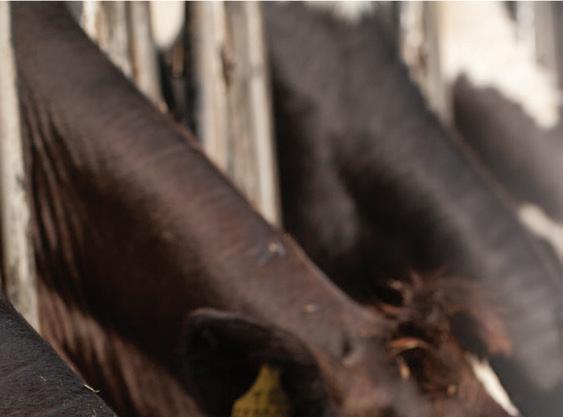


altogether than to use a soiled solution, which itself can become a potential source of infection,” he says.
“One of the main bene ts of an automatic footbath is to guarantee a clean solution whenever it is needed. In addition, by removing
Footbathing should be carried out
ANTHONY MARSH
the lling and draining process from the list of many tasks required on a dairy farm, in practice it will o en lead to an increase in the footbathing frequency.” e industry has mostly relied on formaldehyde for footbathing, he says.
“Formaldehyde is e ective on the cows’ feet, but it is not so user-friendly for the operator. However, in cases where the waste product is added to slurry, it is diluted to the point where it will not cause any issues.
“ e same cannot be said of copper sulphate, which is another option. Some thought will need to be given to its disposal, as it can be harmful if it ends up going into a system where it is subsequently spread on the land.
“Organic acids ful l their purpose, although they can be expensive, while hypochlorite is still unproven. It is worth comparing monthly costs for the various options before making a purchase,” says Mr Marsh.







I IODINE:
• 4x increase in requirement during winter1
• Crucial in supporting metabolism during 1st third of lactation


Se SELENIUM:
• Legumes and white clover can inhibit selenium absorption2

Cu COPPER:
• 20% increase in requirement during pregnancy3





A VITAMIN A:




DON’T FORGET THE INCREASED IMPORTANCE OF VITAMINS…
• Liver reserve can deplete in winter without supplementation


Essential for: sight, calf development during pregnancy and digestive mucous membranes
D3 VITAMIN D3:
• A shortfall can occur when cattle are housed without access to natural light
Essential for: immunity and calving
E VITAMIN E:






• Up to 80% less contained in conserved forage4
• 97% of dairy cows have a shortfall at calving5
• Responsible for 50% of antioxidant activity in cattle6
BRIDGE THE GAP WITH AGRIMIN’S ALL-TRACE® RANGE
Experts are urging farmers to safeguard dairy heifers from parasites at housing to maintain their health, growth and productivity over winter. Dairy Farmer reports.
The warm and wet autumn weather seen so far could increase the risk of gutworm and uke burders in ca le, says Elina Body, a vet from George Vet Group, Wiltshire.
Reports from the Animal and Plant Health Agency suggest liver uke cases may appear earlier this year due to favourable conditions for the host mud snail and free-living liver uke stages in the environment.
Ms Body says: “Our advice is for farmers to remain vigilant and implement targeted treatments for parasites. Parasite challenges will vary by location, so farmers need to assess the risks to their own livestock and pastures.”
Adult dairy ca le typically develop su cient immunity to gutworms a er two grazing seasons. However, animals with inadequate exposure or those immunosuppressed by other factors can experience reduced milk production due to gutworm or lungworm infestations.
Ms Body says: “ is highlights the importance of focusing gutworm management on high-risk animals, such as youngstock, to avoid unnecessary blanket treatments which could promote wormer resistance.”
And Ms Body says parasite management at housing can help prevent production losses over winter.
“Historically, wormer administra-
Tests
JDiagnostic tests which can help to assess fluke risk and burden include:
rBulk milk ELISA (antibody test): Useful for detecting exposure, but does not confirm active infection
rBlood ELISA (antibody test): Especially useful in first grazing season youngstock; it indicates exposure and the likely presence of active fluke infection
rFaecal egg counts:

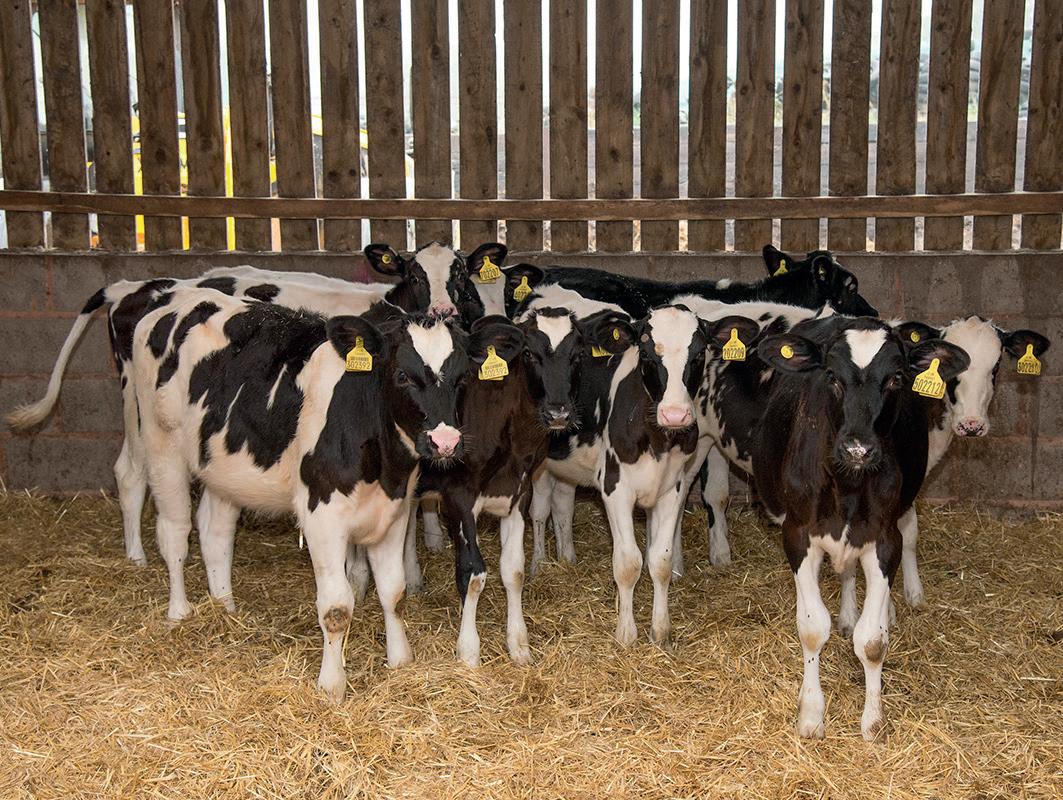
tion at housing was used to clear out animals before the next grazing season, reduce pasture contamination at turnout and eliminate hibernating Ostertagia gutworms.
“ ese can cause type 2 ostertagiosis in spring when the gutworm larvae mass-emerge from the gut wall of the animal.
Commonly performed on pooled samples, but it may not detect early stages of infection as it relies on adult fluke to be present producing eggs
rCoproantigen test (faecal test): These can detect fluke presence weeks before fluke egg counts, but may not be effective with low burdens
rAbattoir data: Slaughterhouse reports, offer valuable feedback
“Our advice is that housing wormer administration is a riskbased decision which should be discussed with your vet. Blood pepsinogen testing can be a valuable diagnostic tool, and only certain wormers are e ective against hypobiosed ostertagia gutworms.”
For e ective uke control, Ms Body highlights the importance of diagnostics to ensure correct timing of ukicide administration.
She says: “Fluke has a long lifecycle within ca le, and not all ukicides work against every life stage. Additionally, ukicides have no residual activity, so they only target susceptible uke within the animal at the time of treatment.”
And she says wormers and ukicides should be ‘used as much as necessary and as li le as possible’.
She says: “With a clear understanding of the parasite risk, farmers can work with advisers to choose the most appropriate control strategy, including risk management
with grazing, suitable diagnostics and treatment decisions factoring in withdrawal times and product e cacy.”
Zoetis vet Patricia van Veen reinforces the importance of correct treatments and timing.
She says: “Products must be used for the correct indication at the correct time for maximum e cacy.
CYDECTIN Pour -On for Ca le is a wormer which is suitable for all classes of stock with a short meat and milk withhold.
“It can be used in a targeted way, for example in heifers which are behind in their expected growth or dairy cows diagnosed with a need for treatment.”
Mrs van Veen also stresses that lungworm remains a signi cant challenge, especially in rst grazing youngstock.
She says: “During the grazing season, lungworm control relies on exposure to the worms to develop and maintain immunity. Disease o en occurs unpredictably and fast when eld burdens suddenly get high and animals are not yet immune to the infection.
“Lungworm should be considered in coughing animals of any age at this time of the year.
“Treatment needs to be immediate, and animals should be moved from high risk elds to prevent ongoing lung damage.
“Discuss your housing treatment options with your prescriber and arrange to meet up to plan for the next grazing season.”


NASYM" : lyophilisate and solvent for suspension for injection or nasal spray for cattle. Each 2ml dose contains: Live attenuated bovine respiratory syncytial virus (BRSV), strain Lym-56 10 4.7 - 6.5 CCIDS0. INDICATIONS: Active immunisation of cattle to reduce virus shedding and respiratory clinical signs caused by bovine respiratory syncytial virus. For more information about side-effects, precautions, warnings and contra-indications please refer to the packaging or product leaflet. Further information available from SPC or on www.hipra.com. MARKETING AUTHORISATION NUMBERS: UK(GB): Vm17533/5008, UK(NI): EU/2/19/241/001-2 MARKETING AUTHORISATION
HOLDER: Laboratories Hipra, S.A. Amer (Girona), SPAIN. LOCAL REPRESENTATIVE: HIPRA UK&IRELAND, Foxhall Lodge, Foxhall Road, NG7 6LH, Nottingham, United Kingdom, Tel.: (+44) 0115 845 6486, ukandireland@hipra.com, www.hipra.com. LEGAL CATEGORY: UK: POM-V. Veterinary medicinal product subject to veterinary prescription. Use medicines responsibly. Under veterinary prescription, advice should be sought from veterinary prescriber Prescription decisions are for the person issuing the prescription alone.
HIPRABov1s·�: Inactivated vaccine with Histophi/us somni and Mannheimia haemolytica leukotoxoid in injectable emulsion for cattle. INDICATIONS: For the reduction of clinical signs and lung lesions caused by Mannheimia haemolytica serotype Al and Histophilus somni in calves from 2 months of age. For more information about side-effects, precautions, warnings and contra-indications please refer to the packaging or product leaflet. Further information available from SPC or on www hipra.com. MARKETING AUTHORIZATION NUMBER: UK: Vm 17533/4005 MARKETING AUTHORIZATION HOLDER: LABORATORIOS HIPRA, S.A. Avda. La Selva, 135 17170Amer (Girona) Spain. Tel (972) 430660 - Fax (972) 430661. LOCAL REPRESENTATIVE: HIPRA UK&IRELAND, Ltd Foxhall Business Centre, Foxhall Lodge, Foxhall Road, Nottingham - NG7 6LH - UNITED KINGDOM. LEGAL
CATEGORY: UK: POM-V. Use medicines responsibly. Under veterinary prescription, consult your veterinary prescriber for further advice. Prescription decisions are for the person issuing the prescription alone. Safety and efficacy of these products together have not been evaluated. A decision to use either of these vaccines before or after any other veterinary medicinal product therefore needs to be made on a case-by-case basis.

HIPRA UK AND IRELAND Foxhall Lodge, Foxhall Road, NG7 6LH, Nottingham, United Kingdom Tel (+44) 0115 845 6486 · ukandireland@hipra.com · www.hipra.com
By working closely with his farm vet, Phil Davies has implemented a neonatal vaccination programme in recent years, and 2024 has proved to be a breakthrough year in which the incidence and treatment rates for bovine respiratory disease (BRD) have fallen to zero.
Mr Davies, who farms with his family at Maesyneuadd, near Pont Robert, north of Welshpool, oversees the youngstock rearing for the 200-cow herd, which is farmed alongside 32,000 laying hens.
e farm’s vet, Iolo White, of Welshpool-based Camlas Farm Vets, says that although calf losses have been ‘minimal’, they stood out as being too high.
He says: “We work closely with Phil, with regular health and production reviews for the herd. e disease incidence in these calves was totally out of context with an otherwise high health status herd.”
Mr White says they started using an intranasal vaccine targeting bovine respiratory syncytial virus (BRSV) from 2022, but they were still seeing high levels of morbidity and antibiotic use remained signicant, despite excellent colostrum, hygiene and calf environmental management.

A preventative approach is proving effective for Powys dairy farmer Phil Davies as he seeks to reduce the debilitating impact of pneumonia in calves on his 200-cow spring calving unit. Dairy Farmer reports.
He says: “In 2023, we took nasal swabs from calves requiring treatment to investigate if there were any other notable pathogens involved and the laboratory identied the presence of coronavirus.
“In spring 2024, we vaccinated all the pure dairy heifer calves with both Bovilis INtranasal RSP Live, which targets BRSV, and Bovilis Nasalgen-C.
“All calves were done at the same time, so will have been between one and four weeks of age. Results have been transformative, with no symptoms of pneumonia and no treatment administered this year.” e recently launched intranasal
vaccine, Bovilis Nasalgen-C, provides protection against pneumonia caused by respiratory bovine coronavirus (BCov). is organism has only relatively recently been recognised as a signi cant player in the BRD complex, so Mr White says these on-farm results were interesting and signi cant. e herd at Maesyneuadd is now closed and Mr Davies aim to rear replacements which are of a type and size suited to the farm’s grazing-based system. He says whether it is selectively bred replacements, heifer calves sold for breeding or beef crosses which are collected from the farm by the same rearer each year, all

youngstock have signi cant value at Maesyneuadd.
All newborn calves are le on their mothers for 24 hours, with three litres of their dam’s colostrum fed within the rst few hours to guarantee intakes. Calves are then kept in individual pens for about 48 hours to ensure they are se led and properly trained to a teat, before being grouped in pens of up to 10.
Mr Davies says: “Our calf sheds are fairly basic, but they are airy, and we clean and sterilise the individual pens between calves, with all navels treated with iodine at birth. We keep the replacement heifers separate from the beef cross calves, but all are introduced to a weaner pellet from day one.
“We dis-bud early, at about three weeks, so this is done before the beef calves go, at about four weeks, and is well away from the main stress point, weaning, at eight weeks.
“Calves will be eating 1-1.5kg/day of the weaner pellets at weaning.”
An average growth rate of 0.8kg/day is the target for heifers to reach optimum bulling weight by 15 months, and then calve down at 24 months. e aim is to achieve this almost entirely o forage, so giving calves a good start in life and then maintaining their health throughout is vital.
Mr Davies says: “Replacement heifers are mainly reared on rented grazing away from the farm apart from a period in autumn when we strip-graze them on kale and around

six weeks in winter when they come inside and receive grass silage and 1kg/head/day of concentrates.
“We synchronise them for breeding, mainly for convenience because they are away, and use an arti cial insemination Aberdeen-Angus bull for the rst 10 days, before
allowing them to run with our Hereford sweeper bull.
“I prefer not to breed replacements from heifers, as I like to see how they perform in the parlour before making those decisions.”




Tackling respiratory BCov through preventative vaccination at the earliest opportunity is certainly a signi cant step forward, removing what had been a potential weak point in an otherwise robust system.
Mr White says: “It was very interesting to nd coronavirus in

rThe herd yields about 5,500-6,000 litres/head/ year at 4.8% butterfat and 3.75% protein
rSexed semen is used on cows which have been selected through milk recording as the best to breed from
rThe aim is to introduce 45-50 heifer replacements each year, continually improving the herd
rSurplus heifer calves are sold for breeding, and British Blue semen or a Hereford sweeper bull is used to produce a beef cross from any cows not selected for breeding
the nasal swabs taken in 2023. I can see vaccination against this pathogen in young calves becoming a very important tool in controlling pneumonia.”
Experience the future of herd management with DeLaval Plus








Our platform collects herd data to provide easy-to-understand information and health alerts.






















The ‘Disease Risk’ application predicts cows at risk of mastitis, metritis, ketosis, and other diseases, ensuring a healthier, more productive herd.






Smarter farming starts with DeLaval Plus.



Vet Owen Atkinson reviews the progress in tackling lameness in the national herd, looks at emerging technology and outlines a new project which has set ambitious lameness reduction targets. Wendy Short reports.
The accurate monitoring and recording of dairy cow lameness is one of the major challenges facing the industry, says Owen Atkinson, who runs the Dairy Veterinary Consultancy.
He says: “ e last truly independent study was carried out a decade ago. It concluded that just over 30% of cows in the average herd had a score of 2 or 3, which is the o cial de nition for lameness set out by the Register of Mobility Scorers.
“Most farmers underestimate lameness in their ca le when they are self-reporting their scores. is is partly due to a ‘blindness’ to their own herds,
rAllows early detection of mobility issues, which when combined with prompt effective treatment can reduce the severity of lesions and the development of chronic changes within the foot
rIdentifies new problems
but it is also di cult to achieve accurate results without prior training.”
Mr Atkinson recommends that milking and dry cows are lameness-scored fortnightly (or at least monthly), by a trained owner or manager, with a quali-
at an early stage and monitor mobility trends
rProvides figures to benchmark performance
rIncreases your awareness of cow foot health
rMotivates farm staff to improve herd mobility and overall herd health
ed accredited mobility scorer brought in on a quarterly basis for calibration purposes.

Studies have shown that most untrained farmers will not reliably reach the standard required for e ective lameness scoring, with inconsistencies and a degree of subjectivity having an in uence on results.

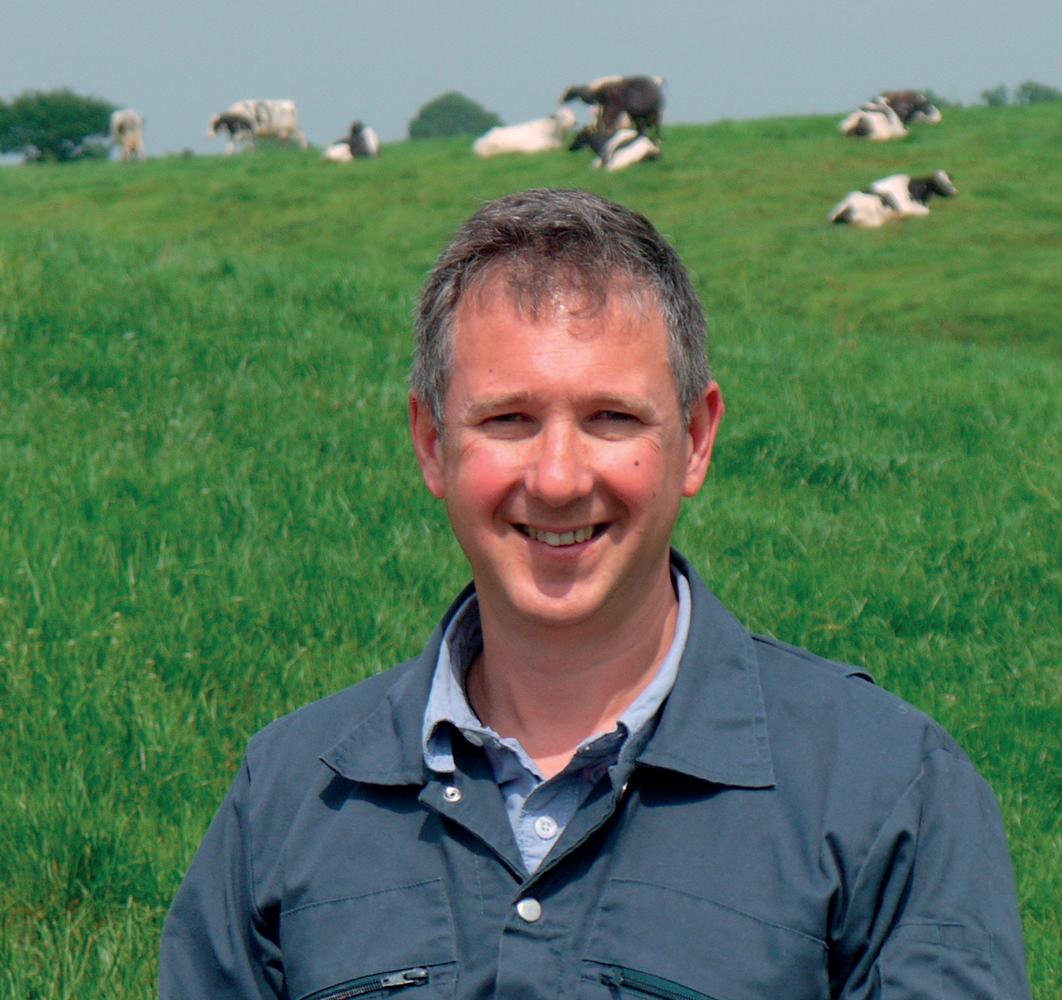
He says: “Cows should be assessed on a non-slip, level concrete surface, preferably walking at a natural pace in single le. In practice, this is quite di cult to achieve, but it is the only way to ensure scoring accuracy. Individuals should be clearly marked, with freeze-branding the best option.”

Owen Atkinson

Prompt identi cation and e ective treatment are vital for bringing herd lameness gures under control, he says, while maximising cow comfort and correct foot trimming and handling are other important factors.
Milking and dry cows should be lamenessscored fortnightly says Owen Atkinson.

He says: “Once lameness has advanced, there is a high risk that the problem will recur.
“Over trimming and faulty techniques are also to blame, and it is essential to use an accredited professional for the task. Cubicle beds should be as comfortable as possible to encourage lying. Meanwhile, overcrowding and a rushed approach when moving cows should be avoided at all costs.”
He describes the new technology for early lameness detection as a potential ‘game-changer’ for lameness management.
He says: “ e dairy industry is crying out for the widespread use of proven technology which will pick up early lameness without relying on human objectivity.
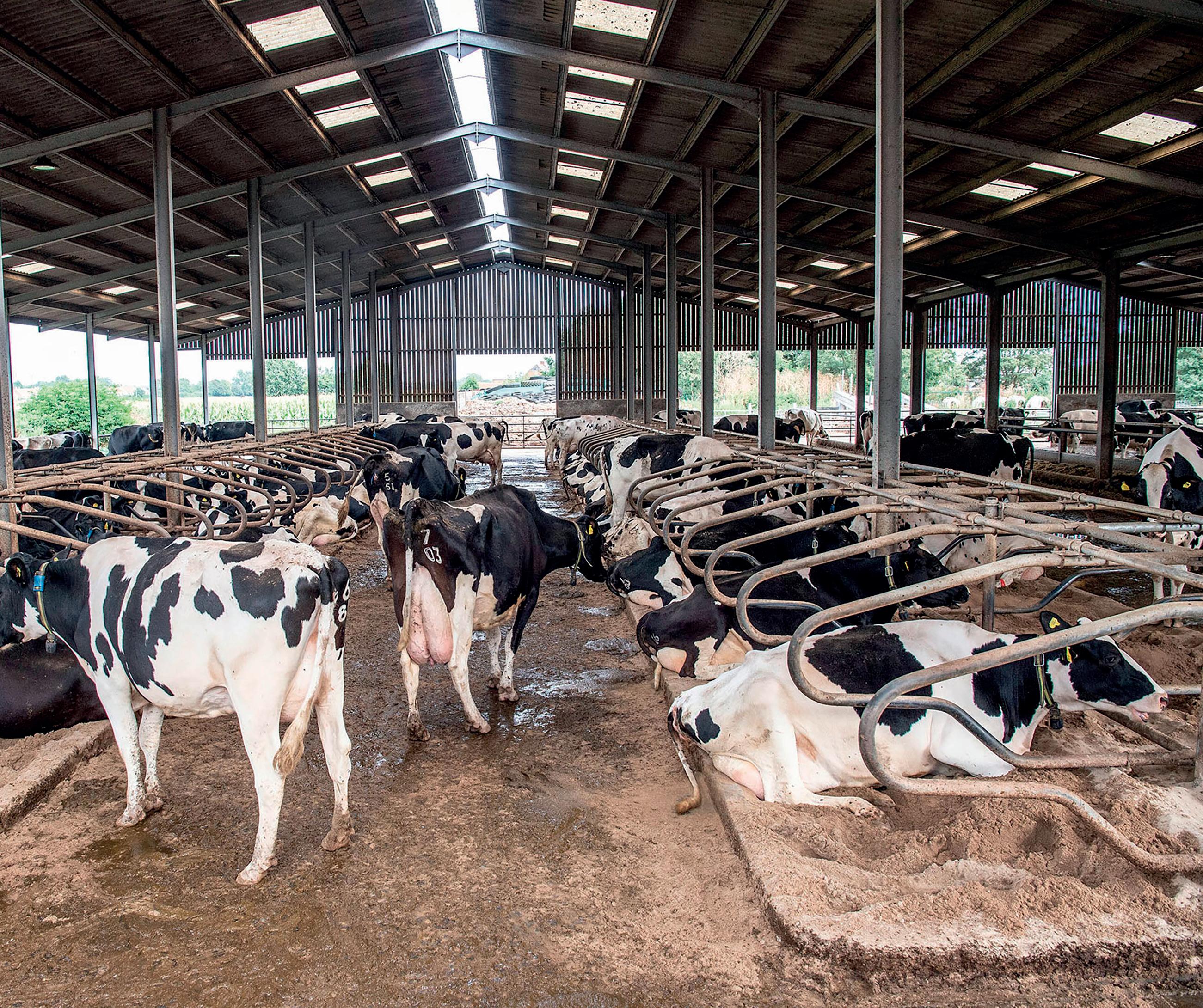
“Several products already on the market use a combination of artificial intelligence technology and cameras to detect early lameness cases, and others are still under development.
“Potentially, cows can be fitted with activity meters, providing an alert to a change in lying behaviour.
“Other systems will record a temperature spike in affected feet, which can be a sign of inflammation. However, not all of the systems have been fully validated.
“Some interesting research work is underway, including the early stages of a project to see whether lameness can be detected by chemical changes in milk. That
JA 20-year commitment to reduce cattle lameness has been made by an industry collective, Owen Atkinson says.
Developed by the Dairy Cattle Mobility Steering Group (DCMSG), the Dairy Cow Lameness Manifesto sets out how the industry could incrementally reduce herd lameness by at least 10% year on year over the next two decades, by pulling together and adopting best practices.
The overriding target is that at all British dairy herds will have achieved a lameness prevalence below 5% by 2044.
Members of the DCMSG
would be a major step forward. Another field of interest is work on identifying cattle which have the greatest genetic predisposition
are unpaid volunteers and include vets, foot-trimmers, academics and farmers, who monitor lameness trends and new developments worldwide.
The project, which launches next year, will be overseen by Prof Martin Green, of Nottingham University.
Dairy farmers will be encouraged to use AHDB’s Healthy Feet programme to manage lameness with the help of a qualified adviser and to measure their own achievements against targets agreed with their vet.
Mr Atkinson says: “In my
for resistance to foot lesion development. A reasonable level of heritability has already been discovered for digital dermatitis
opinion, the manifesto is ambitious, but realistic. There is no magic wand for lameness reduction. If it was an easy fix then greater progress would have already been made.
“I would encourage all dairy farmers to support the manifesto’s objective to steadily reduce lameness. It will help the bottom line, as well as enhancing the image of dairy farming.
“As lameness levels decrease, it can become harder to further drive them down, and this element is recognised in its strategies. Whatever the position, there is always room for improvement.”
and sole ulcer lesions. Great progress could be made if we could selectively breed cattle on that basis.”
Ensuring an optimal mineral status across all life stages and lactations is key to reducing the risk of over supplementation in housed herds. Katie Fallon reports.
The over supplementation of minerals is common among many of the UK’s dairy herds, particularly within all year round housed herds. With e ects on cow performance, pro tability and the environment, ge ing the mineral balance right within dairy diets is an important aspect of herd and farm e ciency.
Independent mineral consultant Dr Annie Williams says the over supplementation of minerals is more common in housed herds than grazing herds, mainly due to the accessibility of minerals for ca le in housed conditions.

She says: “If ca le are housed you can give them mineral supplementation through a total mixed ration, via compound feed in the parlour, licks and blocks in the shed or via drenches and boluses. You can basically do every form of supplementation if your cows are housed, but it is much more difcult to do when grazing.”
Dr Williams says there are two main reasons for over supplementation; the rst being farms not regularly reviewing their mineral inclusion in rations. She says: “ ese farms are probably still ordering the same minerals they have always done, but we know a lot more about
Some farms are still ordering the same minerals they always have, but we now know a lot more about it
DR ANNIE WILLIAMS
John Eveson
:
PICTURE


mineral requirements now and they have been adjusted.”
e other main cause of over supplementation is people simply not realising how much mineral is going into rations, says Dr Williams. “ eir nutritionist might be formulating a complete ration, but the farmer is still pu ing some licks or blocks in the shed, or bolusing cows at drying o .”
She adds: “ at bolus might actually last six months, so people think they are only bolusing the cow for the dry period, but it is actually lasting much longer than that.”
Dr Williams says a whole farm audit of the mineral intake is required, including youngstock and milkers, to understand whether animals are being over supplemented or not.
She explains a lot of animals are entering the milking herd with a high mineral status due
to the way youngstock are being produced. erefore, when heifers enter the milking herd and receive more minerals, their mineral status continues to rise. e mineral sources within youngstock diets include milk replacer, starter feed and youngstock feed. Dr Williams says: “We are pu ing higher volumes of milk replacer into calves, and rightly so, but that milk replacer contains minerals, and then we are feeding starter cake which quite o en has a higher mineral content.”
While people are becoming more familiar with the requirements of their dry cows, Dr Williams says this needs to be applied to more minerals, throughout a cow’s life and throughout their lactations.
Copper is one of the main minerals which is commonly over

supplemented, with most cows in the UK having a high copper status. Dr Williams says: “We know their status is too high because we know the concentration of copper in the liver is too high, and we think that is probably impeding performance, it is certainly impeding fertility.”
Dr Williams says this is largely due to too much copper going into milking cow rations –however, it is also increasingly a result of heifers entering the herd with a high copper status. “We really need to roll it right back and look at the way we are producing youngstock, so that when they come into the herd, they have got an adequate copper status.
“I think it is starting at the calf stage. If a calf is born from a dam that has a high copper status, that calf will also have a high copper status. We then give the calf milk replacer which is

pre y high in copper and add starter feed, which rises their copper status again.”
With copper involved in around 300 di erent enzymes in the body, and with several roles surrounding growth, fertility and immunity, supplementing the right amount of copper is crucial.
“We might be impeding a li le bit of milk yield on some farms, but I think the major issue is impeding fertility. If a cow’s copper status is too high, the cow will still cycle but it will not hold very well. is is a big issue in heifer rearing and one which is being underestimated.”
Dr Williams says the situation can be recti ed if copper levels are adjusted in the milking ration. She explains cows will store copper in their liver and release that liver copper over






























































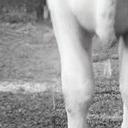



































































































time depending on how much is required in the blood.
“If you have got an animal entering the herd high in copper, and you reduce the amount of copper you are inpu ing, it will start to release more copper out of its liver and eventually the liver concentration will fall.
“So, it is not an ‘all is lost’ situation and there are a lot of farms which have high liver coppers working to reduce them.”
Phosphorus (P) is another commonly over supplemented mineral, largely due to high quantities being included in dairy cow diets, as a result of old research data.
“We now know the P requirements of dairy cows really well and I think we are starting to see the tide starting to turn on this, certainly feed companies are starting to reduce P in compound feed so farmers are pot-
rMake sure to include everything in your mineral audit or get someone else to do it – look at youngstock including milk replacer and starter feed
rLook at KPIs on the farm
Dr Williams’ tips to beat over supplementation Feed makers are reducing their phosphorus, so farmers might be reducing it without realising
– is there an area you would really like to improve such
entially reducing their P levels in diets without even realising.”
While over supplementing P does not a ect cow performance, it is expensive and impacts the environment through P excretion, says Dr Williams.
While iodine also does not impact performance, it is the potential impact on human health which needs to be considered.
“Iodine’s excretory pathway is through milk, so if you are
as milk yield or fertility, and could the current mineral status be impeding this?
rLook at what your cow is telling you
rLook at mineral sources being supplemented – some sources will be much more available than others
feeding a lot of iodine to cows, it will go into the milk, which then goes for human consumption.”
Dr Williams says there is large variability across retailers in milk iodine levels, which is all down to the iodine intake of the cow. She says if cows are excreting signi cant amounts of iodine into their milk, they are likely being over supplemented.
Dr Williams advises farms complete a whole farm audit to
DR ANNIE WILLIAMS
understand where they might be over or under supplementing ca le. She says: “I would always start by asking how much we are supplying and if we are meeting requirements. What quantity of minerals are you pu ing in via feed, forage and water?
“I do not want people to think that they do not need to add minerals, because most people do. But it is about making sure that you are ge ing the balance right, thinking about cost, environment, performance.”

Total mixed rations are an one way minerals get into the diet, but do not forget about licks, blocks and boluses.

Join us 6-7 November 2024 at the NEC Birmingham for FREE access to insightful talks, panel discussions, and workshops, to help you discover income-generating opportunities.
Topics include:
• How to best diversify your land, including Solar, Wind, Biodiversity Net Gain, Battery Storage, Grants, Camping/Glamping, Agri-Tourism, Housing, Carbon Credits and Forestation
• Advice and lessons learned from farmers who have started their diversification journey

John Gilliland OBE
DSc FRSA FRAgS, Advisor - Agriculture Horticulture Development Board (AHDB)

Alex Phillimore Head of Communications and Development - The Farming Community Network
• Real-life case-studies from landowners who have made a profit from diversifying
• Recent tax changes and how they will impact your business
And much more!

Antony Pearce Managing Partner - Dudley Peverill Associates LLP

Sarah Wynn Managing Director for Climate Change and Sustainability –ADAS

Roger Morgan Head of Farming and Rural - Farm & General Insurance Consultants
Plus, you’ll get free access to the talks and workshops taking place at our co-located exhibition, the Land, Leisure and Tourism Show!

Alternative fodder options and the ability to monitor and manage forage stocks will be key this winter.
Snapshot of forage stocks from Teagasc
Maize yields are expected to be widely variable this year, with harvest significantly delayed on some farms. But what does this means for this year and what are the implications for future crop planning?
The high winter rainfall, followed by the cold, wet spring, left little opportunity for soils to dry out sufficiently to allow growers to create the fine seedbed that maize requires for favourable establishment, says Andrew Cook, of maize breeder KWS.
He says: “A limited number of farms in milder parts of the country and with free-draining soils seized the short sowing window in April.
“In addition, some producers anticipated the possible problems ahead and selected early, or short-season, varieties, which require as little as 130 days to reach
58 ALTERNATIVES
Fodder beet and lucerne a solution for Wiltshire farm
62 HOLISTIC
Matching production to requirements
maturity, compared with about 150 days for mainstream types.
“In general, these crops have fared the best, but sowing continued into May and early June on some farms, especially where maincrop and late varieties had been selected.”
He says that the range of sowing dates for maize 2024 was one of the widest that has been noted for several years.
“The sowing delay meant many crops failed to receive the full number of heat units which maize requires for optimum development.
This has had a knock-on effect on
harvest dates, which in some cases are as much as a fortnight behind target.
“However, some maize crops have performed well under the circumstances, and this is likely to be linked to the rapid progress in maize breeding programmes in recent times.
“Cutting started as early as the second week in September on our favourable trials site in Gloucester, for example.”
Despite the issues over the

growing season, Mr Cook urges producers to wait until the crop is fully mature, wherever possible. He says: “There will be some situations where an autumn cereal is following maize in the rotation and there is a cut-off point for harvesting. Another consideration is possible soil damage as the weather deteriorates.
“Harvesting maize before full maturity carries risks, which include yield, as well as starch penalties, which in turn can reduce dry matter intakes.”
And faced with variable quality maize silages, Mr Cook says it is more important than ever to allow the newly harvested maize to settle for at least six weeks.
He says: “This year, it will be essential to carry out an analysis before new season maize is introduced to the diet, as a precaution to ensure the ration is fully balanced. It is always recommended that the crop is analysed at intervals, because starch degradability will rise over winter.”
Early varieties have grown in popularity in tandem with the increase in weather unpredictability, says Mr Cook.
“They were historically associated with a slight yield penalty, compared with more mainstream types. However, the genetic advancements in maize breeding have boosted their average yields and they can now compete with their rivals in the alternative categories.

“ ey also come with very good early vigour characteristics.
“Another key feature of early varieties is their capacity for rapid starch lay down as harvest approaches. At the same time, they have the genetic potential to dry down and reach maturity at an earlier stage compared with maincrop and late types.
“ is combination of qualities allows the opportunity for an early harvest. It has several advantages including optimised clamp fermentation, which can maximise livestock performance.
“A timely harvest also helps to protect the soil and avoid structural damage. I predict that orders for early variety maize seed will rise for next year as part of lessons which have been learned this season.”
e European corn borer, a pest which had been largely con ned to localised parts of Devon, Dorset and some parts of Kent, has been observed across a wider area this year, he says.
Mr Cook says: “It is advisable to include a check for corn borer damage, when monitoring crops
Harvesting maize before full maturity carries risks, which include yield, as well as starch penalties
ANDREW COOK
for harvest readiness in Hampshire, Somerset and Wiltshire, as well as in surrounding counties.
“ e telltale signs are holes in the maize plant stem, sometimes with a sawdust-like residue visible at the site. e opening is caused by the larvae burrowing into the stover and it can lead to weakness, with snapping in some instances.”
Corn borer larvae grow up to 25mm in length and their body parts are purple/brown in colour, with a brown/black head and a pale appearance to the base of the hairs.
If populations are le unchecked, adult moths with a wingspan of about 22-32mm will appear in June/July. ey are bu -coloured, with brown wing markings.
“ e options for control at this time of the year are limited, but destroying and burying maize stubble and trash will eliminate about 75% of corn borer larvae.
“As maize stubble can take up to two years to decay, careful crop rotation planning may become increasingly relevant.”

If populations are left unchecked, adult European corn borers will appear in June/July.




The latest national fodder survey, carried out by Teagasc across 650 livestock farms in Ireland, has show that 62% of farms have fully secured their winter feed (including one-month reserve). A further 20% show minor de cits of less than 10% of winter feed requirements.
Second cuts were reported as light in most parts of the country and this has further a ected feed reserves.
Of the remaining farms, about 6% reported signi cant de cits of 20% or greater, which is an improvement on a provisional survey which was carried out in June a er rst cut, which indicated an emerging de cit on a signi cant proportion of farms.
JThe provisional data in June had shown livestock farms were on average 10% behind target for winter feed requirements. This was contingent on achieving normal second cut yields and grazing season length. Results in June showed that about 25% of Teagasc farmer clients were at significant risk of feed deficits. This was consistent across the regions and enterprise type.
Data from PastureBase, a
Nonetheless, with some of these farms already feeding silage due to lower than target grass covers, there
grassland management tool, has shown a 1.2-tonne of dry matter per hectare (0.5t DM/ acre) reduction year to date, versus the five-year average.
The updated September Fodder Survey results now include second cut silage and most third cut silage crops. It also accounts for silage used to date due to below average growth rates and varying weather challenges in certain regions.
is concern that such de cits could well increase before normal winter housing date.
e survey also showed that half of respondents have already taken action to secure additional forage. And about 30% of respondents expected to have cash ow issues over winter as a result of having to purchase additional feed.
Other results from the survey showed that 60% of farmers intended to reduce stock to lower feed demand, such as empty or poor performing cows, and heavier ca le.
Only 54% of respondents had slurry tanks emptied at this point, so it is crucial that farmers take opportunities in the coming days
There is concern that forage deficits could increase before normal winter housing date.
to get slurry nutrients to the most suitable parts of the farm.
Commenting on results, Aisling Cla ey, Teagasc ruminant nutrition specialist, says: “Nationally, farms have made good progress since June in securing enough winter feed, but there remains a signicant number with shortage issues.
“We encourage all farmers to complete a fodder budget for their farm if they have not already done so; take early and appropriate action to secure fodder and/or reduce demand.
“It is important to test silage quality and prioritise the best quality silage for freshly calved cows and young growing stock.
“If lower grade forage is bought, ensure this is fed to cows during the dry period and reserve the be er quality silage for next spring.”
Tom Curran, head of advisory services at Teagasc, says: “While our client farms are broadly on target for winter feed, a signi cant proportion of farms need to be watchful of winter feed stocks in the coming weeks and months.
“We encourage all farmers to do their own individual fodder budget to assess the situation on their own farm, and to assess appropriate diet formulations based on silage quality and feeding value.”
• Premium Halo LED High-bay with 20W Red Night Light
• Provides 200Lux simulated daylight for indoor dairy lighting
• Durable, designed for harsh environments
• IP66 rated for dust and humidity
• Resistant to dust, water, and corrosion
• Handles temperatures from -40°C to 55°C
For a no obligation quote or more information please contact:

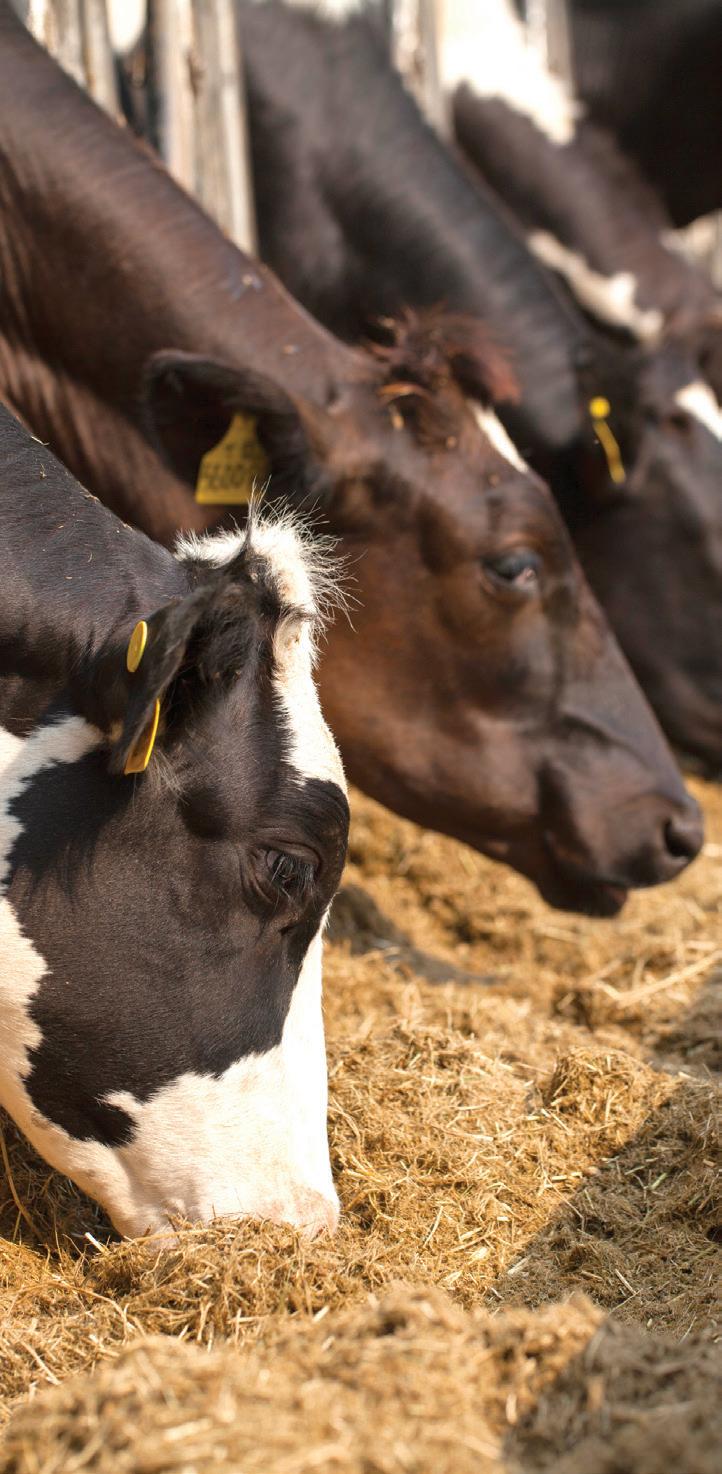









Grazed fodder beet is a cheap source of energy, while replacing some of the grass with lucerne has brought huge fertiliser savings on a Wiltshire unit. Wendy Short reports.


Aherd of 600 cross-bred cows, split into spring and autumn calving blocks, is managed by Anthony Mitchell at Wol all Farm, near Burbage, Wiltshire, where grazed fodder beet helps to extend the grazing season, and lucerne is grown as a good protein source for winter milk production.
A lack of summer grass due to droughts is one of the main challenges on the unit and for this reason, the size of the autumn calving herd is being increased to achieve a 50:50 numbers split.
Along with the provision of fodder beet and lucerne, calving in a tight six-week block has also helped to alleviate the problem,
while another measure has been to delay the spring calving period until March. e combined changes are expected to boost yields to about 6,500kg says Mr Mitchell.
e mixed farm, which is owned by Tom Blanchard, operates a 175-hectare (432acre) grass grazing platform, supplemented with lucerne,
maize and grass silage grown on an additional support block.
e fodder beet is allocated to a platform that is mostly grazed by the spring calvers from March until the end of December/beginning of January.
e grazed fodder beet has greatly helped to extend the season, which currently stands at about 330 grazing days, says Mr
Mitchell. e soil on the unit is mainly a green sand and the fodder beet slots into a rotation of grass; fodder beet; maize; grass. A mix of Italian ryegrass, clover, plaintain and chicory is used for the autumn grass reseeds. Some 6ha (15 acres) of Geronimo, a fodder beet variety bred speci cally for grazing, were sown this year. e area




Farm facts is divided into small sections using electric fencing.
“Grazed fodder beet is an excellent feedstu , and it is also used for the autumn calvers for a couple of hours a day during November and December,” says Mr Mitchell.
“Crop dry ma er [DM] is carefully monitored and each cow is awarded a daily area of fodder beet containing a target 5kg DM/head.
“ is follows a couple of weeks when the cows are transitioned on to the crop, with the aim of ge ing them to feed consumption target, rather than using a set measurement of land.
“Overall, the fodder beet will produce about 30 tonnes of DM/ha and for example, 3ha of grazed fodder beet will feed about 250 cows for eight weeks.”
Fodder beet benefits
Mr Mitchell says he o en is asked whether the cows get dirty on the fodder beet, but he says the answer is no because the crop is fed strictly on an ‘on/o basis’.
He says: “ ey enter the grazing area, eat their allocation and are then moved on to grass paddocks, with reference to the rotation planner.
“Fodder beet could be considered expensive to grow but in my view is relatively cheap,


r600 cross-bred cows achieve a 5,600kg yield average at 4.8% butterfat and 3.7% protein
rMilk from the spring and autumn calving blocks is sold to Wyke Farms for cheese-making and a constituents contract will be in place this autumn
rWolfhall is an AHDB strategic dairy farm
in terms of DM energy production per ha, highly palatable to the cows and especially useful to boost late lactation production.”
e soil is tested before the fodder beet seed is sown in about March, with the land prepared using a plough, rolled if necessary and power-harrowed, as well as being given a pre-emergence herbicide application. e seedbed is also rolled post-sowing, to maximise seed-to-soil contact and preserve moisture.
Total fertiliser inputs for the crop comprise 200kg/ha (80kg/acre) of agricultural salt,143kg/ha (58kg/ acre) of nitrogen fertiliser, 90kg/ ha (36kg/acre) of potassium and 50kg/ha (20kg/acre) of sulphur.
e fodder beet will also be given three additional herbicide














“Saxon’s improved vigour meant it was greener at harvest and it out-performed our other varieties.”
Nigel Harper, Cheshire



applications, plus an insecticide, before canopy closure.
And a move to replace some of the grassland with lucerne has saved the business an estimated £20,000 a year in fertiliser costs, he comments.
“Unlike grass, lucerne has no chemical nitrogen fertiliser requirement. It makes use of its own nitrogen xing capabilities once it is established, although it will receive a light dressing of potash if it is felt necessary,” he says.
“One possible plan for the future is to add dirty water from the slurry system, to give the plants a nutrient boost.
“ e idea was to produce more home-grown protein and to grow a crop that was more resistant to summer droughts compared with grass.
“ is is the second year of growing lucerne; the rst year saw 70 acres sown. A er its po-
tential bene ts were recognised, some 50 acres were put down in the autumn of 2023.”
He says in his opinion, lucerne is a highly underrated crop.
“It has a protein percentage of about 20, with a silage dry ma er content of roughly 40%; the gure for last year’s lucerne silage was 38%.
“It follows autumn cereals and although it can look untidy in the spring, it thrives as the season progresses.
“Some white clover was added to the seed mix last time. It has proved useful because it acts as a weed suppressant.”
Lucerne agronomy starts with a light min-till operation using a Sumo Trio, before spring drilling into a clean stubble.
e rst 2024 cut of lucerne was taken on May 10, followed by two subsequent cuts for the clamp.
erea er, two further harvests will produce bales for the
youngstock. e clamped material is ensiled using a biological additive the day a er mowing and it is stored in a separate clamp from the grass and maize silages.
e jury is still out on the persistence of lucerne, due to its relatively recent introduction to the cropping plan at Wol all.
“ e initial expectation was for a three-year cycle, but having


gained experience over two seasons, it may possibly last for a fourth year, and it will be followed by wheat. I would urge growers to stick with lucerne, as long as the land is suitable, because establishment was not particularly impressive in the rst year of growing. It was not until year two that it has come into its own and it now has a rm place in the rotation,” says Mr Mitchell.
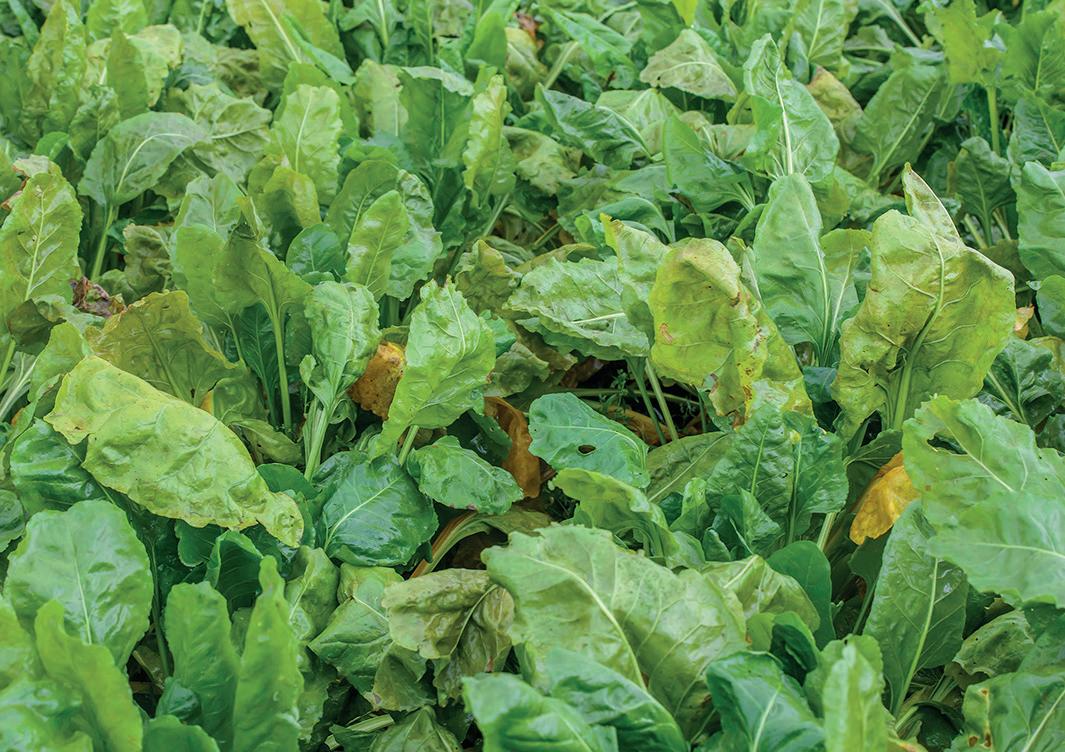



As the saying goes, cows are able to turn ‘grass into gold’ and the dairy cow’s ability to earn her keep by transforming lush, green grass into litres of liquid is what farmers rightly focus on.
But Janet Montgomery, agriculture product manager at Barenbrug, says in changing times farmers can no longer be complacent.
She says: “This is because we are not ‘farming from a can’ any more. We must wean ourselves off the ‘one-size-fits-all’ grass strategy we were always encouraged to adopt.
“Today’s dairy farming – not least because of the economic and environmental pressures we face –demands multi-faceted, data-driven, bespoke solutions, devised to extract the most value and deliver the best return for each individual farming enterprise.”
As a result, Barenbrug is beginning to direct its focus towards the concept of ‘farm fodder flow’.
Ms Montgomery says: “Put simply, it is how we can adequately match the farm’s productive capacity to the animals’ dietary
Farmers are being encourage to adopt a more holistic approach to on-farm feed management by grass breeder Barenbrug, with the company urging farmers to recognise that home-produced feed will always be more beneficial to the bottom line. Dairy Farmer reports.
requirements, through careful planning, assessments and projection.
“Adopting a basic farm fodder flow plan helps to address and mitigate concerns about placing too much reliance on home-produced feed, while reducing the need to expensively fill the holes in the feed programme with bought-in concentrates.”
Ms Montgomery says this plan, if done well, can also smooth a farm’s labour requirements over the course of the year, not to mention deliver a higher quality of feed throughout the year too.
She adds that the process should
be considered as a ‘back to basics’ approach.
She says: “Ask yourself: What are your production goals? Are they sufficient? Where, or how, do you need to make changes?
“You are going to measure these goals as litres of milk, primarily – but your outlook must be holistic, so do not ignore the goals from any other enterprises, such as kilos of beef or the numbers of store lambs sold.”
Ms Montgomery says the answers to these questions will be different for every farm, influenced by breed, input levels or labour availability, for instance.

She says: “Armed, or re-armed, depending on how recently you last looked at production goals, with this information, which should reveal all the animals likely to be on your farm, in every category, for every month of the year, you can work out your whole-farm demand.”
And then she says the big question is whether the livestock class and quality – or the aspirations for them – are a match for the available grass.
Ms Montgomery says: “Do your peaks in demand match the peaks in supply? Inevitably, most farms will see a mismatch between the supply curve and the demand curve [line 1 of graph]. Equally, most farms will already have taken steps to even out that curve for silage [line 2].”
But she says this is where the ‘farm fodder flow’ philosophy takes farmers a step further.
She asks: “Can you do better silage? Or can you do better than silage, and fill in yet more of the demand with alternatives?”
Changing the way you produce silage can make a significant difference, according to Ms Montgomery. She says: “That is because farm fodder flow is not just about quantities, but quality too. If your silage strategy has always been built around two cuts, you could be pleasantly surprised to discover how a four-cut approach could benefit your bottom line.
“When cows are offered silage from a four-cut system, they respond with higher dry matter


intake, increased milk yield and improved bu erfat and protein.
“Even without changing to a newer, four-cut capable variety, there are other ways to get more from your grass.
“ e most obvious, and easiest to enact, is to practise grass indexing to help you identify the elds that need ‘maintenance’ – overseeding or reseeding – as well as those which will be most e cient in providing the bulk of your surplus for conservation.”
Ms Montgomery says this approach will also mean farmers can understand the individual nature of each of their elds, and therefore create an appropriate ranking system.
She says: “For instance, do not waste time and e ort and inputs on a empts to improve elds which will only show marginal returns. Instead, turn to the top-performing elds where there are fewer limiting factors, such as soil type or draining.”
And Ms Montgomery says
farmers should not be afraid to think beyond silage.
She says: “ ere are some exciting and useful options, for example, in turning to short rotation crops such as winter brassicas [as shown by line 3], or Italian ryegrass and forage rape. ese give you exibility – it is easy to switch in and out of them – while also providing a di erent plane of nutrition.
“And these short-term rotations can be very helpful in a grass rotation. It is a fantastic opportunity to tackle pernicious weeds, they provide the all-important break crop, and can also push you closer to that ‘holy grail’ a ainment of managing a 10-15% annual reseeding rate.
“Both labour and machinery utilisation can also be brought into the equation.”
Ms Montgomery says ‘farm fodder ow’ is about changing your mentality, but she says it is not a wholesale change and should be viewed as an improvement and a tightening up of what farmers are already doing.
She says: “It is a very approachable way of ensuring that you are prioritising home-grown feed – and acknowledging its superiority, in terms of providing not just
nutritional content, but also good quality roughage – which should be your single most important goal in managing a pro table dairy herd.”

As well as trade stands, this year’s Dairy Show once again hosted cattle classes and seminars, with this year’s theme being ‘careers’.
After the original round of judging by the panel of six breed judges for the overall championship at this year’s Dairy Show, the Holstein and Jersey winners were tied on 46 points.
However, after looking at the number of 10s that each scored, it was the Holstein, Richaven Byway Kay, owned jointly by Richard Brown and Mike Potter, which just edged it to take the win.
The cow resides with the Richaven herd, Upton-upon-Severn, Worcester, and is part of the 80-cow herd. This was the first time in 15 years that Richaven cows have been at the Dairy Show.
Classified at EX95, the November 2018-born fourth calver is an Oh-River-Syc Byway daughter, which calved down in March and is back in calf to Delta Lambda again. It was shown giving 50kg.
Taking the overall reserve interbreed ticket was the winner of the National Jersey Show judging, Rivermead Casino Ceres, which took the inter-breed heifer title before claiming reserve overall for the Davis family, Tiverton.
The home-bred January 2022-born heifer is an Elliots
Winners of the breed championships battled it out before the panel of judges at this year’s Dairy Show, at the Bath and West Showground, Somerset, with the final judging coming down to a nail-biting finish. Ellie Layton reports.
Regency Casino daughter out of Rivermead Rufus Ceres, which itself was reserve champion at the 2022 Jersey National Show.
This VG86 classified heifer has had a successful year placing fourth at UK Dairy Day, reserve breed champion at Royal Cornwall Show, champion Jersey at Devon County Show and reserve Jersey champion at Honiton Show.
Back in the Holstein ring, the reserve went to another from the Richaven stable, from Richard

Brown. Richaven Jordy Stocking won its junior cow class after calving down at the start of September and was shown giving 46kg.
This April 2021-born cow is a Cycle Mcgucci Jordy Red daughter and is classified VG85.
The Holstein heifer champion, Wowcow Lambda Roza, from Ben Yates, Shepton Mallet, took the reserve inter-breed heifer champion title. This July 2022-born heifer is a daughter of Topfarm Euclid Roza.
Standing reserve in the Jerseys
was Glanmor Matt Iowa from the Warren family, Penzance. The intermediate cow is a July 2017-born daughter of Wilsonview If Matt.
Les and Tracy Rockett, Devon, took the champion title in the any other breed section, with their Friesian.
Carmarthenshire judge, Iwan Thomas, said he was looking for a structurally sound cow which would perform in a commercial system. His winner was Greenway

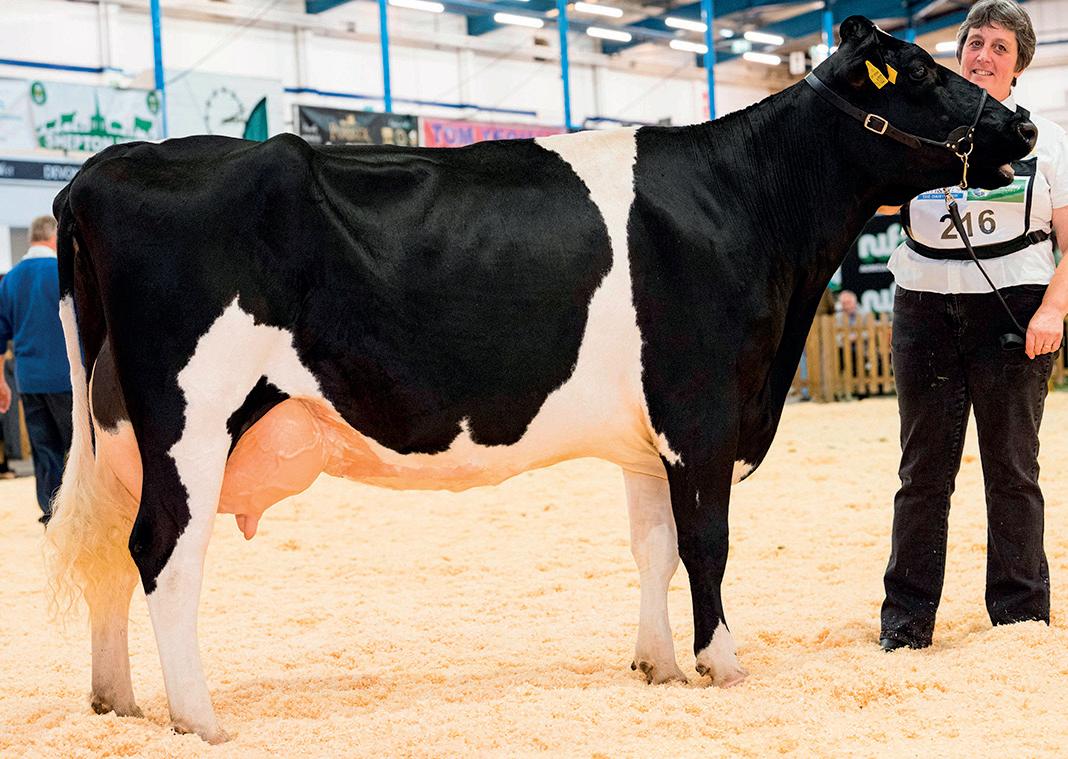

Bombardier Billie, which took the reserve title at last year’s show.
e Aintree Bombardier daughter was second at the All Breeds All Britain Calf Show in 2021.
Reserve Friesian was Greenway Jackpot Liv from Sam Owen, Okehampton. is one was bred by Les and Tracy Rocke and is by Nerewater Jackpot.
e Dairy Shorthorn championship was awarded to the junior cow, Brimclose Jean 9 from David and Sarah Slade, Devon. Second at last year’s show, this Bushmills Jazz daughter scored 44 points in the inter-breed judging to be placed third overall.
Reserve Dairy Shorthorn was second placed junior cow,
Churchroyd Nicola 34, which was rst in its class at last year’s show. Bred and exhibited by the Collins family, Yorkshire, this March 2021born cow is a daughter of homebred sire, Churchroyd Koala.
Ayrshire judge, Linda Ba y, Derby, chose Wroughton May ower 2
as her champion, coming from regular exhibitor, Mike Windel, Swindon. is cow is part of Mr Windel’s 185-cow Ayrshire herd and was one of his three exhibits, all receiving a red ticket. e EX92 classi ed intermediate cow is sired by Wroughton Lord Winston and is producing 36kg daily. Reserve was awarded to Robert


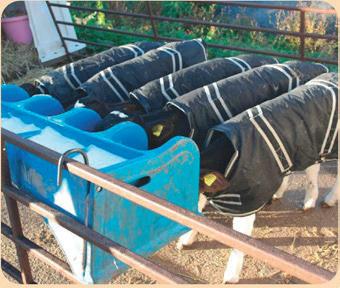

•








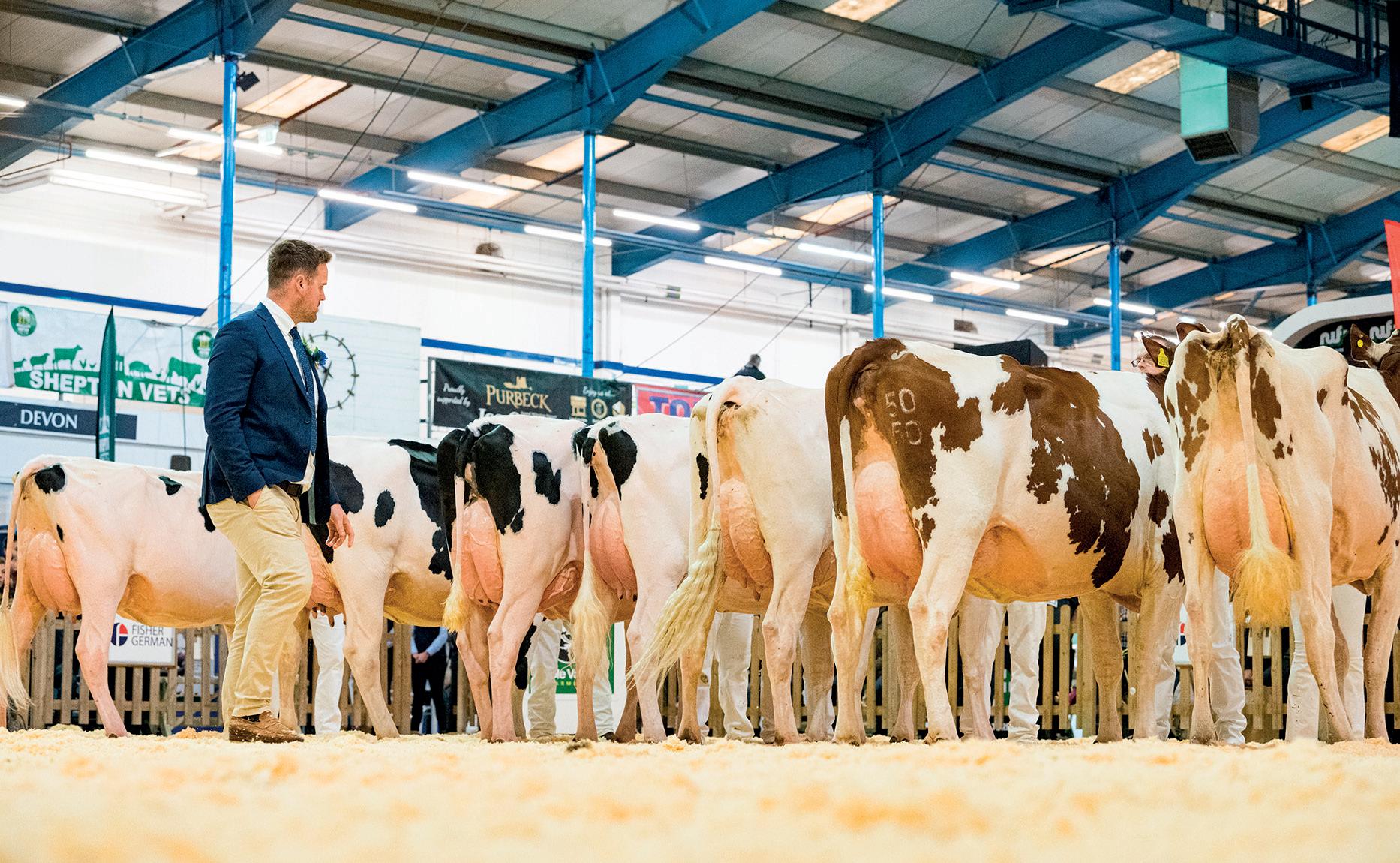
Cornish and family, Tiverton, with Bu erbesley Pearly Marigol, an August 2020-born junior cow sired by Bu erbesley Pearly King. The junior cow in milk, Trewarnevas Curley Amanda,
JThe calf show, which is held on the eve of the main cattle show echoed the results of the overall inter-breed judging with the Holstein standing champion and Jersey reserve.
The champion was Eastnook
a Briddlesford Harebells Victor daughter from P. Bottom, Truro, took the championship ticket in the Guernsey judging. This follows its success at UK Dairy Day in September, where
Detective Gem 2, bred and exhibited by Eastnook Holsteins. This Blondin Detective daughter was one of the youngest calves across the competition, born at the end of January this year.
Reserve went to Mydrim


it was awarded honourable mention.
The 2018-born Glanmor Levi Okapi, a third calver from Michael Dawes, Banbury, took the reserve spot.
Chocochip Ceres, from James Evans, Carmarthen.
This July 2023-born calf was the youngest in its class.
It is by Avonlea Chocochip JNSF and is out of the show cow, Mydrim Tequilas Ceres.
rInter-breed (panel of judges) Supreme, R. Brown and M. Potter, Richaven Byway Kay (Holstein); Reserve, Davis family, Rivermead Casino Ceres (Jersey).
rJersey (S. Borland, Canada) Sup., Davis family, Rivermead Casino Ceres; res., Warren family, Glanmor Matt Iowa.
rHolstein (J. Doherty, Shropshire) Sup., R. Brown and M. Potter, Richaven Byway Kay; res., R. Brown, Richaven Jordy Stocking.
rDairy Shorthorn (D. Madeley, Shropshire) Sup., D. and S. Salde, Brimclose Jean 9; res., Collins family, Churchroyd Nicola 34.
rAyrshire (L. Batty, Derby) Sup., M. Windel, Wroughton Mayflower 2; res., R. Cornish, Butterbesley Pearly Marigol. rGuernsey (L. Batty) Sup., P. Bottom, Trewarnevas Curley Amanda; res., M. Dawes, Glanmor Levi Okapi.
rAny other breed (I. Thomas, Carmarthen) Sup., L. Rockett and T. Marshall, Greenway Bombardier Billie Jean (British Friesian); res., S. Owen, Greenway Jackpot Liv (British Friesian).

Director of Cultura and part-time farmer Hugh Pocock said some farming businesses could become consumed by looking for the right candidate for a position at the expense of presenting themselves as an attractive workplace for prospective employees.
Mr Pocock said: “Labour shortages in the UK are currently at an extreme, with a 48% decline in avaliable agricultural workers in the past seven years, greatly affected by 200,000 EU nationals removed from the job market following Brexit.
“This is coupled with a change of working attitude following the pandemic, with applicants searching for a more flexible working attitude. Many farmers are finding it tricky to find and retain staff in a sticky job market.”
Since 2000, there has been a decline in UK dairy farms from 25,000 to under 10,000, and Mr Pocock said this also had a knock-on effect on the pool of candidates for farm work.
He said: “Many farms would see only one child stay and carry on in the farming business, with siblings with an agricultural background seeking work in the wider industry. However, the decline in farms has removed many of these candidates.”
Mr Pocock said building a company culture might sound complex, but small, simple steps could make a farm look much more attractive to potential candidates.
Often, the first impression a candidate will get of a business is before they step through the farm gates. Therefore, Mr Pocock said creating

This year’s seminars at The Dairy Show helped guide farmers through the topic of recruitment, sharing tips for retaining and dismissing staff successfully to help their businesses progress. Ellie Layton reports.
[Farms] with a good reputation are more likely to attract proactive applications
HUGH POCOCK
a positive company profile and culture was vital to attracting people to apply or show interest in joining a business.
“Creating a business Facebook page or website, with updates of farming practices and any team activities – such as farm walks, pub socials or even celebrating someone’s birthday with a slice of cake – can instantly make a place look more attractive to work,” he said.
“It may sound obvious, but organisations with a good reputation as an employer are more likely to attract proactive applications from quality candidates.”
Job adverts should be clear, concise

and most of all, realistic, he said.
He added: “Although pay is a swaying factor for many applicants, training and flexibility is a huge deal for people. No false promises and transparency should be given from the outset.”
When it comes to adequate pay levels, Mr Pocock said seeking agency advice or connecting with local farmers could help with this.
“Where on-site housing is not an option, or desired, housing allowance has become a popular option for employers to offer,” he said.
Once an applicant has been offered the job, regular communication should be made before their start date, said Mr Pocock.
Connecting with a new starter by inviting them to the farm or to meet the team prior to their start date could help reduce the chance of an applicant dropping out or being ‘poached’ before they start, which he said was more common than realised.
He also said an effective induction was something that could inspire a positive work attitude.
Regular one-to-ones, starting at the end of the first day, then the first week and then monthly, would not only help in giving feedback to workers, but could also be a chance for the employer to receive feedback, and could reduce any stigma around conversations and help with addressing issues quickly.
Mr Pocock also discussed the use of incentives as a way to help keep staff morale high, and he said it was useful to give employees an
area to take responsibility for. For example, an employee could have responsibility for the calf shed, and if they lowered or retained calf mortality at a certain level, they could be rewarded, whether it be with a financial bonus or in another way.
“This has proved more effective than a straightforward pay rise, as studies have found increased pay will only keep employees satisfied for a six-month period,” he added.
While recruiting can be difficult, Tess Howe, head of partnerships and policy at The Institute for Agriculture and Horticulture, said that helping people to develop in their roles was valuable for both parties.
She said: “New studies show younger workers may have up to 20 jobs in their professional lifetime, working at a company for around two years. This means employers must adapt and invest in workers to get the most out of them while they are on-farm.”
She said farmers needed to appreciate that investing in someone would pay off in the quality of work they would deliver.
When it comes to people changing their path, farmers should not be afraid to remove someone from a post if they are not a fit to the business.
Ms Howe said: “It is important to remember that this is also a vital part to the business culture. The way that this is dealt with will be part of how a business looks to prospective employees, and care and respect should be given.
“A company’s aim should not be a forever workplace, but a well-respected one.”
Shown as part of the Dutch businesses Yellow Revolution
reviewed in Lely’s trademark prototype yellow instead of the brand’s ubiquitous red, the Juno Max was recently introduced at the rm’s Yellow Revolution event.
Held on a four-yearly cycle, these events are used to preview new products and ideas the business is developing.
e Juno Max has been developed to operate alongside the existing Juno J2 feed pusher and will incorporate a larger range of sensors to interpret its environment and o er autonomous working.
e 54-volt lithium-ion battery electric unit operates with drive to
to the 15% limitation o ered by the smaller machine.






each of its three wheels which is claimed to provide much greater tolerance to uneven surfaces between buildings, and also allows for the unit to traverse slopes of up to a 20% gradient, compared









SOLE


Unlike the J2 which operates with a tracer system within the building layout, the Max uses a combination of light detecting and ranging (LiDAR) sensors and stereo vision cameras to detect obstacles and measure existing feed volumes at the feed fence.
is can be used to plan the supply of feed with the Lely Exos or Lely Vector feeding systems.
Alongside the stereo camera, high intensity LED lighting provides the ability to work in complete darkness and travel in unlit areas between buildings.
Prior to operation of the unit, the entire farm area it is required to work is 3D scanned with a handheld device. is creates a virtual map of the farm and is uploaded into the unit’s control system.
Operating with this map and in conjunction with an encoded sensor within the wheel motors, the unit can determine where it is within the site, removing the need for a direct GPS RTK link – something of a challenge in a steel-framed building.
Once the farm map is created and operated using a smartphone app, farmers can add, modify or pause di erent feed pushing routes throughout the site depending on the location and density of di erent groups of cows.
It also allows users to remotely send the Max out of a building or return it to charge if encountering other vehicles around the site.
Lely says the combination of the larger ba ery, higher travel speed of 1.2 metres/second and


�
�
�




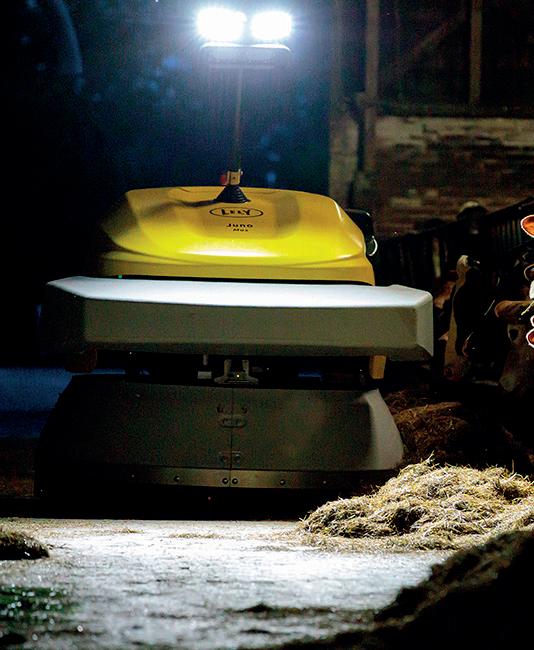

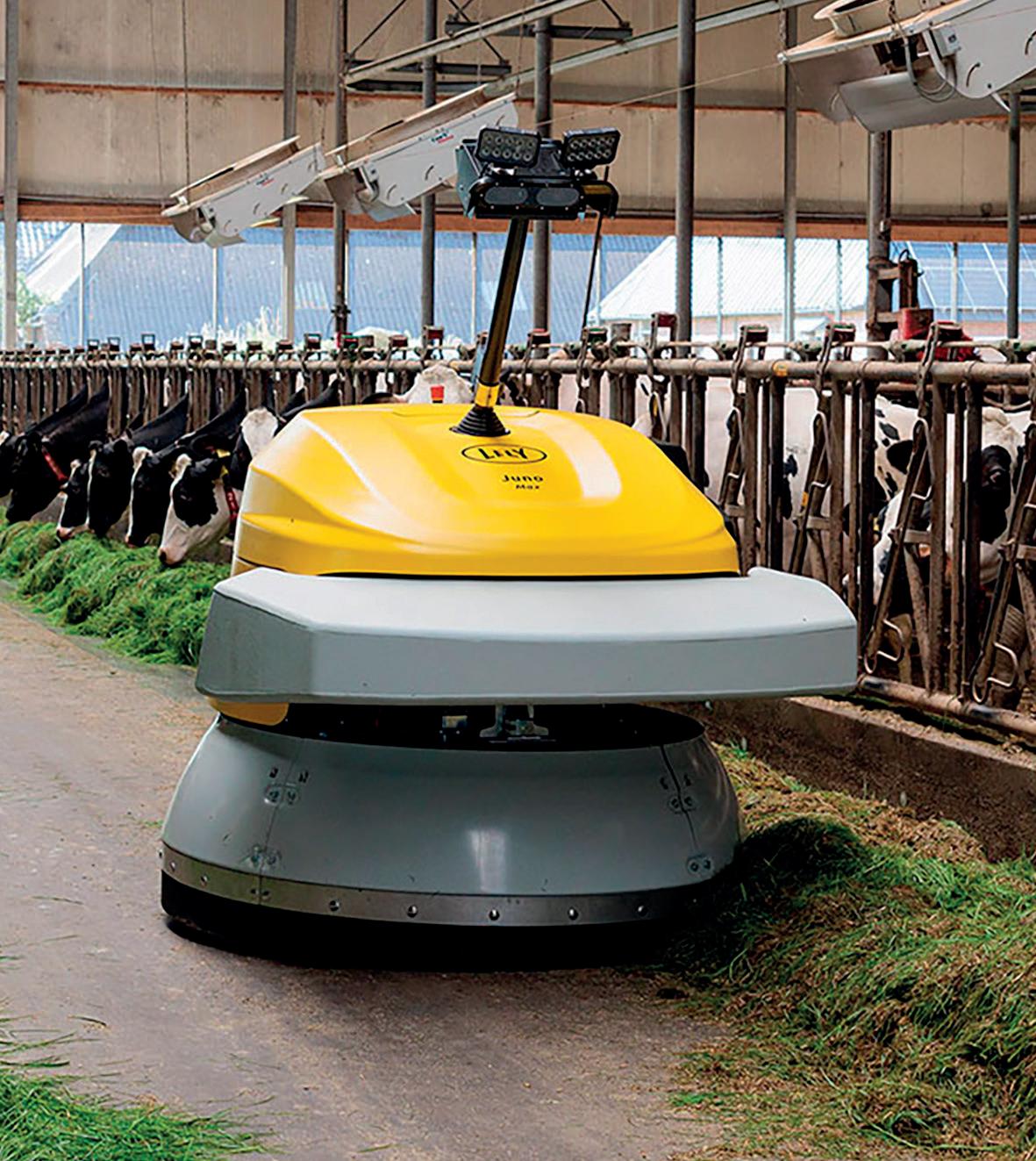

autonomous navigation allows the Max to travel up to 3km per charge – three times the travel distance of the J2 – and to push feed for farms with 800 cows or more.
Lely is testing the machine on 12 farms milking 150-700 cows and installations are taking
place on 1,000-plus-cow units for further validation. Currently, the Max can o er a one hour and 10 minute run time, with a 2:1 driving vs. charging ratio, which re ects as 16 hours driving and eight hours charging in a 24-hour period.
Lely acknowledged that
Manufacturing & installing rope scrapers for over 25 years
• Ideal for sand laden slurry
• Timer clock to schedule cleaning
• Easy control system
• Lowest cost maintenance
• 5 year extended warranty available
For a no obligation quote or more information please contact:




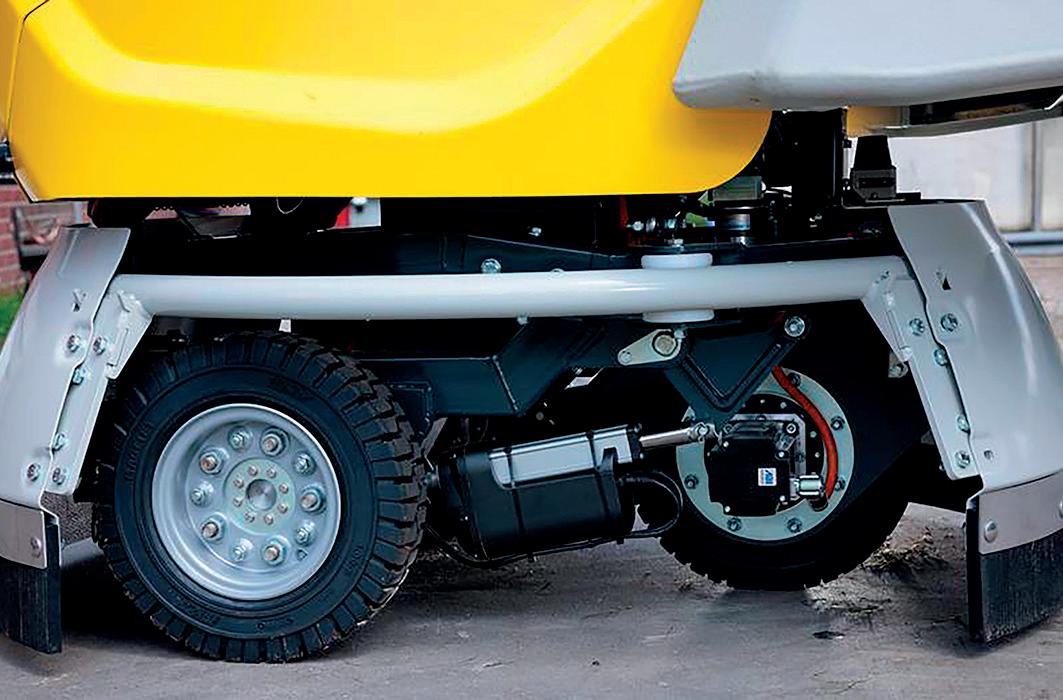
although the focus of the Juno Max is large herds of more than 800 cows, the autonomous and variable route technology would be of equal value to smaller farms with di erent buildings of varying size with stock groups held in them depending on the season – or even the weather.
Once established and proven, the autonomous technology is likely to migrate to the smaller machines at some point, par-
ticularly considering the variable terrain travelling capabilities of the Max would suit smaller dairies without acres of pristine concrete. e Max is expected to be available commercially from 2027 and will be launched with 24/7 online support, which Lely claims will remotely resolve 90% of issues remotely. Prices have yet to be announced. However, the Max is expected to be at least double the cost of a Juno J2.

Held every two years at Hannover Messe, EuroTier runs on November 12-15 and provides a launchpad for the latest technology. Chris McCullough outlines some of the dairy farming innovations that will be on show.
JStrautmann is launching the Primus 600 self-propelled feeder wagon powered by a 205hp FPT engine.
The unit operates with a mixing volume of 17-22cu.m and incorporates a newly designed Smart Feed Cab with cameras at the rear of the wagon and in the mixing auger.
A new feed control system enables direct access to all important machine functions, including weighing device, machine information and camera monitors.
Steering control with fourwheel steering, crab steering
and tail swing suppression are now standard equipment elements.
Operating with a pickup width of two metres from a fodder height of up to 5.5m, the conical funnel behind the milling cutter ensures fast material flow to the elevator mounted behind the milling cutter.
The two mixing augers claim to provide a fast, homogeneous and smooth mixing process within the machine.

JUrban SipControl is a system to manage the welfare of suckling calves at automatic feeders by recording the animal’s sucking strength and swallowing processes through using a high-resolution inductive flow sensor to scan the pulsating volumetric flow that occurs in the suction line.
During the drinking process,
the number of swallows, the volume consumed per swallow and the calf’s sucking strength are recorded.
The length of the suckling process can be adapted to the individual animal as required.
Deviations from the animal’s individual sucking patterns can also be used for predictive health monitoring.

JTrioliet has doubled the maximum capacity of its Triomatic feed robots to 6cu.m on the new WP 2 600 model. The new machine has a maximum load capacity of 2,000kg, claiming to make it more suitable for the bigger farms with 600-800 cows.
Using the Trioliet Batch and Traffic manager, it is also possible to scale the system’s capacity to a maximum of four robots, making automatic feeding accessible for farms with 1,200-2,500 cows.
The mixing tub of the
Triomatic WP 2 600 is equipped with two vertical augers made of wear-resistant stainless steel.
Energy is saved on the Triomatic WP machines when dispensing, as only the auger closest to the discharge gate is activated. The second auger is only engaged when the feed amount falls below a certain level. Discharge is delivered via a cross conveyor belt.
The feed robot is loaded by a Trioliet feed kitchen of choice, including the Triomatic T10, T20, T30 or T40.

JTaking one of the four EuroTier gold medals, awarded by the DLG Innovations Commission, was a new airflow system designed to keep dairy cows cool while reducing the effects of heat stress.
Fresh outdoor air is sucked into the animal
housing via a hose ventilation system and forwarded into the cubicles under pressure with the air forced directly into the lying area at an angle of 45-degrees from five openings drilled in the upper cubicle bar.




JDutch company Spinder Dairy Housing Concepts won silver for its Spinder Track sliding gate system, which can change the space available to cows in a building. The system is designed so it can be operated and locked
in the desired position by one person, with Spinder saying the new gate can be installed in newly constructed barns and retrofitted in existing barns. It can be adapted to the respective specifications of the barn.






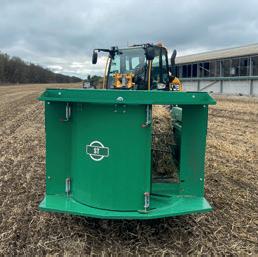

J e early October pullback in price levels from the record bu er and cream prices, including some of the higher moisture cheeses, such as mozzarella, may be deemed to have arrived a li le prematurely.
Nevertheless, a modest correction from the giddy heights witnessed through September may not be a bad development, as it may help lead to more realistic and sustainable price levels moving into winter.






















While some milk buyers have taken the opportunity to sit back and hold their milk prices to see if markets come back to meet them, others who are lagging behind with some catching up to do, or who are still embroiled in recruitment ba les, in particular the South West, have pushed on with sizeable price increases.
In the meantime, normal order is being resumed with Arla Foods now shi ing up through the gears with its milk price increases, announcing a further 2 euro cents/kg (1.7p/kg) increase for both conventional and organic milk for October.
e company says the increase is being driven by the strong demand by fat heavy products and is also fuelled by the current lower milk volumes traditionally associated with this time of year and limited availability of fat in the EU.
Overall, they put the outlook as being slightly positive. Another co-op making signi cant price moves is that of Dale Farm in Northern Ireland. With its monthly pricing a month in arrears, the company will have delighted members in the middle of September to learn their milk price for August was to increase by 3ppl. is increase puts their price on a very competitive footing to become our highest manufacturing milk price for that month.
Following its 0.5ppl increase for July, the additional 3ppl takes our manufacturing milk price up to 43.42ppl (42.32ppl for liquid), pushing the overall increase for the year to date to 6.2ppl, not to mention 11ppl higher than the price paid for the same month last year.
Rounding up the latest price moves from the other co-ops: First Milk increased its November milk price by 1.25ppl to 43.85ppl for manufacturing, with the Haverfordwest Tesco Group price up by the same amount to 45.35ppl; South Caernarfon also increased by 1.25ppl to 43ppl (manufacturing), which was worth 1.2ppl to 41.51ppl on
standard.
Stephen Bradley on the latest milk industry developments.
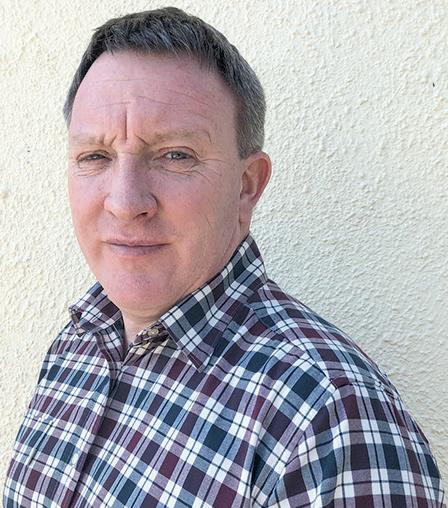
JWith Muller increasing its milk price for its Muller Directs by 1ppl for November to 42.25ppl, then for our liquid standard, 42ppl realistically becomes the new benchmark target.
While some who have not moved their milk price for November may already be at this level or slightly below, more
familiar premium payers are already well clear of this level whether buying their milk for liquid processing or manufacturing.
Staying with liquid, Crediton Dairy increasing by 1ppl for November takes our liquid price up to 42.75ppl, while Pembrokeshire Dairy’s increase of 1.2ppl takes our price up to 43.54ppl.
JThe competition for milk supply in the South West shows little sign of abating at present, with Barber’s Cheesmakers increasing its November price by 1.54ppl to 44.57ppl for manufacturing (43.07ppl liquid standard), with this increase also being a guaranteed minimum and therefore possibly subject to further upward revision.
Wyke Farms has responded with its 1.54ppl increase to 44.49ppl (43ppl liquid), while Saputo Dairy UK, perhaps not quite in the middle of the Somerset/ Dorset recruitment cauldron, increased its
Davidstow price by 1ppl to 43ppl (41.46ppl liquid), while its Wensleydale price increased by 0.81ppl for October to 42.36ppl.
Other cheesemakers reaching the 43ppl level for manufacturing standard include Parkham Farms, after its 0.5ppl uplift, and Leprino Foods, following its 1ppl increase, both paying 41.32ppl and 41.53ppl, respectively, priced against our liquid standard.
Belton Farm increased by 1.5ppl to 42.55ppl for manufacturing, which equates to 41.8ppl for liquid.



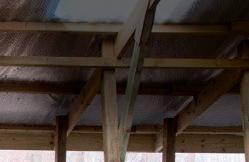


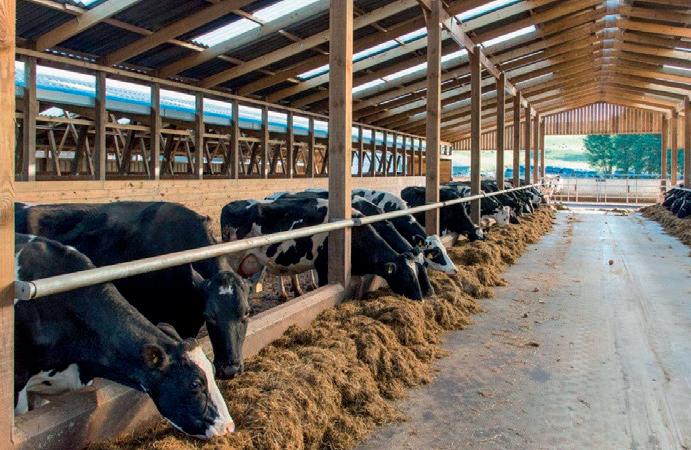
Shelter from Wind & Rain • Shade from the Sun • Plenty of Fresh Air • Ample Space
• Minimum Draught
• Many options available



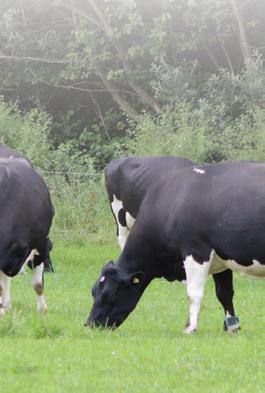



‘B’ Price Indicators
*StoneXMilkprices.com UKMFE (net)
**Delivered spot milk (net to the producer)
Notes to table
Prices for both Liquid & Manufacturing tables paid for a producer sending 1mltrs/yr on EODC (max vehicle size accessibility) with Bactoscans of 30,000/ml and SCC’s of 200,000/ml with Thermodurics of 500/ml. Excludes capital retentions or AHDB levies, profile adjustments from level supply, seasonality, balancing and A&B price schemes (includes the winter premiums paid in NI). Excludes annual / part annual growth incentive schemes or supplements not directly linked to dairy market price movement. Liquid price for milk contains 4% b/f and 3.3% protein. Manufacturing price for milk containing 4.2%/b/f and 3.4% prot. All prices for non-aligned prices are before monthly retail supplements. (i) Jun’24 prices before seasonality or B pricing (ii) Jul’24 prices before seasonality or B pricing (iii) Table ranked on simple rolling 12mth average of monthly prices Aug’23 to Jul’24. (i) v (ii) The difference Jul’24 compared with Jun’24. UK Arla Farmers 0.43ppl increase for Jun’24 includes 1.366ppkg (1.407ppl) Sustainability Incentive and Guaranteed minimum supplementary payment of 1.243ppkg (1.280ppl) based on our liquid std litre. UK Arla Farmers 0.44ppl increase for Jun’24 includes 1.426ppkg (1.469ppl) Sustainability Incentive and Guaranteed minimum supplementary payment of 1.296ppkg (1.335ppl) based on our manufacturing std litre. UK Arla Farmers 0.78ppl increase for Jul’24 includes 1.366ppkg (1.407ppl) Sustainability Incentive and Guaranteed minimum supplementary payment of 1.243ppkg (1.280ppl) based on our liquid std litre. UK Arla Farmers 0.81ppl increase for Jul’24 includes 1.426ppkg (1.469ppl) Sustainability Incentive and Guaranteed minimum supplementary payment of 1.296ppkg (1.335ppl) based on our manufacturing std litre. First Milk price includes 0.5ppl Member Premium accrued as a 13th payment paid Apr’25. First Milk Haverfordwest Tesco Cheese Group includes 2ppl retailer premium averaged as
Sustainability Incentive and Guaranteed minimum supplementary payment of 1.296ppkg (1.335ppl) based on our manufacturing std litre. UK Arla Farmers 0.85ppl increase for Sept’24 includes 1.639ppkg (1.688ppl) Sustainability Incentive and Guaranteed minimum supplementary payment of 1.243ppkg (1.280ppl) based on our liquid std litre. UK Arla Farmers 0.89ppl increase for Sept’24 includes 1.711ppkg (1.762ppl) Sustainability Incentive and Guaranteed minimum supplementary payment of 1.296ppkg (1.335ppl) based on our manufacturing std litre. UK Arla Farmers 1.62ppl increase for Oct’24 includes 1.638ppkg (1.687ppl) Sustainability Incentive and
Accelerate your herd’s potential

E
e n a b l e s m o r e i n f o r m e d b r e e d i n g d e c i s i o n s t o c r e
h e r d r e p l a c em e n t s , w i t h c u t t i n g -
g e d i g i t a l t
s
t e f ut u r
n d t o p - t i e r g e n e t i c s . O ur t ea m b e c o m e p a r t o f y o ur t ea m ; p r o v i d i n g
e x p er t i s e , p e r s o n a l i s e d b r e e d i n g p l a n s , a n d o n g o i n g g e n e t i c r e v i ew s t o p r o d u c e b e t t e r c o w s f a s t er
W e ’ r e d e d i c a t e d t o a c c el e r a t i n g y o u r h e r d ’ s g e n e t i c p r o g r e s s J o i n u s
C a l l u s t o d a y o n o r s c a n t h e Q R c o d e t o
d i s c o v e r h o w w e ’ r e m a k i n g f a r m i n g B e t t e r T o g e t h e r . 0 1 2 7 0 6 1 6 6 8 1

















qr code
EU spot prices for bu er came o markedly in the rst week of October, with prices for Q4 crashing €500 (£419) or so, to about €7,500/tonne (£6,283/t), with prices €1,000/t (£838/t) lower than that for Q1.
Expectations of higher milk volumes and imports from New Zealand under new Free Trade Agreements are partly responsible, as the di erential between northern and southern hemisphere product is signi cant, and the New Zealanders are selling less milk product into China.
In the UK, bu er prices peaked at £6,800-£6,900/t, so the new spot prices equate to £6,400/t. Bu er futures prices also dropped markedly
– in the rst week of October they crashed by €700/t (£586/t) to an average over the next six months of €7,050/t (£5,906/t).
Young cheese prices are also weakening for younger cheeses, such as mozzarella, which is down in Europe from €4,800 (£4,021)
JThe GDT Index for the first auction of October was up modestly again, by 1.2% compared to a rise of 0.8% at the second September auction.
WMP drove the gain, with a rise of 3% to cross $3,550 (£2,708), but SMP fell slightly to drop below $2,800 (£2,136) after lifting above it at the last auction for the first time since February 2023.
Arla’s SMP fell a lot, however – down $140 (£107) to $2,700 (£2,035).
Butter also dipped again, for the third consecutive auction, but held above the
$4,600 (£3,508) threshold. Mozzarella took the biggest caning, with a near 8% drop to $4,960 (£3,783), having been above $5,000 (£3,814) through September.
The average price ended up at $3,851 (£2,937) compared to $3,883 (£2,962) at the previous auction. Nevertheless, as a result of this auction, and others recently, ABS Bank has increased its forecast price to NZ$9.20/kg (£4.29/kg) solids, and equivalent to around 35p. The record payout is NZ$9.30/kg (£4.34/kg) solids in 2021/22.
to €4,500 (£3,770) now. Curd has also come o the boil and is at €5,000 (£4,188).
However, mild Cheddar has now climbed from £3,500 in April to £4,300 now. e price has been pushed on by good demand for curd, by extremely tight or non-existent stocks, by low milk volumes and a high spot price.
Mature Cheddar has also pushed on to £4,500 to £4,650. However, the forward price futures contracts o ered by Stone X have, like bu er, also recently fallen markedly – particularly for Gouda and mozzarella.
All in all, bu er and SMP convert into a milk price of about
JMilk volumes are looking more positive the world over, which will undoubtedly have an impact on market sentiment.
UK milk volumes over the last two weeks have averaged 38.86 million litres per day, some 863,000 litres and 2.27% more than last year, and now 0.75% more than the long-term average.
Further afield in Europe, German and French volumes have spiked recently too, with France through the trough, but Germany a few weeks off still.
In the southern hemisphere, New Zealand milk volumes in August were 1,418m tonnes, which is 9% more than last year on a volume basis, and 10% more on a solids one. It is the highest level of


Higher milk volumes and imports from New Zealand under new Free Trade Agreements are having an impact on EU spot prices.
38p a er costs, with mild Cheddar and whey converting to 39p.
production for the month since 2020. For the calendar year, volumes are 10.26mt, which is down 0.41% on last year, but for the New Zealand milk year, from June, volumes are 1,956t and 7.65% higher.
Australian milk volumes in August were 682.4m litres, which is 2.85% more than last year. Cumulative volumes for the calendar year are 5,019.4m litres and 3.75% more, while volumes for the Australian milk year, from July, are 1,262m litres and 2.25% more.
And in the US, August volumes were 8.53mt, which is down 0.1% compared to last year. Cumulative volumes are now 68.76mt, down 0.7%. Volumes have fallen on a month-by-month basis for the last 14 months in a row.
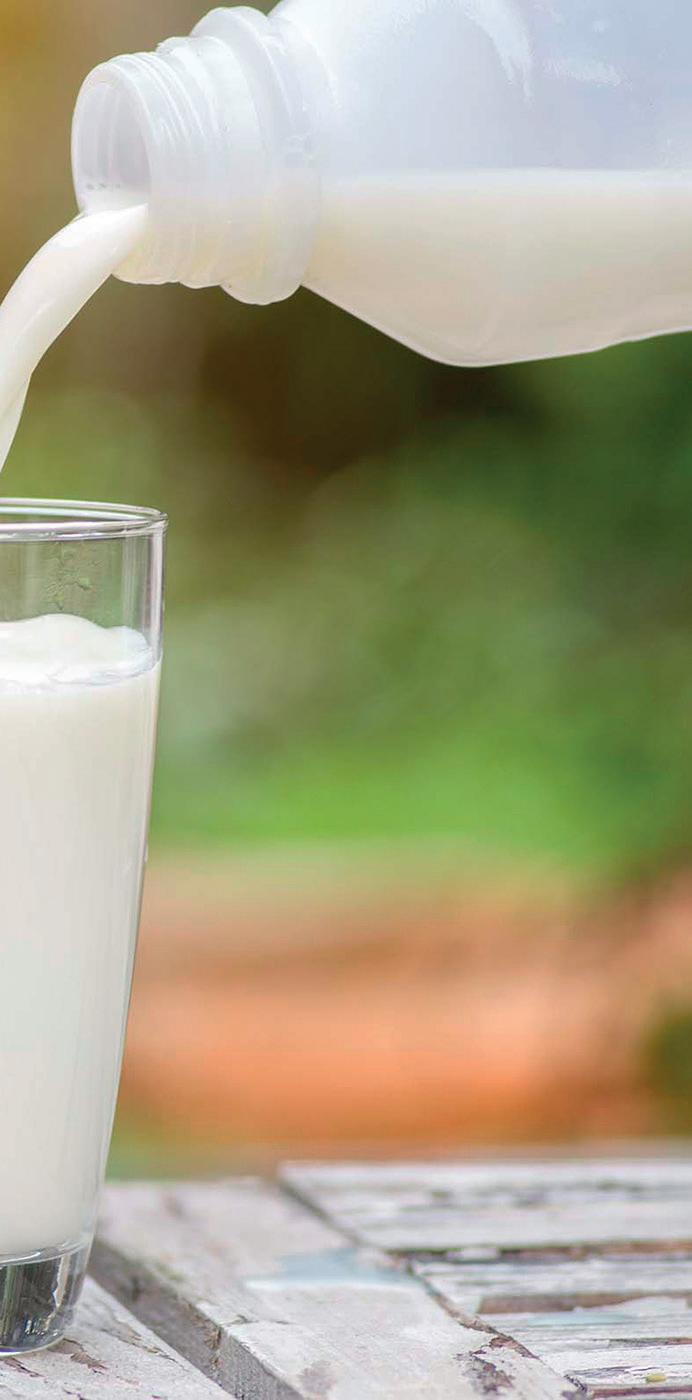

JThe EU butter futures have fallen markedly in recent weeks, and are down by an average of €630 (£528) across the next six months compared to two weeks ago, and by €550 (£461) compared to September, to an average price of €7,129 (£5,972).
The highest price on butter is currently €7,800 (£6,534) for October and the lowest €6,750 (£5,654) for March, thus giving a range of more than €1,000 (£838). A month ago, the highest price was €8,040 (£6,735) and the lowest price €7,275 (£6,094).
New Zealand butter futures are down by €30 (£25) and €250 (£209) over the same respective time period, to an average of €5,736 (£4,805). Thus EU futures are currently 40% higher than New Zealand, but dropping to 15% more by April.
EU SMP futures are down by an average of €50 (£42) across the next six months compared to two weeks ago, and down by €170 (£142) over the month to an average of €2,615 (£2,190).
In Europe, butter and SMP convert in the near term to a price of just under 40p for October (down from a peak of 42p in mid-September), dropping to 36p by March (down from 40.42p). However, most processors should pay a premium over this.













This month, we feature a vaccine proven to protect cattle against Cryptosporidium parvum, a winter-active variety of triticale, nurse tanks from Tramspread and granular feed supplements.
MSD Animal Health has announced it has received Veterinary Medicines Directorate approval for the first vaccine in Great Britain to protect cattle against the highly infectious parasite which causes cryptosporidiosis.
Bovilis Cryptium is indicated for the active immunisation of pregnant heifers and cows to raise antibodies in colostrum against Gp40 of cryptosporidium parvum. The vaccine can provide protection for calves from birth at the start of colostrum feeding.
The primary vaccination course is two doses, four to five weeks apart, in the third trimester of pregnancy, to be completed at

Bovilis Cryptium is indicated for the active immunisation of pregnant heifers and cows to raise antibodies in colostrum.
least three weeks before calving.
Cattle that have had the primary vaccination course only need a single booster dose during subsequent pregnancies.
JTimac Agro UK has launched Spadea Rumen G and Spadea Fix’N G, two micro-granulated mineral supplements formulated to buffer the rumen and enhance the efficiency of feed utilisation.
Spadea Rumen: With the inclusion of yeast and probiotic extracts, Spadea Rumen allows animals to maximise highfibre or acidogenic diets and buffer rumen pH. Trials have shown the product is proven
to increase the digestibility of different types of forage in dairy cows, with digestibility of fibres increasing by up to 11.4%.
Spadea Fix’N: Spadea Fix’N is formulated as a nutritional supplement to slow down the transit of soluble nitrogen through the gut to optimise absorption and therefore protein production, while minimising impact on fertility. Both products are available now through Timac Agro distributors. rDetails on uk.timacagro.com
The protection of calves depends on adequate ingestion of colostrum and transition milk from vaccinated cows.
It is recommended that all
JNew products are featured in each issue of Dairy Farmer. Please send details and pictures to Katie Fallon at katie.fallon@agriconnect.com, or call 07815 003 227.
calves are fed colostrum and transition milk during the first five days of life.
The vaccine can be administered to cattle during late pregnancy at the same time as the Bovilis Rotavec Corona vaccine. Farmers interested in the new vaccine should contact their veterinary professional.
rDetails on 07890 916 752 or ploy.radford@msd.com


JTramspread has launched a new range of nurse tanks, including three different models with holding capacities of 45cu.m, 70cu.m and 90cu.m.
The tanks use an individual hydraulic lift and lower axle design, featuring hydraulic suspension and full air braking, with the wheels recessed into each side, leaving a clear central section.
The new tanks also all use a hydraulically pivoting drawbar, which is especially handy when negotiating uneven gateways
or positioning the tank on undulating terrain.
Generous ground clearance is provided, and the running gear consists of 10-stud wheels with 385/65R22.5 tyres.
Standard specification includes a substantial plexiglass sight gauge, internal and external aluminium access ladders, LED lights, beacon, and reflectors. Prices start from £30,000 plus delivery for the basic 45cu.m model.
rDetails on 01449 766 133 or info@tramspread.co.uk
JA new winter-active and highly vigorous variety of triticale offering the option of early spring grazing, high yield of silage in late April, or wholecrop in late June, is now widely available to UK livestock farmers.
Bred in New Zealand, T101 Wintermax has a recommended drilling window of mid-September through to mid-October for optimum spring production and has been shown in field trials to significantly outyield forage rye.
The variety is an ideal
option to follow maize – it will establish quickly and is winter hardy, so offers good protection against soil erosion.
For farmers looking to fulfil an SAM2 commitment within a Sustainable Farming Incentive agreement, T101 Wintermax can be combined with winter vetch or other fast-establishing species to create an overwinter multi-species cover crop.
T101 Wintermax forage triticale is available from seed merchants throughout the UK.
rDetails on 07496 662 670 or j.francis.dunne@gmail.com.





Tub Grinders
- Exclusive UK Distributor of Haybuster & Rotogrind Grinders.
- Range of models from 5t - 25t / hour output.
- New, used & refurbished machines available.
- Ideal for straw, hay, green waste, roots, biogas feeds etc.
Root Choppers & Cleaners
- Loader, 3 point linkage, free standing PTO and electric drive available
- UK Distributor of VDW range of choppers, cleaners & feed dispensing equipment
- Output from 10t/hour to over 120t/hour available
Diet Feeders
- Largest stock of mixers in the UKover 50 machines in current stock
- Refurbished, used & nearly new units available
- New Mini Mixer available
- Diet feeder parts available- Blades, Conveyor belts, gearboxes, weigh cells.
- All feeders undergo 30 point service
- Finance available subject to terms
- Nationwide delivery available

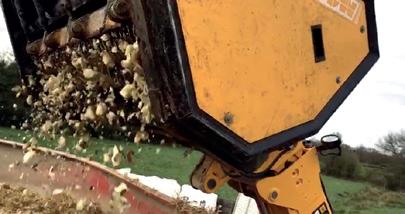

Current Used Stock:
Trioliet 8, 12, 14, 20
Strautmann 14, 20
BvL 15, 17, 20, 24
JF Kongskilde 12,14, 22
Kverneland / Siloking 14, 16,18,22
Keenan 10, 14, 16, 20, 24
Shelbourne 11, 22, CB150 bedder
Hi Spec 14 x 2, 16
Redrock 20
Seko Samaurai 14
Rotogrind x 4
Teagle C12 grinder
Farmhand 880
Profi freestanding root chopper x 3
VDW root bucket RS1800
Breaking for parts -Trioliet 28, Shelbourne 11, 13, 19,
Abbey 1500, Strautmann 1250, Siloking 22,


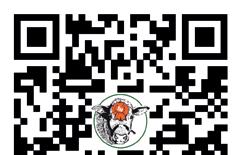





While cattle emissions are generally negative for the environment, ruminant agriculture is a positive contributor to soil health showed by results from a recent SAX report. Jamie Day reports.
The Soil Association Exchange (SAX)
was founded in 2021 to develop a comprehensive, national agricultural data set measuring the environmental impact of farming practices. While SAX is a Soil Association body, its services are available to all farmers, not just organic ones.
“A single, standardised methodology for farm measurement will help all farmers make decisions based upon high-quality, reliable and comparable data, enabling the whole industry to make farm businesses more sustainable – but pro table,” says SAX chief executive Joseph Gridley. He emphasises the need for nancial strength in order to invest in transitional measures.
“Standard data is crucial for the move to more climate-friendly farming,” he says. “Already, government and the food and drink industry are starting to provide nancial incentives for producers to farm more sustainably. Comprehensive, holistic farm-level data is essential to help the transformation.”
e baseline audit assesses the environmental impact of farms across six areas; soil health, biodiversity, animal welfare, water, carbon and social impact. SAX advisers then use the data to create bespoke farm action plans to help implement more sustainable practices and to access new funding streams, supporting the transition to more sustainable farming.
SAX has aggregated the data from the rst 685 farms it has audited, which cover nearly 240,000 hectares (593,052 acres) of UK farmland stretching from Cornwall to the Orkneys, with Lloyds



Banking Group funding surveys on more than 550 of the farms. Of the audited farms, 177 had a dairy enterprise, with 89 of them
solely dairy. On carbon, dairy-only farms scored 48.1 out of 100, the lowest for all the enterprises, although marginally behind dairy and arable at 49.4.
Purely dairy farms had an average soil score of 60 out of 100, second only to beef and sheep at 65.8. Arable farms were lowest at 51.05. On biodiversity, dairy-only scored 50, which was just below arable-only at 52 with arable plus beef and sheep the highest at 62.15.
Dairy only had the third highest animal welfare score at 51.15 –above arable and dairy at 45.8, but below arable and beef at 67.
Mr Gridley says the variance in these scores illustrates the
complexity of farming systems, and the danger of measuring these factors in isolation rather than holistically. For example, the average data shows that dairy and livestock production is ve to 10 times higher in carbon emissions than arable enterprises. But at the same time, livestock integration plays a crucial part in raising soil health scores, earthworm numbers and soil carbon content.
What the data should do is help individual farm businesses to nd the optimum balance between output and environmental impact, based on their particular circumstances, says Mr Gridley.
JRoger and Catherine Howells run a closed 148 pedigree Holstein herd on 142 hectares (350 acres), with a herd average yield of 11,000 litres, supplying Muller on an aligned contract. The cows are grazed from May to the autumn and calve all year round.
The Howells have carried out sustainability audits with Muller over the past five years but wanted to develop their understanding of soil health.
Soil testing is already carried out to create a bespoke prescription for each field and low-emission slurry equipment is used to reduce ammonia emissions. Careful management ensures heifers first calve at 24 months, while the herd has excellent fertility.
All these factors have helped lower the herd’s carbon footprint to 1.06kg
of CO2 equivalent per litre of milk, compared to the national average of 1.2kg CO2e/litre.
However, a recent TB outbreak has led to the business carrying double the number of youngstock than normal, to replace the animals lost to the disease. In turn, this has increased the average methane emissions with a consequent rise to 1.27kg CO2e/litre.
The SAX baselining audit found the low levels of disease on the Howells’ farm contributed to high animal welfare scores. Soil structure was excellent, while the farm’s dense, well-managed hedgerows act as wildlife corridors.
However, low worm counts were observed, while the pH needs to be raised to the optimum pH 6.5 on some fields to improve fertiliser efficiency.

The audit recommended the introduction of clover into leys to reduce nitrogen fertiliser need and improve forage quality, while the use of deeper-rooting grasses and legumes would increase soil organic matter and carbon. In addition, applying more farmyard manure to low index phosphate and potash fields would also reduce the reliance on artificial fertilisers.











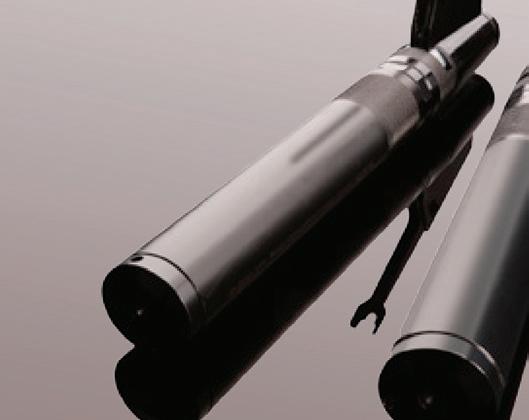












This month, Roger Evans discusses milk, the price of corgis, and regales us with a tale of what happened at the bar after a friend’s herd sale.
We have bought shop milk for years. When we did bed and breakfast it was always safer to serve pasteurised milk to our guests and there was always bovine TB lurking about.
That isn’t to say that the odd jug straight from the tank didn’t find its way into the fridge.
We don’t do B&B anymore, there’s just the two of us. My wife never drinks milk, she had TB in her ankles when she was a little girl and spent several years in hospital. The source of TB was a cow that they had milked by hand for the house.
We still buy milk just for me. I only eat cereal in the summer and, as we all know, summer hasn’t arrived just yet. So it’s just me and me only who drinks milk in my tea.
But this year I have noticed that milk doesn’t last as long. Sometimes you can open a new container, put some in your tea and it has a bit of a ‘taste’ to it.
The best milk we buy is Cravendale. It’s a bit more expensive, but the most expensive of all is the milk you have to throw away because it’s gone off.
We rely on processors to look after and market our product; it could be that they need to up their game.
One thing about modern day communications, Google and the like, its that you can find things out so easily. I’ve always had a weakness for dogs. I’ve got other weaknesses, but this is one I can tell you about.
Over the years I’ve had lots of dogs. These have always been in three categories: dogs to work livestock; dogs to work with the gun; and pets. I don’t do much with the first two so my interest now is mostly with pets.
In my experience, if you had a good working dog it would have an untimely death, run over for example. But if you bought a pup to grow into a working dog it would die of old age if it was no good and hang about the yard forever.
Getting a good working dog was a bit like winning the lottery, it seldom happened. I’ve always had a soft spot for corgis and over the years we’ve had lots, but the pandemic took them out of my price range. Recently it was my wife’s birthday, I didn’t have a clue what to buy her so I thought I’d have a look to see how much corgi pups were. Just to put this story into context, the first corgi we had cost £10. He was a nasty little sod, he lived under the kitchen table and if you moved your feet he would bite you on the ankle. As our son was just a toddler and we were afraid the dog would bite his face, we gave the dog away.
Anyway I’m looking on Google for corgi pups and I find a dog pup that’s £1,500 and a litter that’s £1,700 and a bitch puppy that’s £2,000. The litter looks as if there’s some sheepdog in their ancestry somewhere. Just imagine buying a corgi pup and discovering there was a sheepdog in its ‘pedigree’. You wouldn’t find out until you had got fond of it

“ If you bought a pup to grow into a working dog it would die of old age if it was no good and hang about the yard forever
and it had become one of the family. All of these are out of my price range, I would never pay that much for a pet.
I wonder how much a kilo that is.
So there’s a group of us, all family, having a bar meal at the pub. A bit extravagant I know but it’s to celebrate the birthday I mentioned previously. And it’s not as expensive as buying a corgi.
Anyway, we are at the pub and we start reminiscing. Years ago a friend of ours was selling his pedigree milking herd. Two of us went to the sale. We didn’t want any cows, we just went to support him.
It was a good sale and a erwards we spent an hour helping to load lorries and trailers. e bar was still open and later on a party developed.
We partied quite hard for a couple of hours but when it was time to go, we decided it was best not to drive. So we phoned my daughter to fetch us and continued at the bar. She came straight away and joined us at the bar. A er an hour we decided it was


no longer safe for her to drive so we phoned my wife to fetch us.
Next day there were two vehicles to fetch and the bollocking we had lasted 24 hours.
Over recent years, I’ve developed an interest in politics. It seems that currently it is the common practice to criticise the Prime Minister. I used to say that the only good thing you could say about Keir Starmer was that he wasn’t Jeremy Corbyn. e one thing we can be sure of with politicians is that they all fancy the top job. ose that fancy the top job now are more le wing than the Prime Minister, so be careful what you wish for.
Whether you like it or not, the political die is cast in this country for ve years and the only politics I have to look forward to is the presidential election in the USA.
at’s quite sad really.


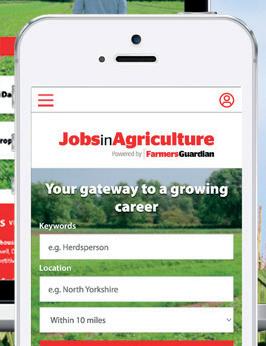




Lower milk production has given support to milk prices. But what are the prospects for the UK and beyond in the next few months? Cedric Porter reports.
Milk production in the rst ve months of the milk year from April 2024 to March 2025 was at 5.249 billion litres, according to AHDB gures. at was 1.1% less than in the same period in 2023/24. Production in each of the ve months was lower than the corresponding one last season. e volumes might not seem much, but in a nely balanced market, any change makes a di erence.
AHDB has also forecast output for the nal seven months of the year. While lower output is expected for the September to December 2024 period, a recovery is forecast in the rst three months of 2025. at would take 12-month production to the end of March to 12.283bn litres, which would be 0.3% less than in the 2023/24 season.
at recovery is expected to continue into the 2025/26 season.
AHDB expects production in the March 2025 to August 2025 period to be at 5.320bn litres, 1.3% more than in the same ve months this year and a li le more than in 2023. An increase in output is not
guaranteed, according to senior AHDB dairy analyst Soumya Behera, who says: “We are expecting production to improve from January onwards, assuming a more normal winter. However, grass quality is varied across regions.
“ e grass growth is currently lagging behind last year and the ve-year average. In certain areas, the protein content in grass has been below the average level of 20%.”
e AHDB forecasts are also based on the assumption of be er spring weather conditions than this year. Given that many parts of the
UK experienced one of their we est Septembers on record, there will be plenty of fears about a repeat of the 2024 wet and cold spring.
One plus for producers is a drop in feed prices on the back of lower grain values, which might make producing extra litres more a ordable than in the last two years.
If milk production is to increase, then it is likely to come from increased yields rather than a larger herd. At the beginning of July, the GB milking herd stood at
1.61 million head, a drop of 0.3% on the year before, but the smallest number on record.
e herd did get younger, driven by a 2.1% increase in the number of ca le between two and four years old, with a reduction in the number of older ca le.
However, the number of youngstock below two years was down by 2.7%, which suggests further pressure on the herd in coming seasons.
Other data from Defra shows the UK dairy herd at an all-time low of 1.836m head in June 2023, 45% smaller than its peak in 1983.
e pressure on UK milk production is important, but equally important is what is happening elsewhere, especially Ireland. In the year to July, Irish production fell by 6.8% to 8.178bn litres, as producers responded to new environmental regulations, poor weather and a plunge in milk prices. e rapid drop in production has sent alarm bells ringing about the future of the country’s largest agricultural sector. Keith O’Boyle, chair of the Irish Farmers Association’s liquid milk
committee, says: “Poor weather conditions compounded by high production costs have exposed the vulnerability of the fresh milk sector, which is now at a critical juncture.
“Up to now, increased herd sizes and increased yields per cow have sustained supply despite falling numbers of suppliers, but we have reached the end of the road. Without an increase in the retail price of milk, we can no longer afford to continue with a year-round milk production model.”
Latest prices for Irish dairy producers are in the range of €0.45-€0.48/ litre (38-40ppl). Most UK producers are now getting in excess of 42ppl.
Meanwhile, EU milk production has not increased over the last year, with Dutch output down 1.7% and any expansion taking place in the east of the union.
AHDB’s analysis of milk production in the main regions of the world that export dairy products showed a 0.6% drop in output in the year to the end of July 2024 (the analysis includes Argentina, Australia, the EU, New Zealand, the US and the UK).
In July itself, only Australia and New Zealand delivered more milk than in July 2023, with New Zealand seeing a 0.6% drop in production in the last year.
Rabobank says that the decline in production in the big seven dairy areas that it monitors (it drops the UK but adds Brazil and Uruguay) has been under pressure for some time.
Analysis from Rabobank says:
“Over the past three years, milk supply growth from the big seven exporting regions has been inconsistent, with only three quarters since the second half of 2021 recording positive milk production growth.
“Factors like unpredictable weather, fewer cattle, and high feed costs have contributed to this struggle. However, recent improvements in milk prices and cheaper feed have boosted farmer sentiment and margins.
“We expect supply from the ‘big seven’ milk-producing regions to increase modestly over the second half of 2024, with 0.14% year-on-year growth forecast for the entire year. We project a 0.65% year-on-year supply increase for 2025, potentially surpassing the five-year average.”
A drop in Chinese production is also expected by Rabobank, but so is demand, which could reduce its imports for 2024 by 12%, which would impact the big exporters.
UK dairy demand has held steady over the last year, with some categories doing better than others. In the year to September 7, retail milk sales were down 1.8% by volume, according to data from market researchers Neilsen for AHDB.
There was also a 1.1% drop in butter and spread demand, but yoghurt and fromage frais sales were up 6.4% (leading to a 31% increase in imports of such products in the first seven months of 2024).
Cheese sales were up 1.2% by volume over the year, while cream demand was up 2.6%.










Dairy farming is a demanding sector, so how should employees maximise their chances of success and advancement in their jobs? Dairy Farmer reports.
Professionalism, respect, and inclusivity are important factors in any job, says Paul Harris, chief executive at recruitment and retention specialist REAL Success.
He says that excelling in dairy farming requires a blend of technical skills, personal integrity, and interpersonal understanding, and he highlights 10 principles that employees should strive to adhere to.
“By adhering to these 10 principles, you demonstrate your value as a team member who is skilled, reliable and deeply commi ed to the well-being of the animals and the people on-farm,” says Mr Harris.
“ is approach secures your position and paves the way for future opportunities and advancements within the agricultural sector.”
Punctuality is the foundation of trust, and in dairy farming, timing is everything – from milking times to feeding schedules. Mr Harris says arriving on time ensures that these critical activities happen when needed, which is essential for the health and productivity of the cows.
“Your punctuality builds trust with your employers and shows that you value and respect the farm’s operations,” says Mr Harris.
Dairy farming is constantly evolving, with new practices in animal health, milk production e ciency, and sustainability.
“Show your willingness to learn and adapt to new methods, technologies, and research. is not only








improves the farm’s output but also your own skills and career prospects,” says Mr Harris.
Dairy farms operate under a variety of conditions which can change rapidly.
Mr Harris says being adaptable means you are ready to handle unexpected situations or emergencies, which is a crucial trait when dealing with live animals and perishable products.
Taking the initiative on a dairy farm could mean noticing health issues in cows before they become severe, or addressing a potential equipment malfunction, says Mr Harris.
“Proactivity in these scenarios can save time and resources and prevent losses, highlighting your critical role on-farm,” he adds.
Working on a dairy farm o en involves coordinating with others in
close quarters and sometimes under stressful conditions. E ective communication and supportive teamwork make the work more e cient and enjoyable for everyone.
Adhering to safety protocols is essential, especially when handling large animals and operating machinery.
“A commitment to safety shows that you care about your well-being as well as your colleagues,” says Mr Harris.
Completing tasks with diligence and accepting responsibility for the outcomes are good qualities for any employee.
Mr Harris says: “ is accountability shows that you take your role seriously and are a reliable team member.”
Respectful interaction is vital in any workplace. In dairy farming, where the days can be long and demanding, communicating
respectfully is essential. ere is a need to understand that ‘banter’ for some might feel like ‘bullying’ to others. Employees should promote a culture where everyone feels respected and valued.
Everyone should recognise and embrace gender and other forms of diversity on-farm. Diverse teams bring various perspectives that can lead to improved problem-solving and innovation, says Mr Harris. He adds: “Show respect for all colleagues, regardless of background, and learn from the di erent experiences they bring to the farm.”
A deep respect for the livestock is central to dairy farming. is involves more than just meeting basic needs, says Mr Harris. It is about understanding their behaviour, recognising signs of distress, and ensuring a high standard of care.
“Your commitment to animal welfare a ects productivity and re ects on the farm’s ethical standards,” he adds.






























































































Finance for Farms provide a wide range of agricultural finance solutions to support business growth, including Business Loans, Hire Purchase and flexible Seasonal Leases. With simple applications and same day decisions, we help farmers invest in a wide range of assets whilst spreading costs for up to 5 years.
